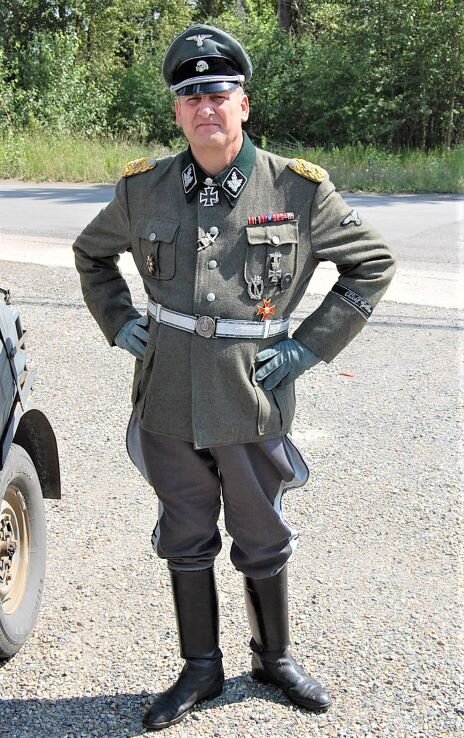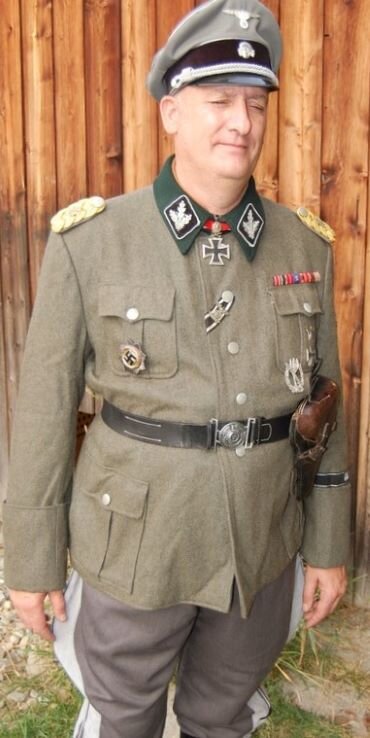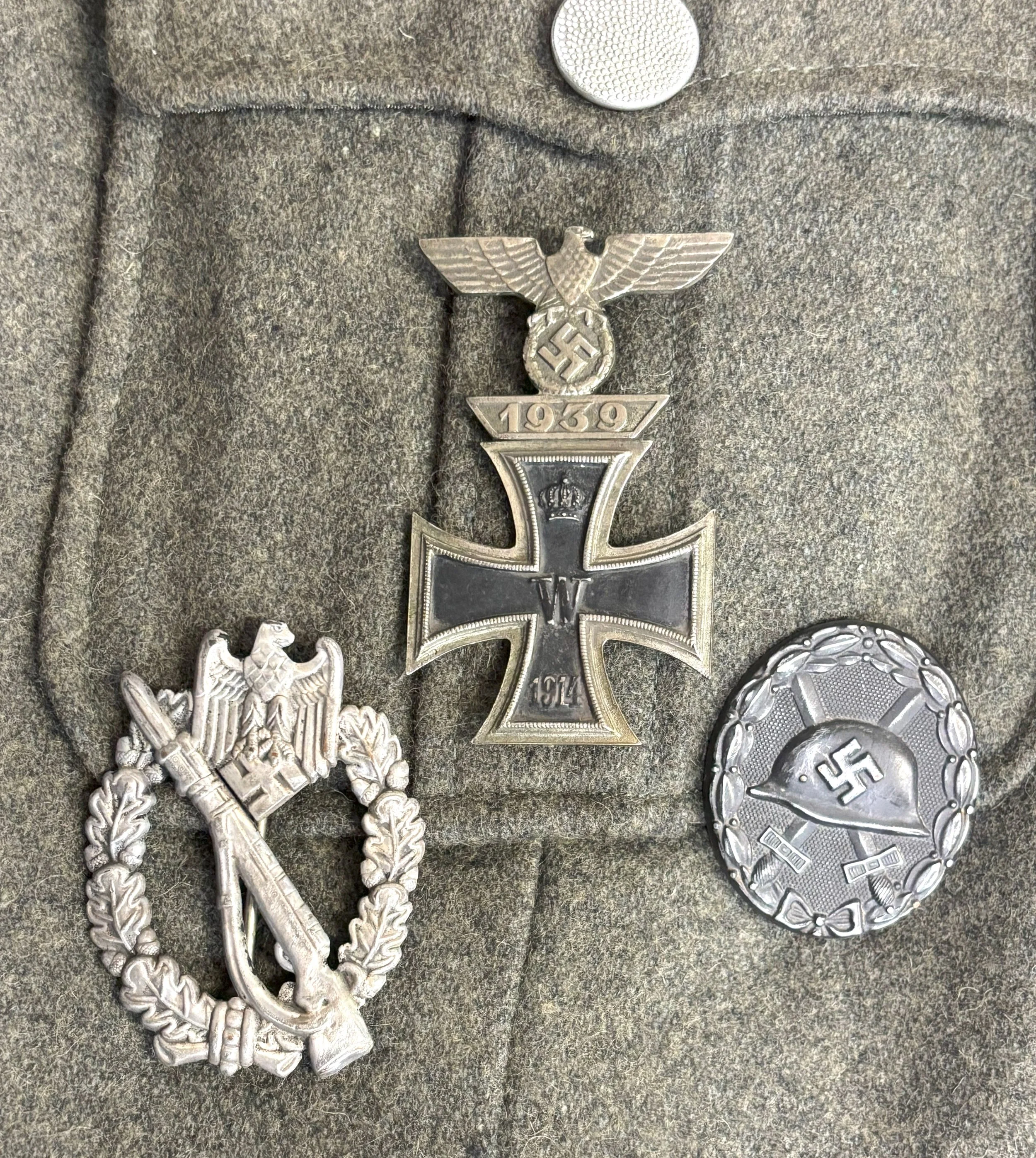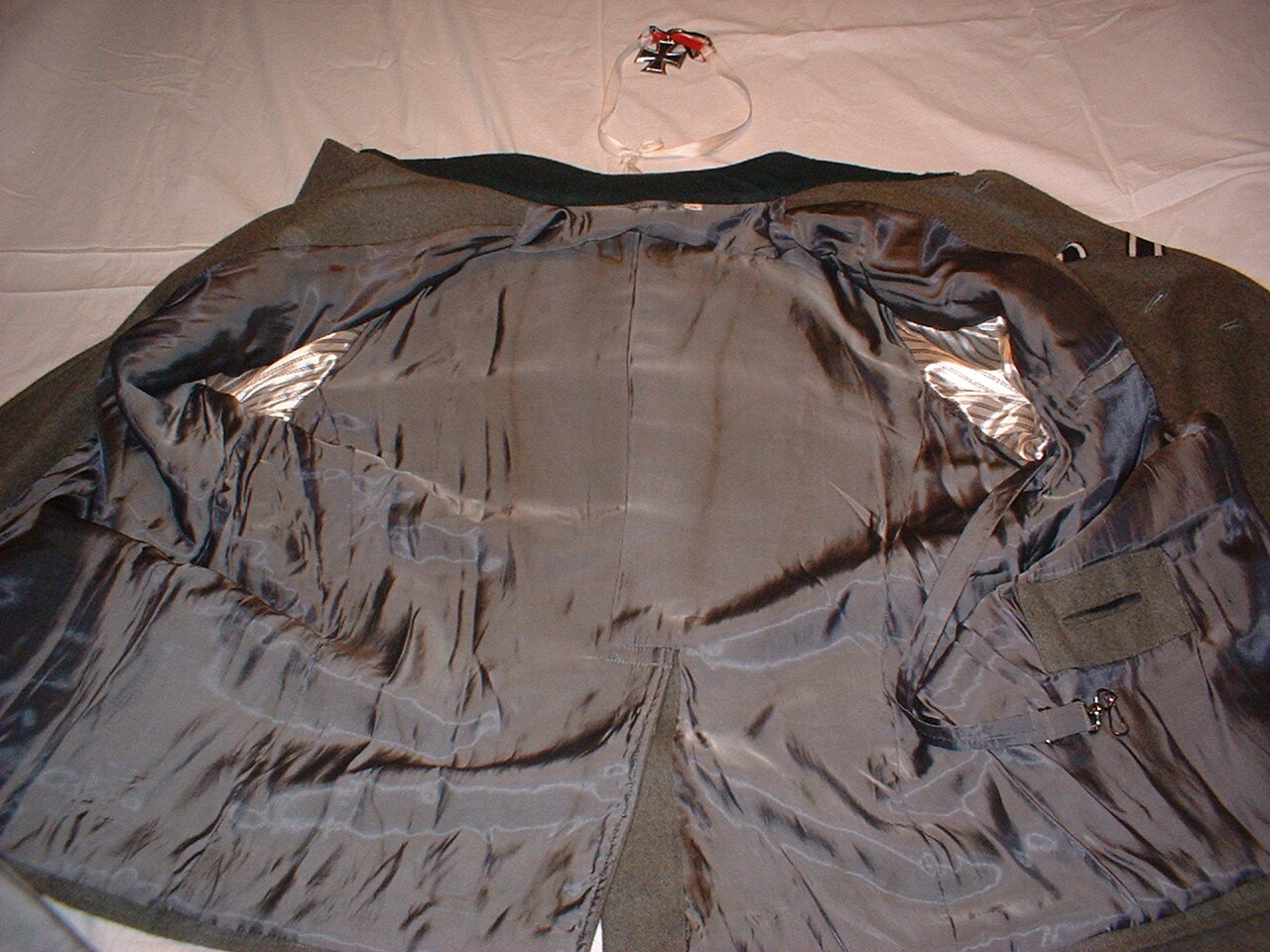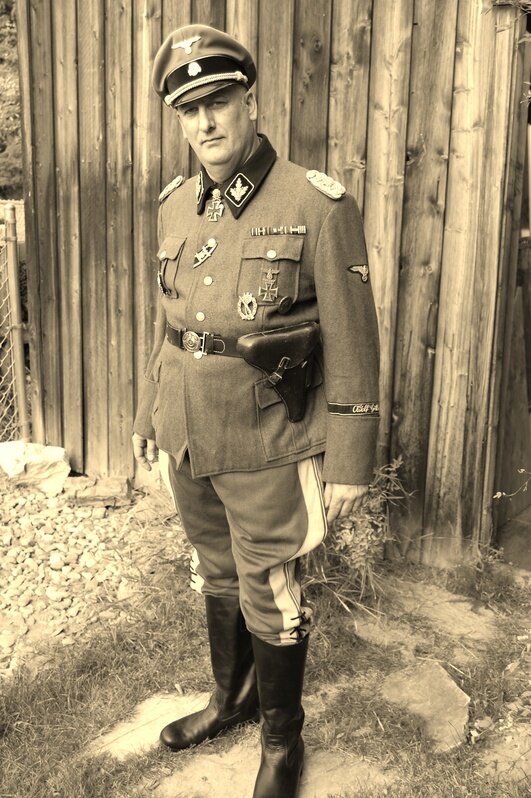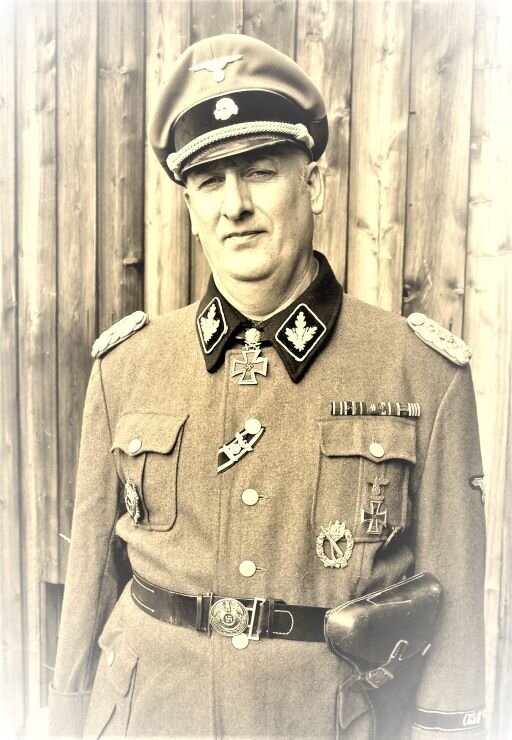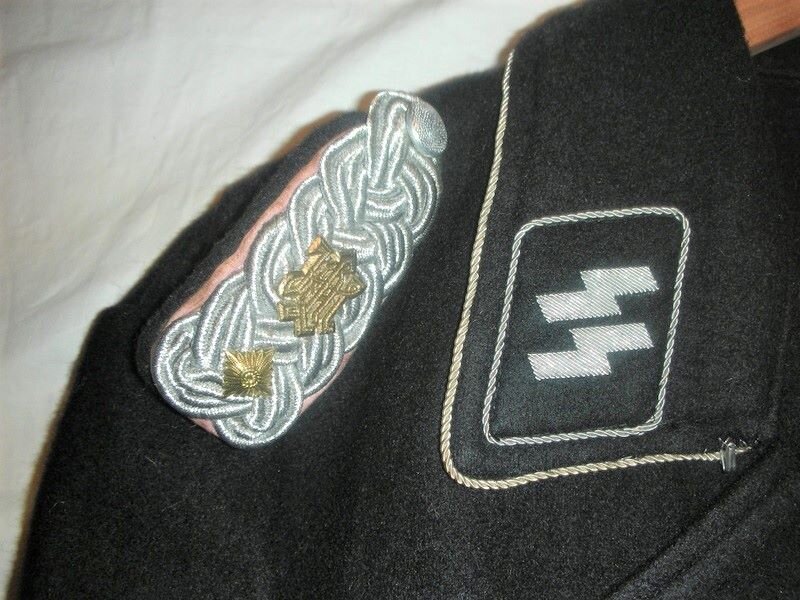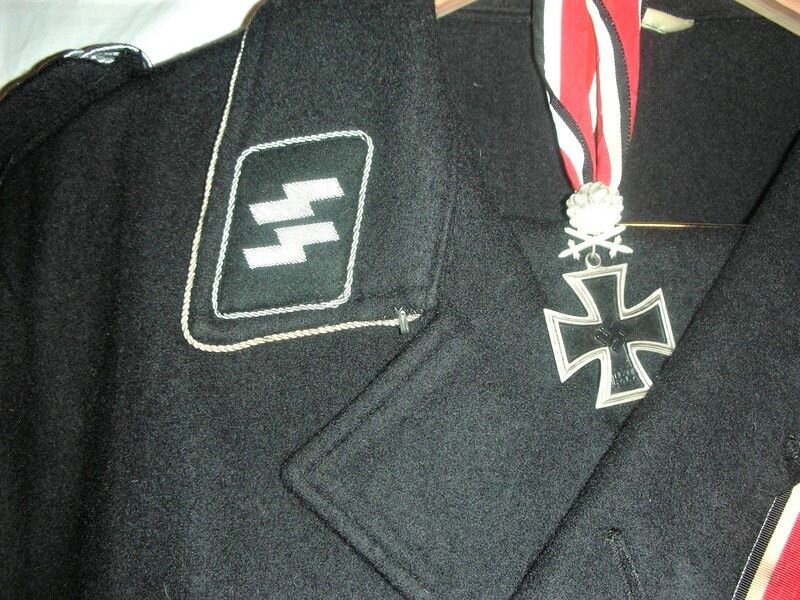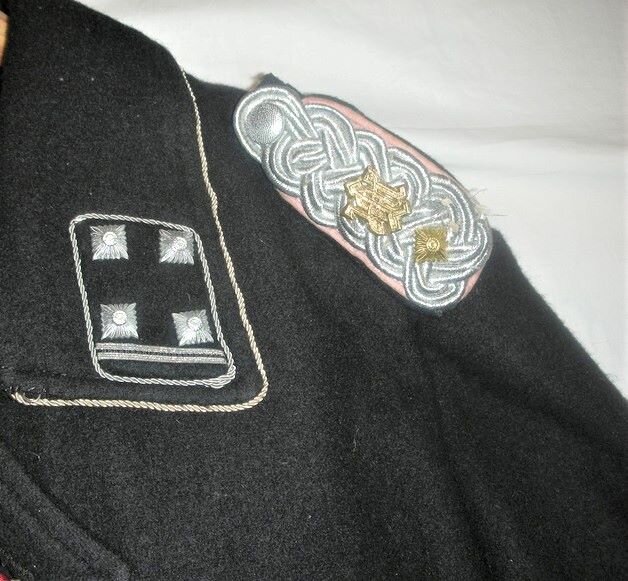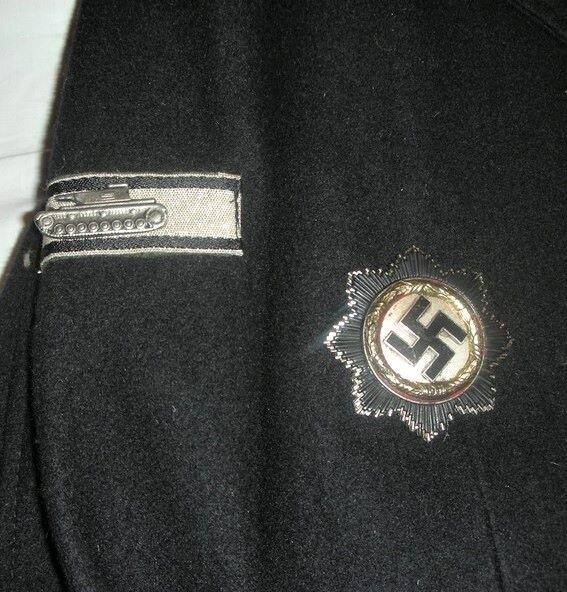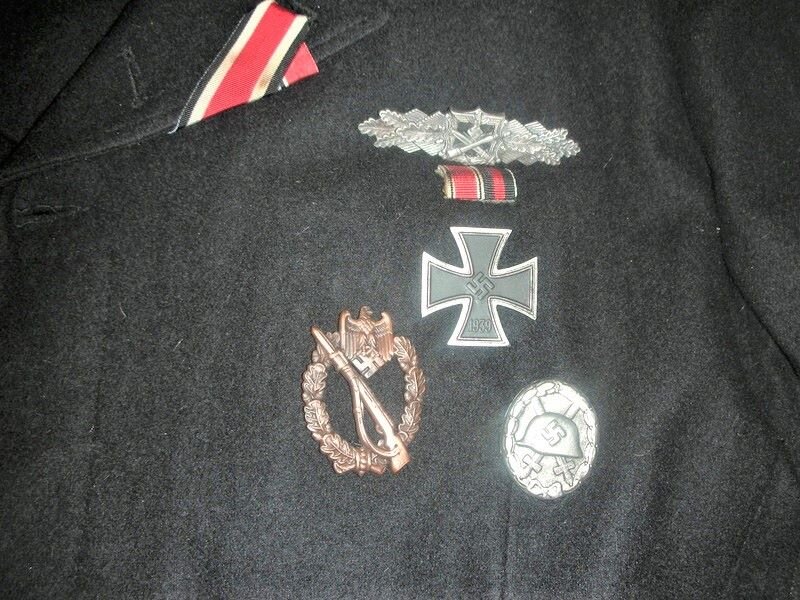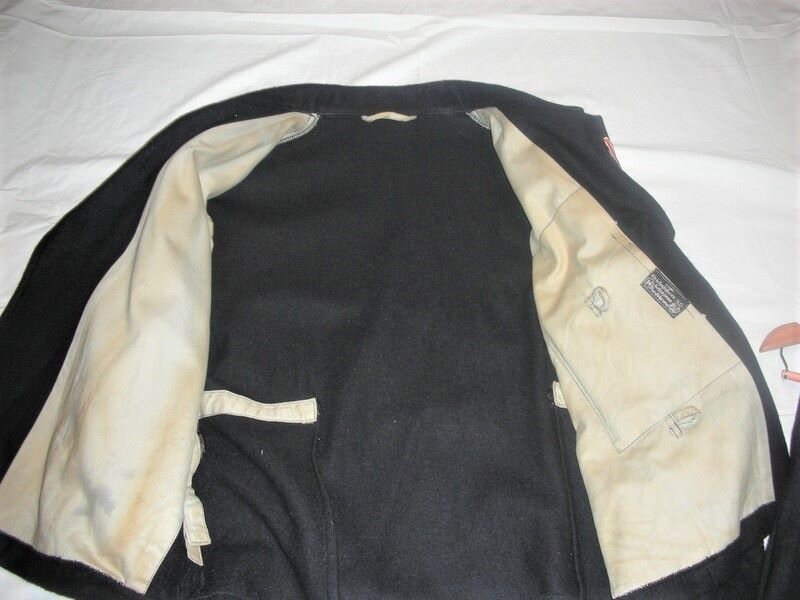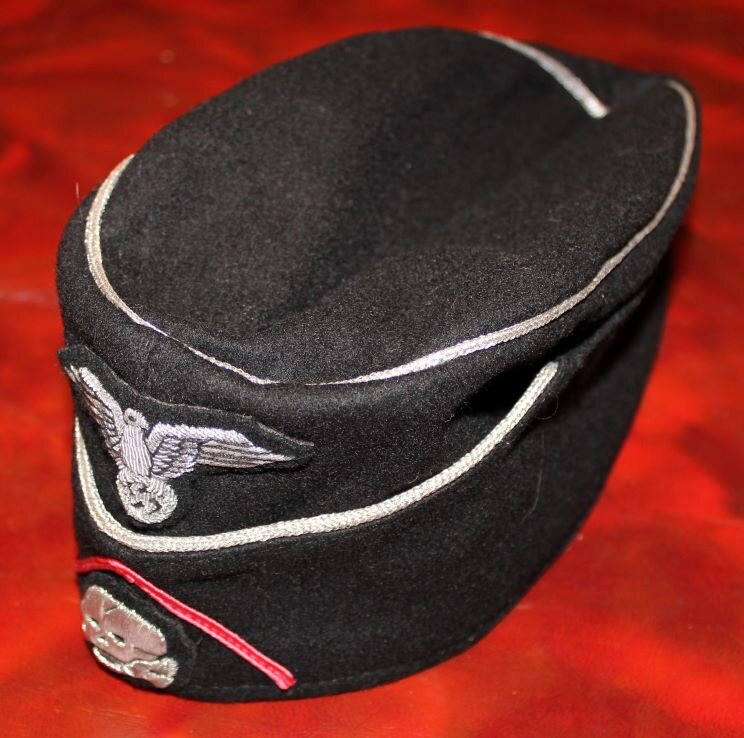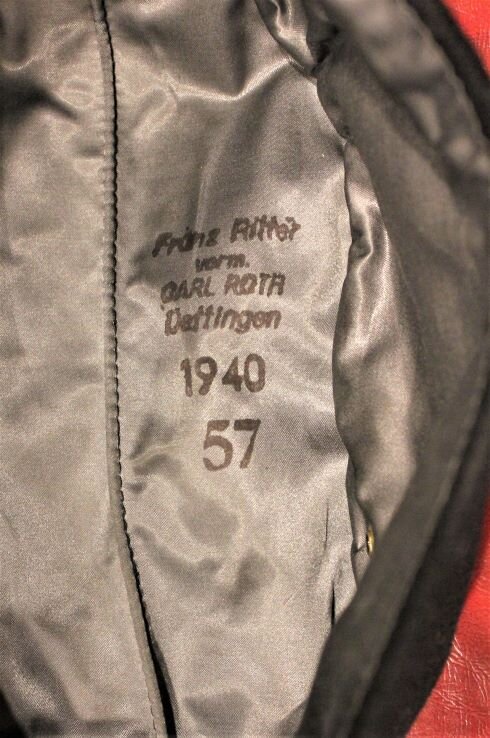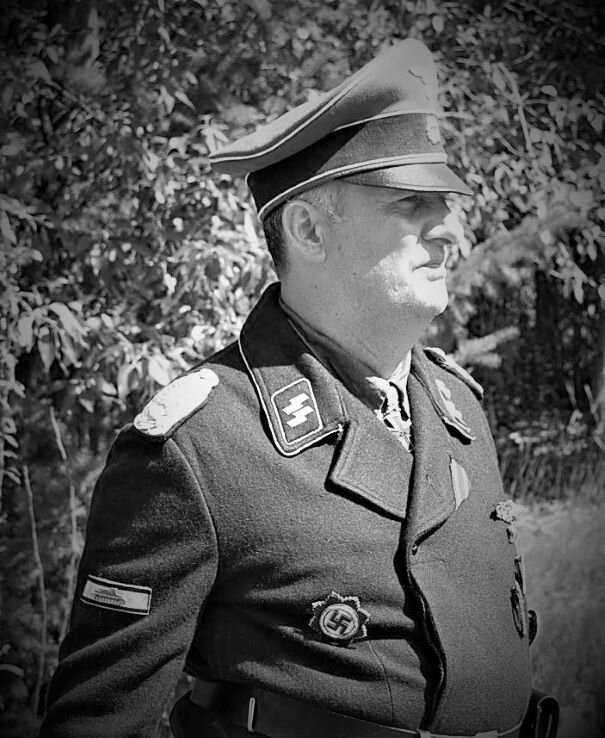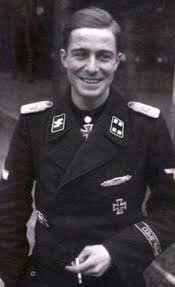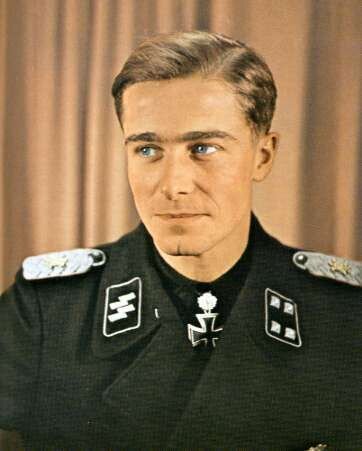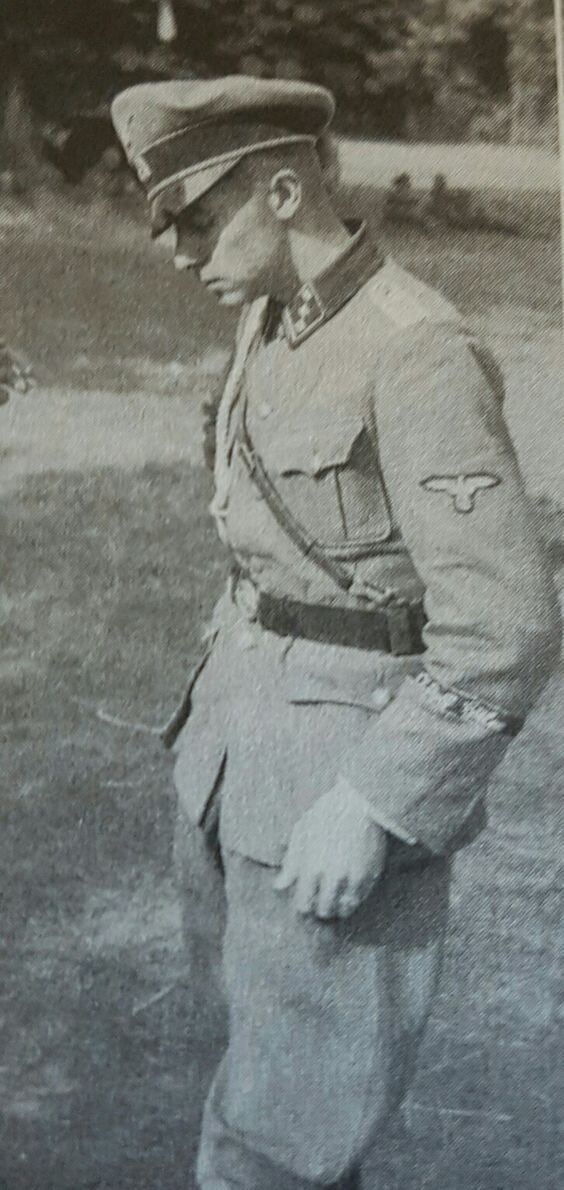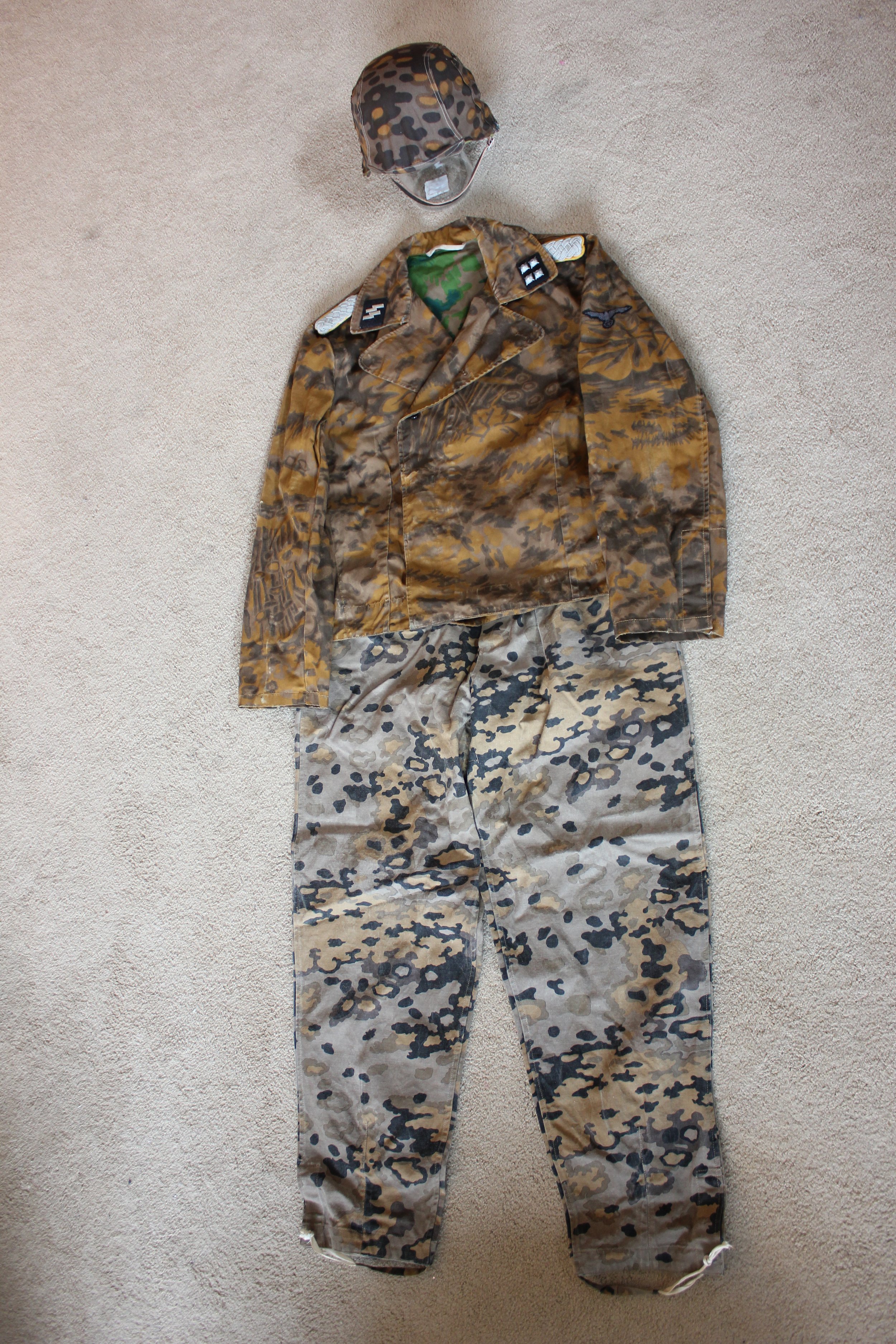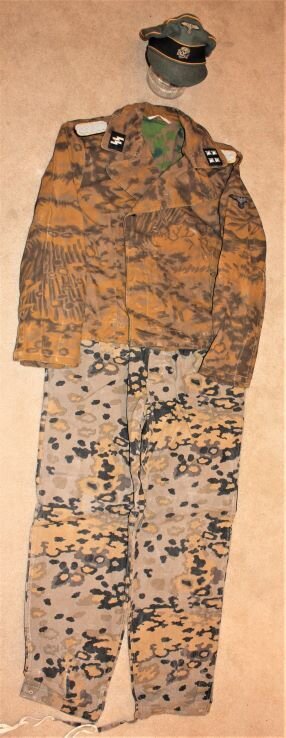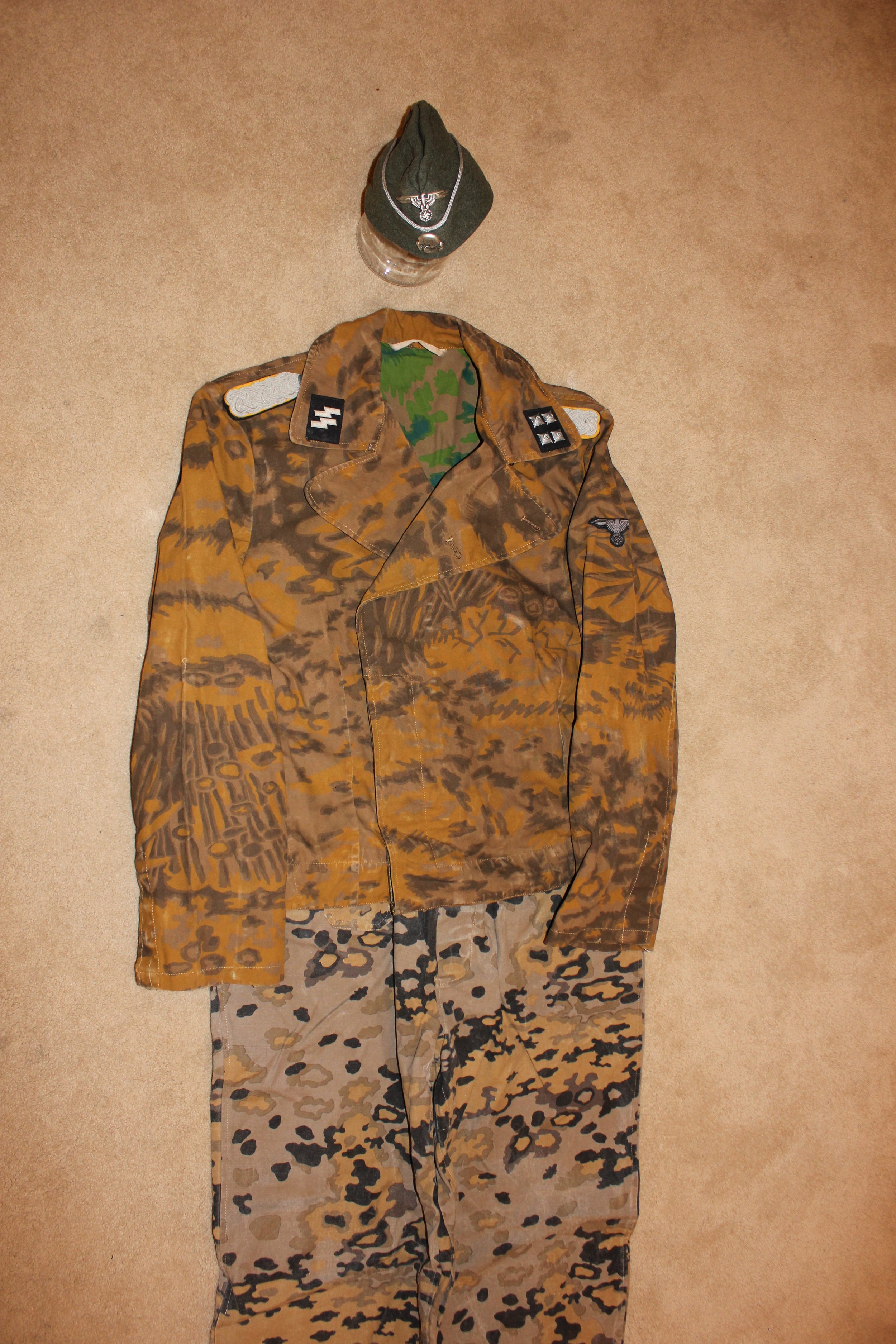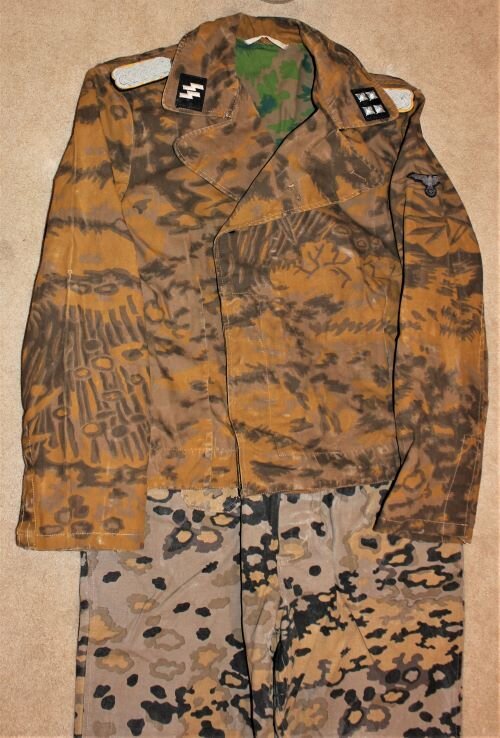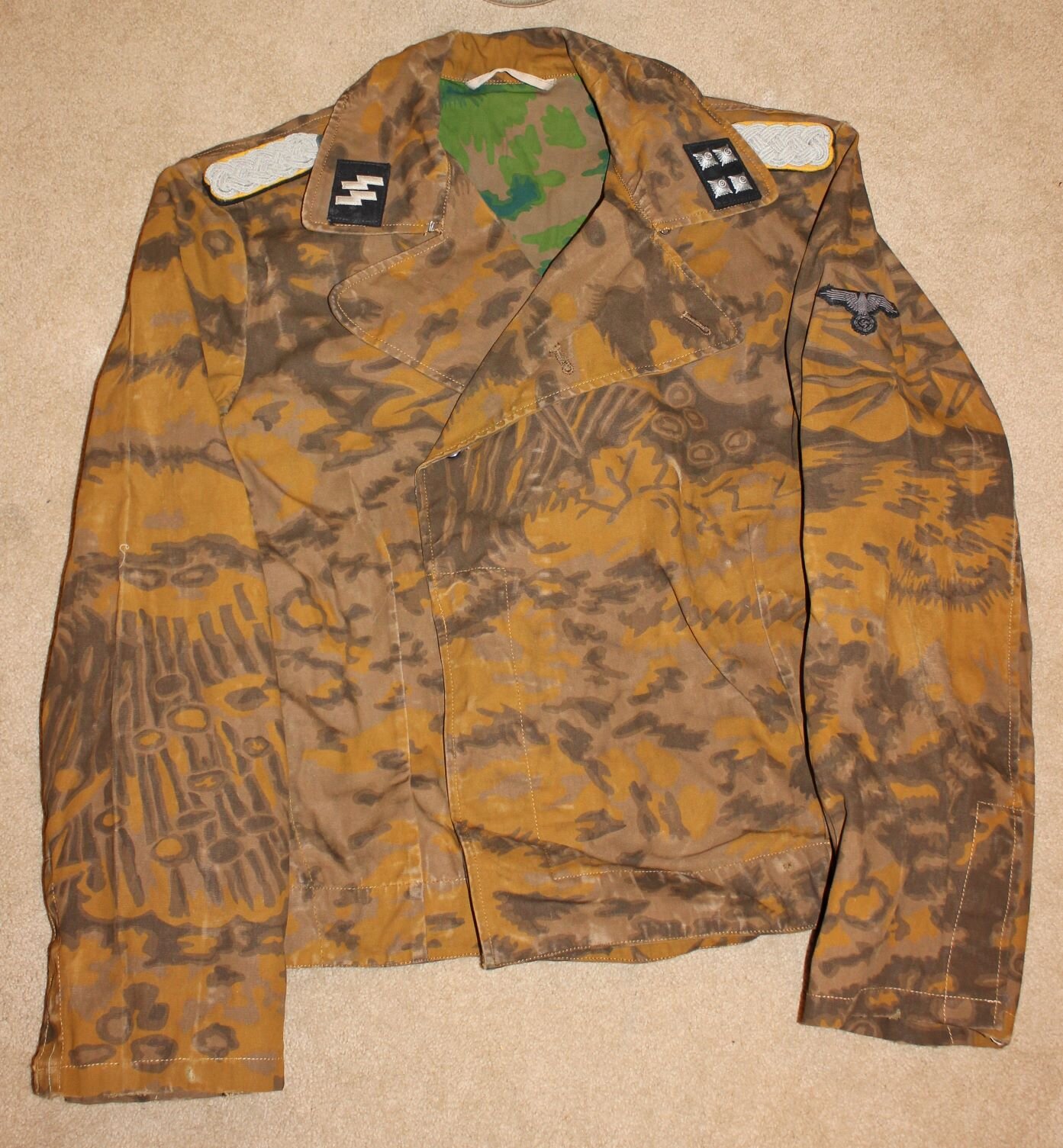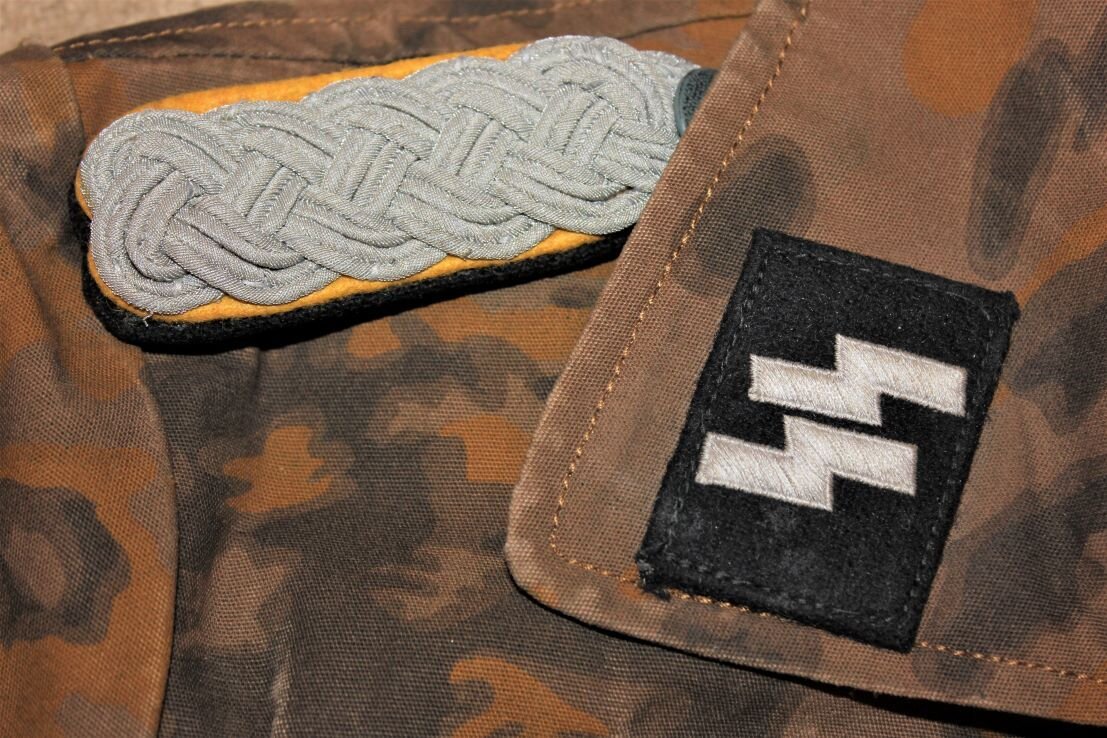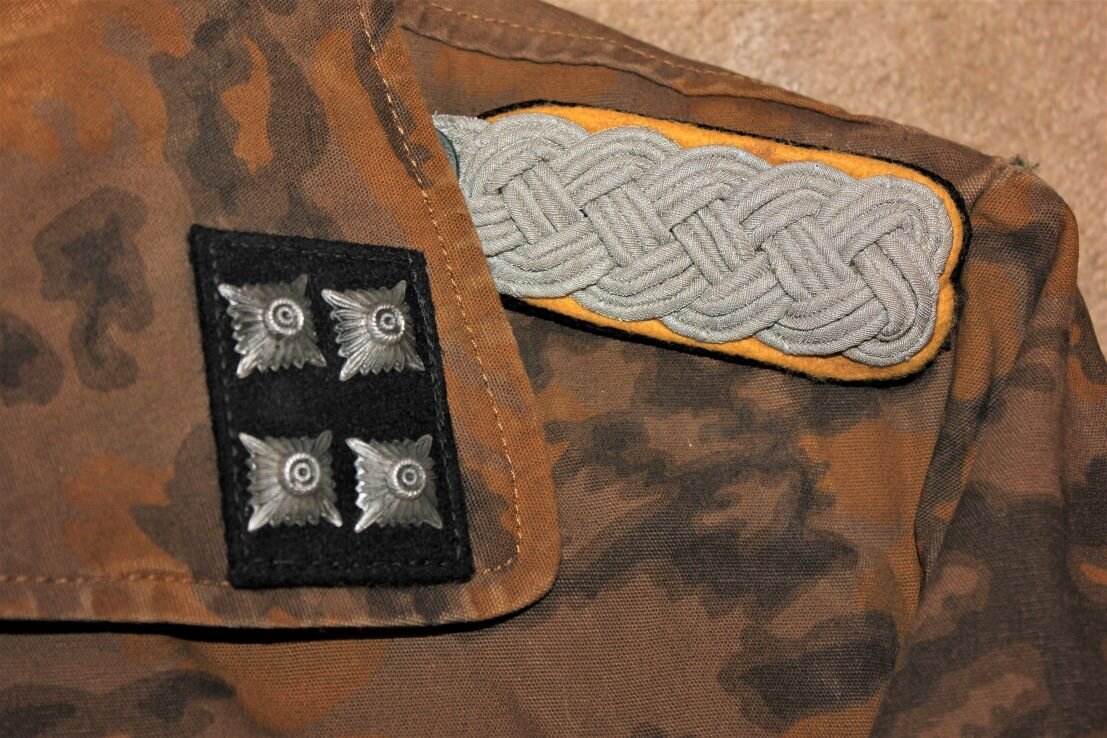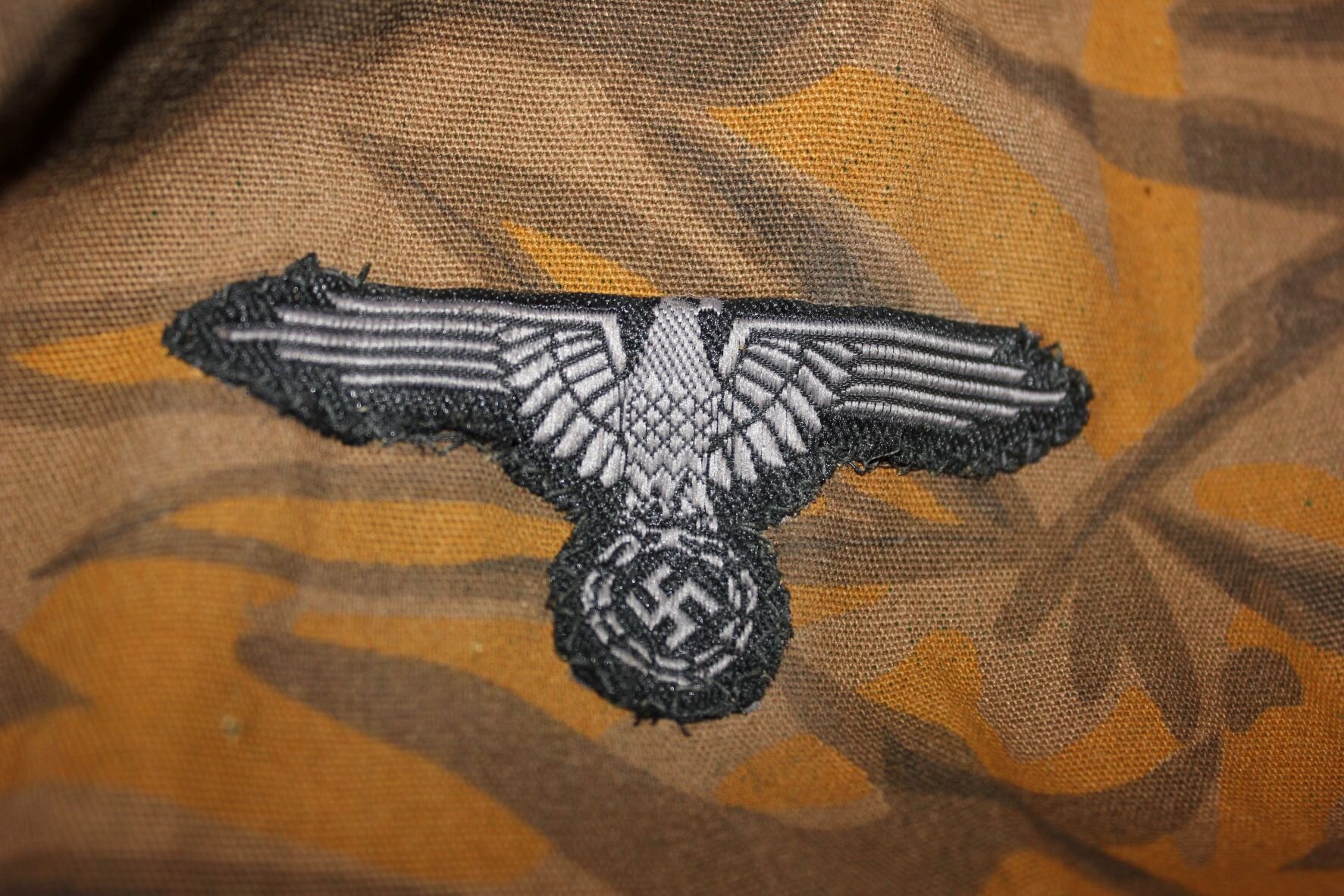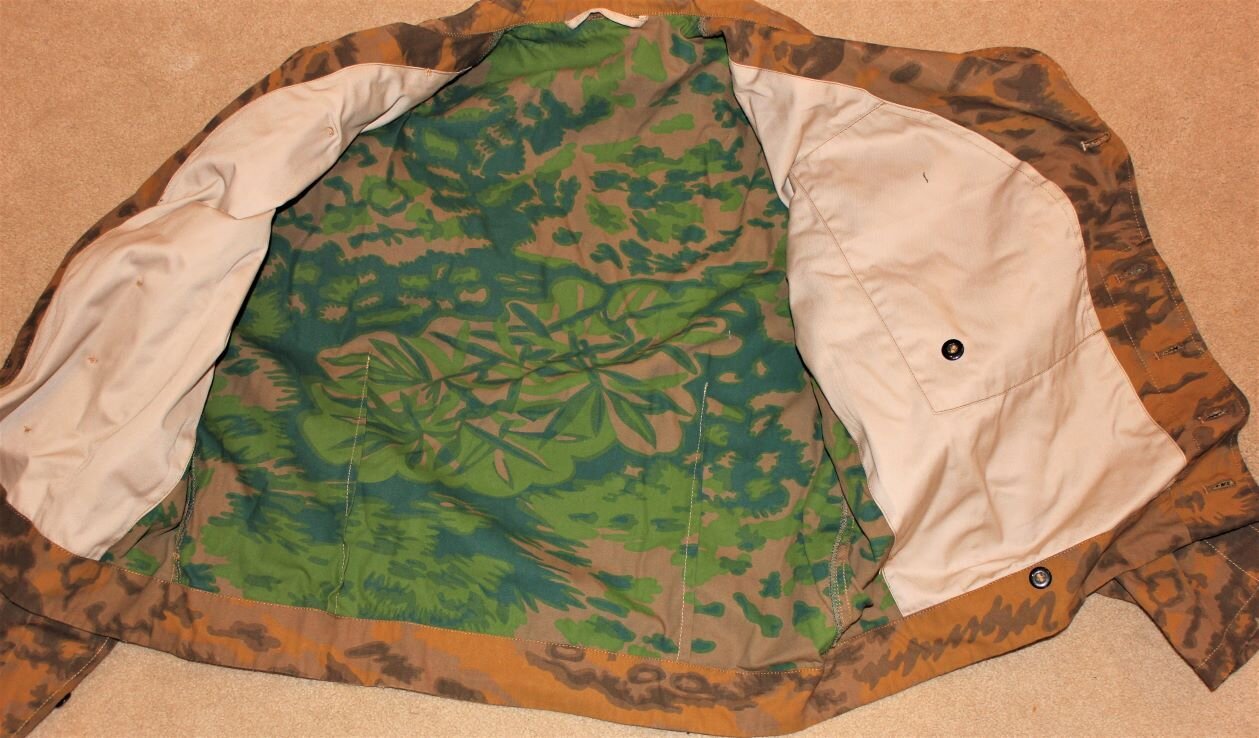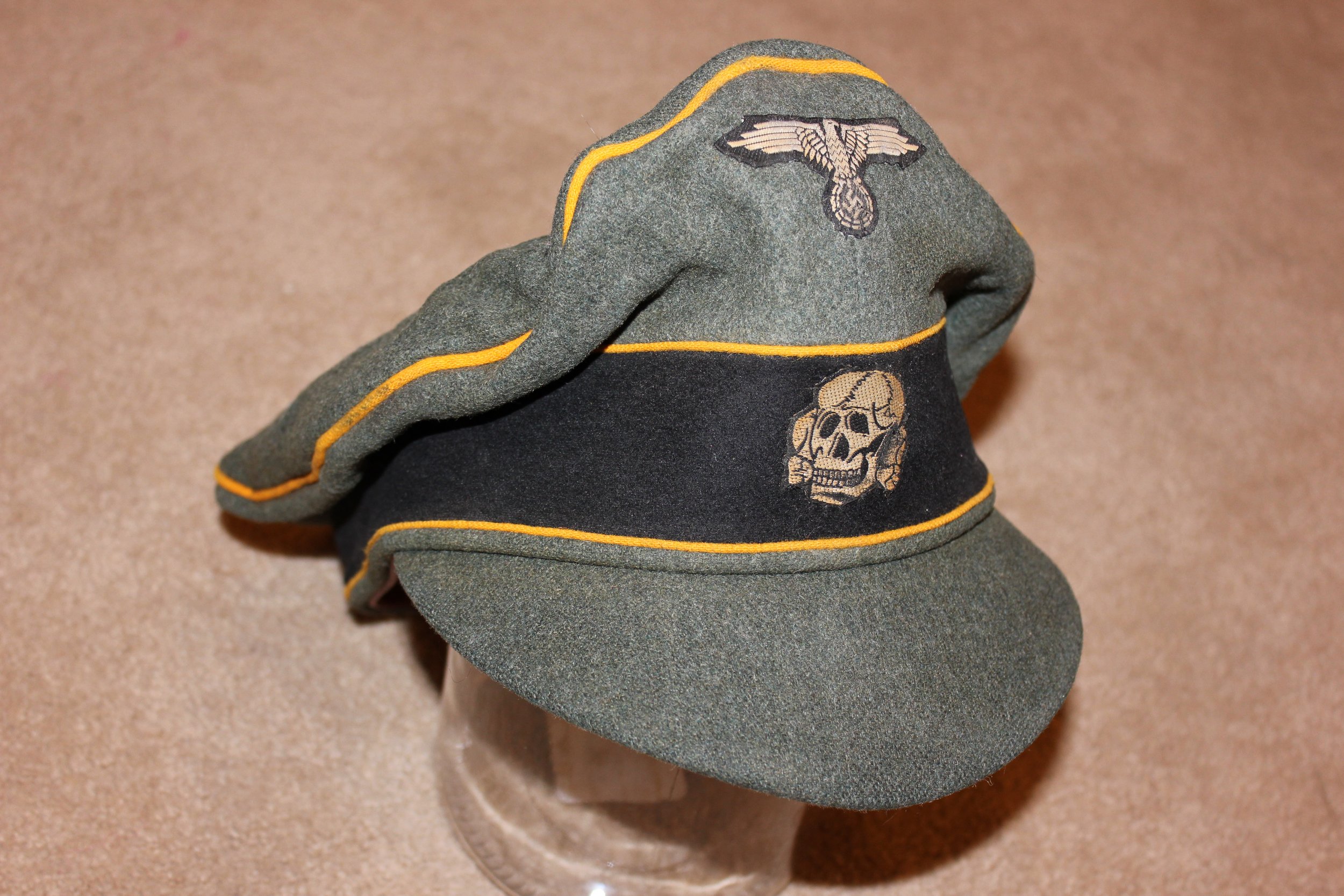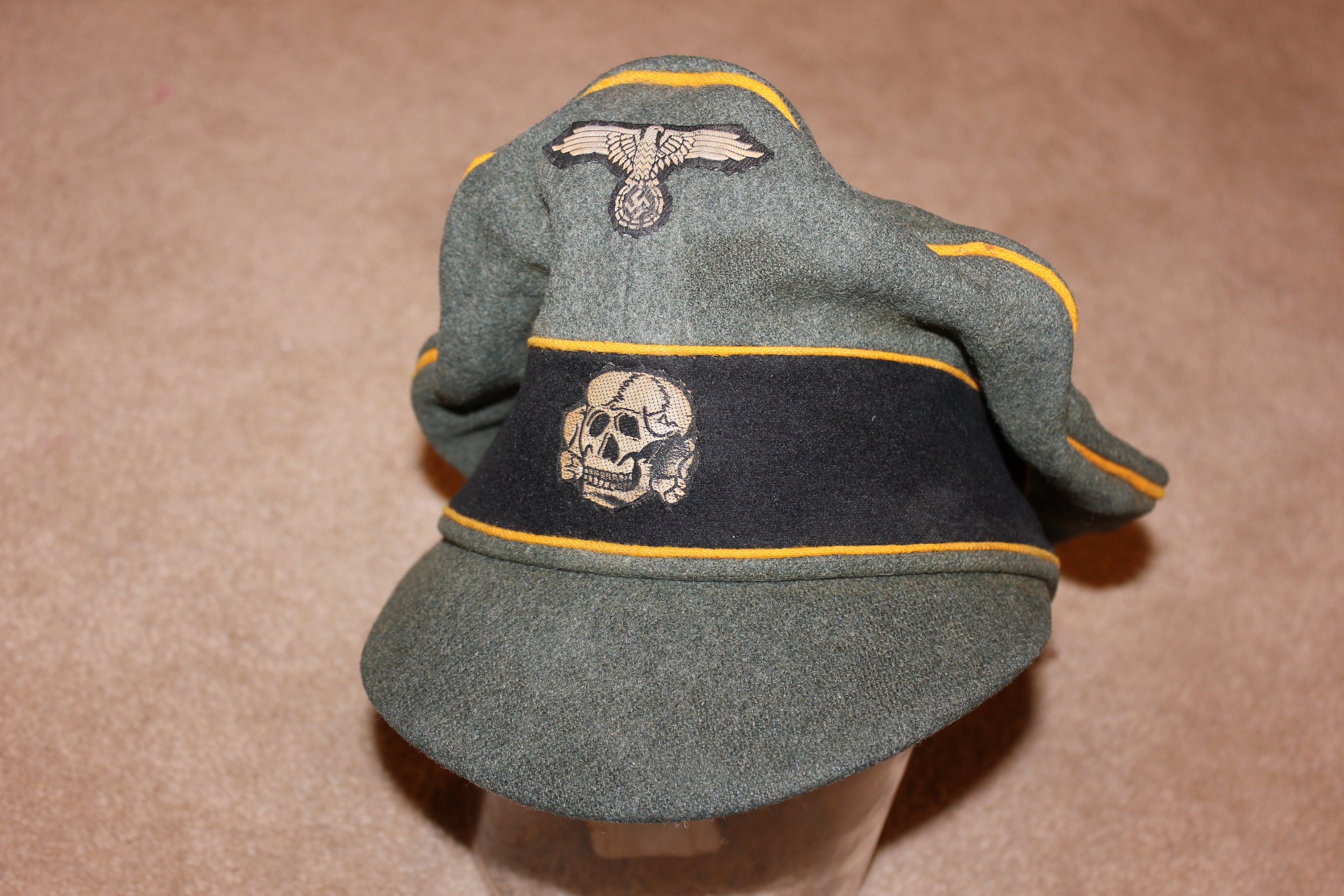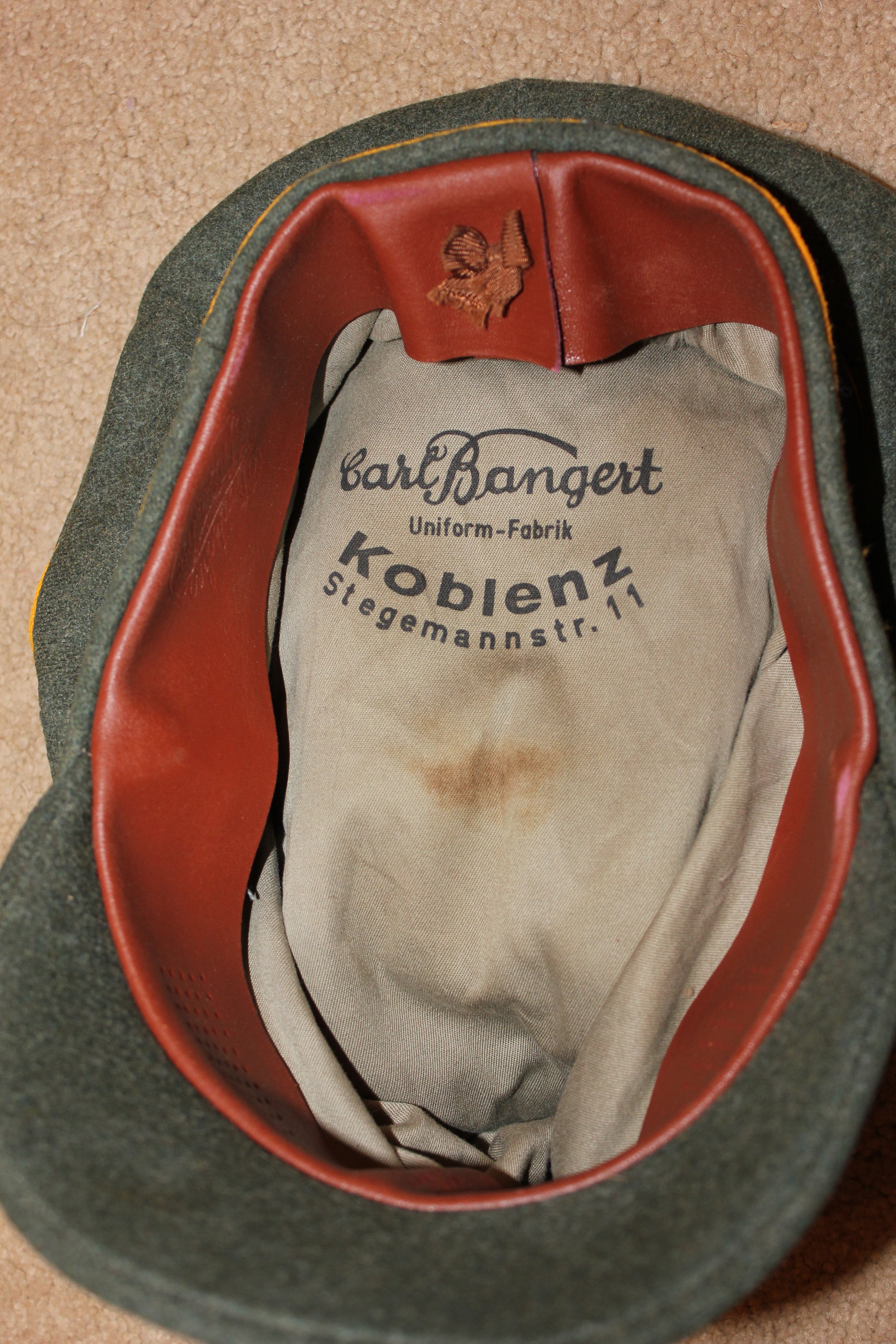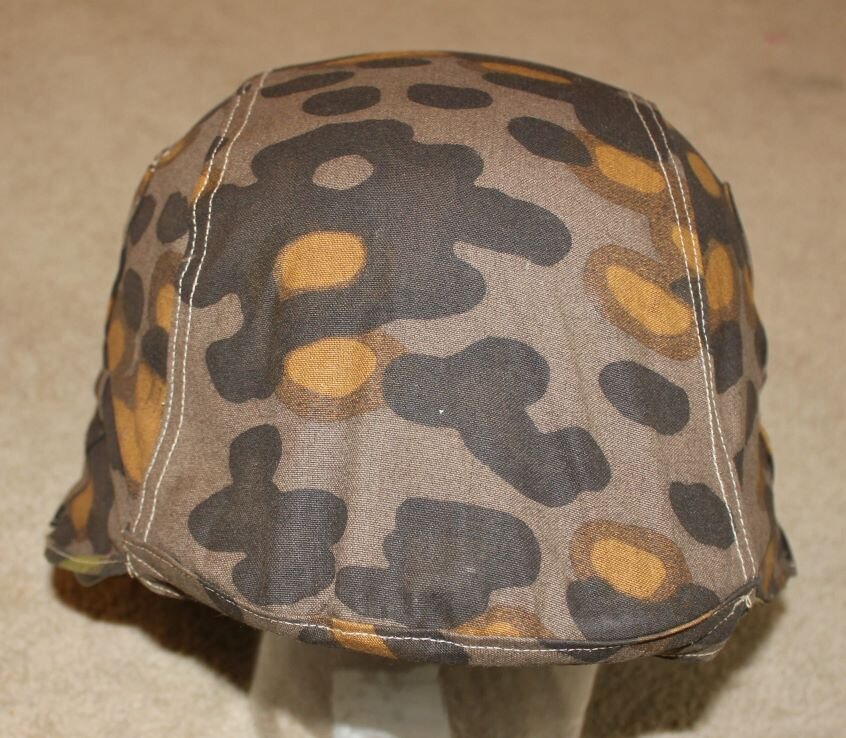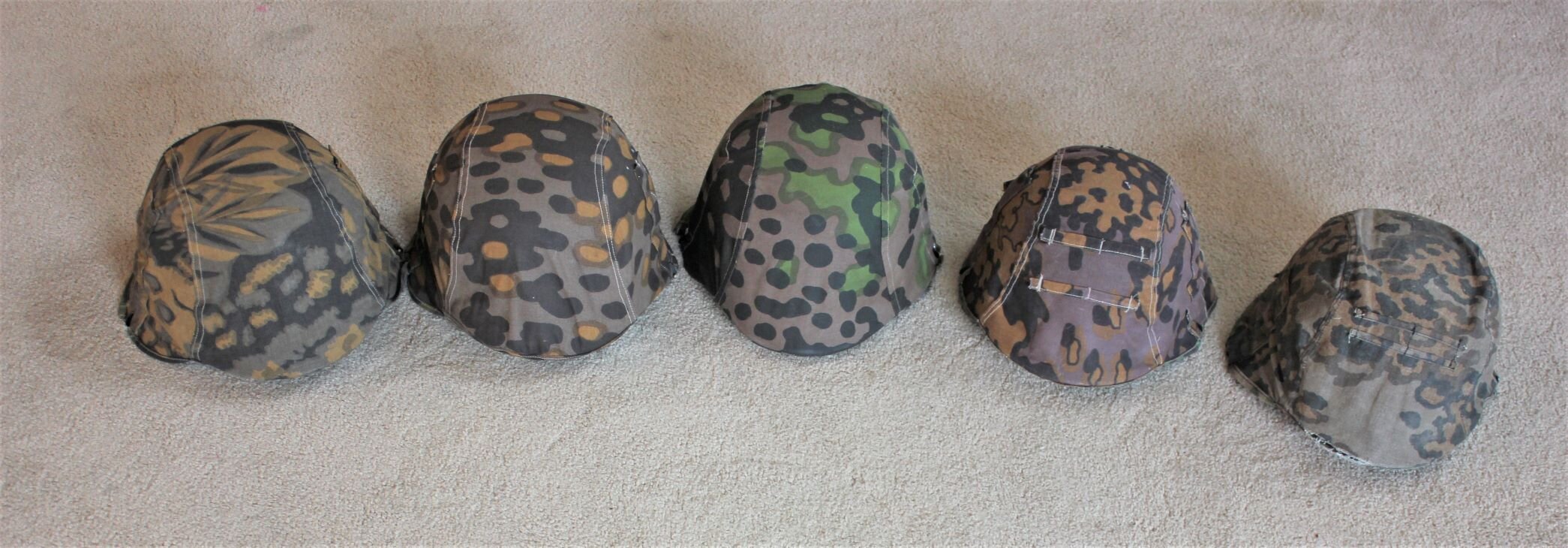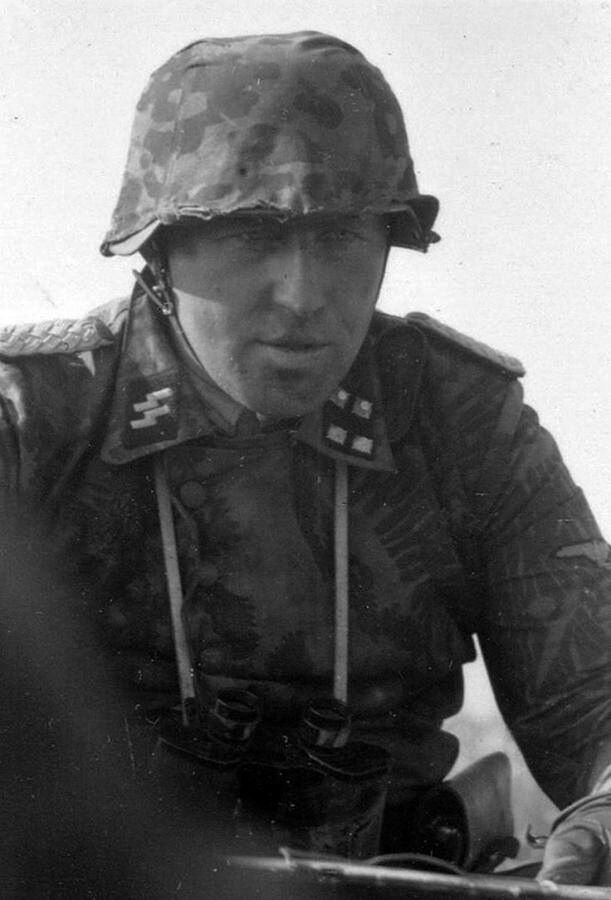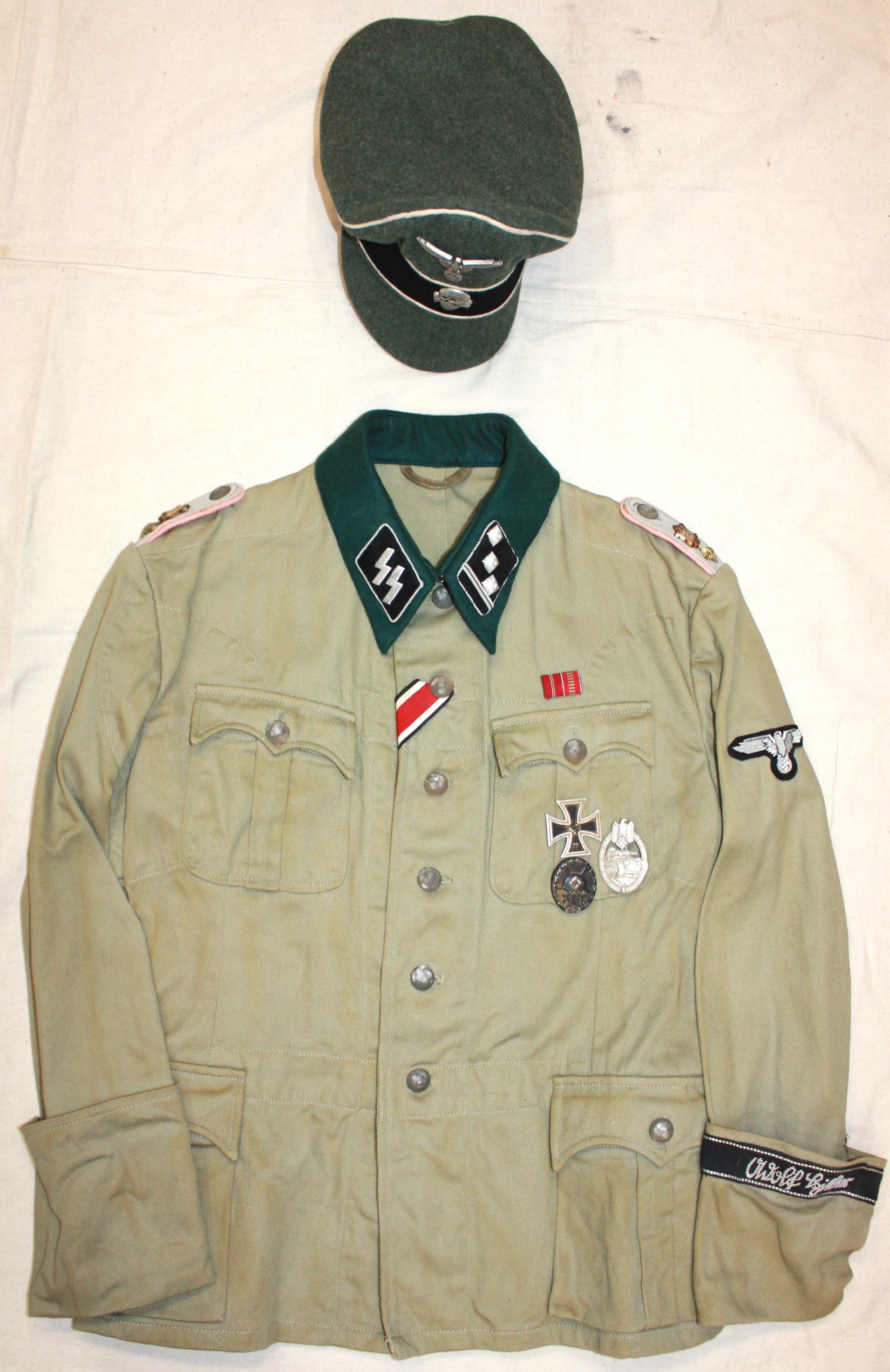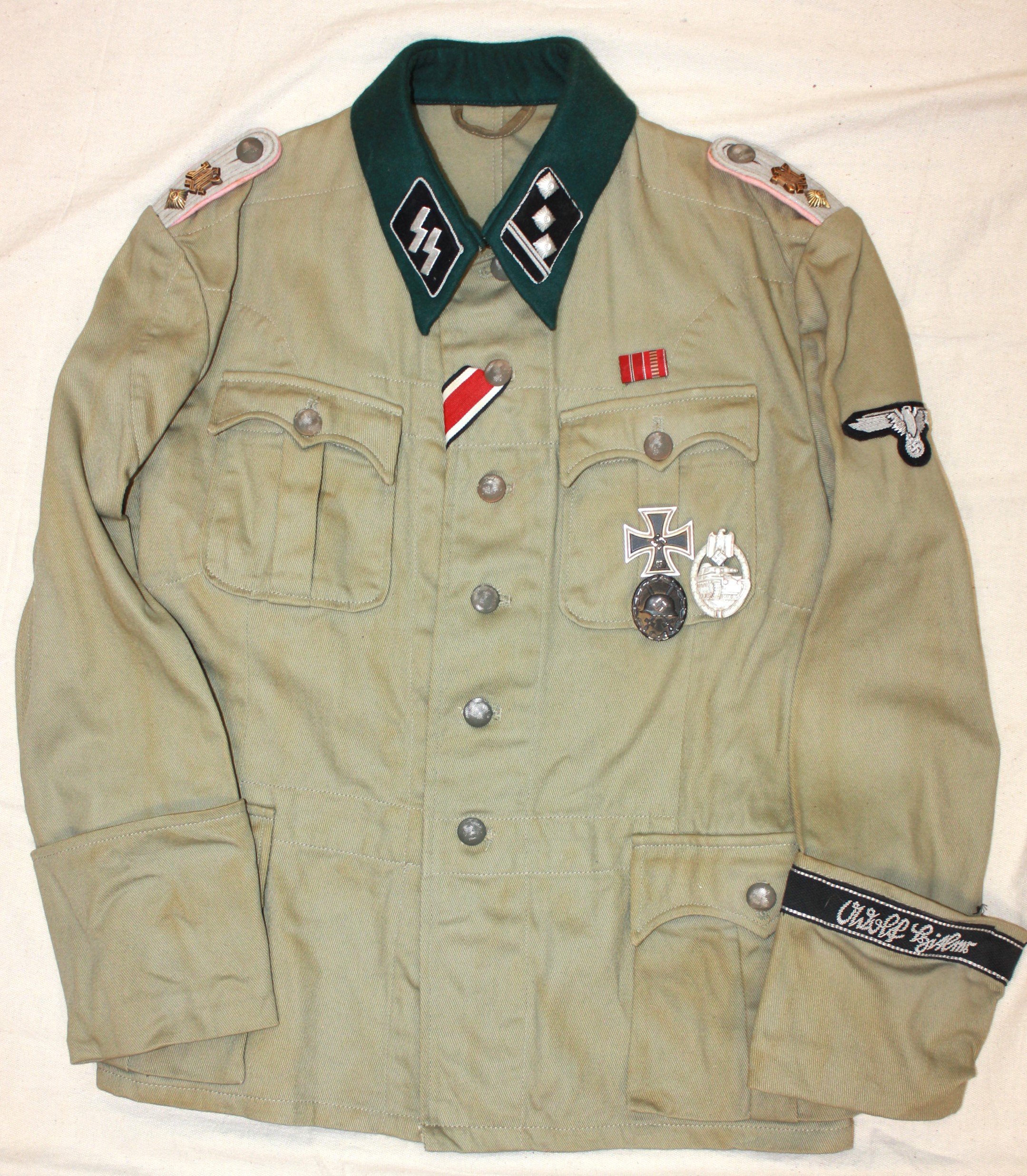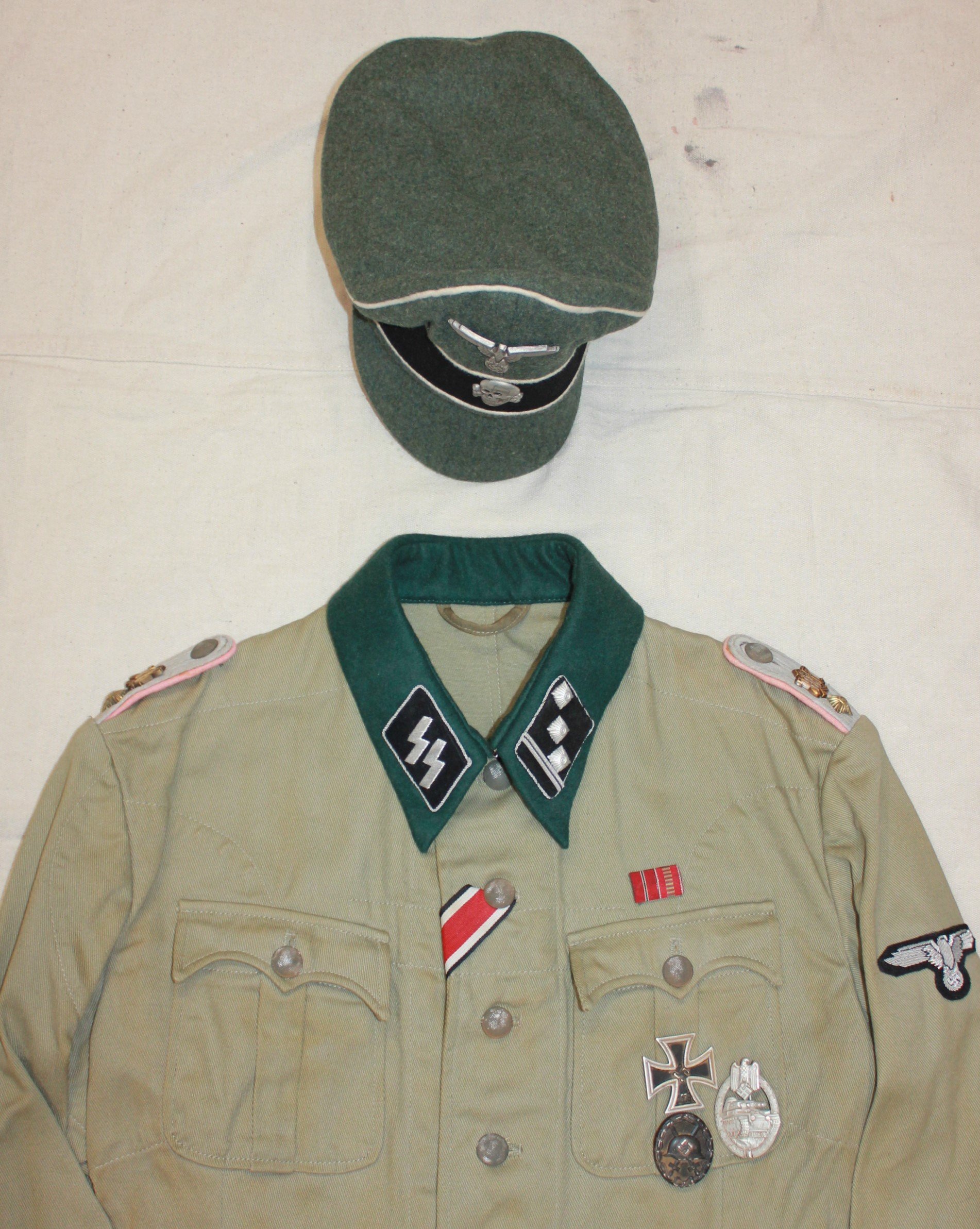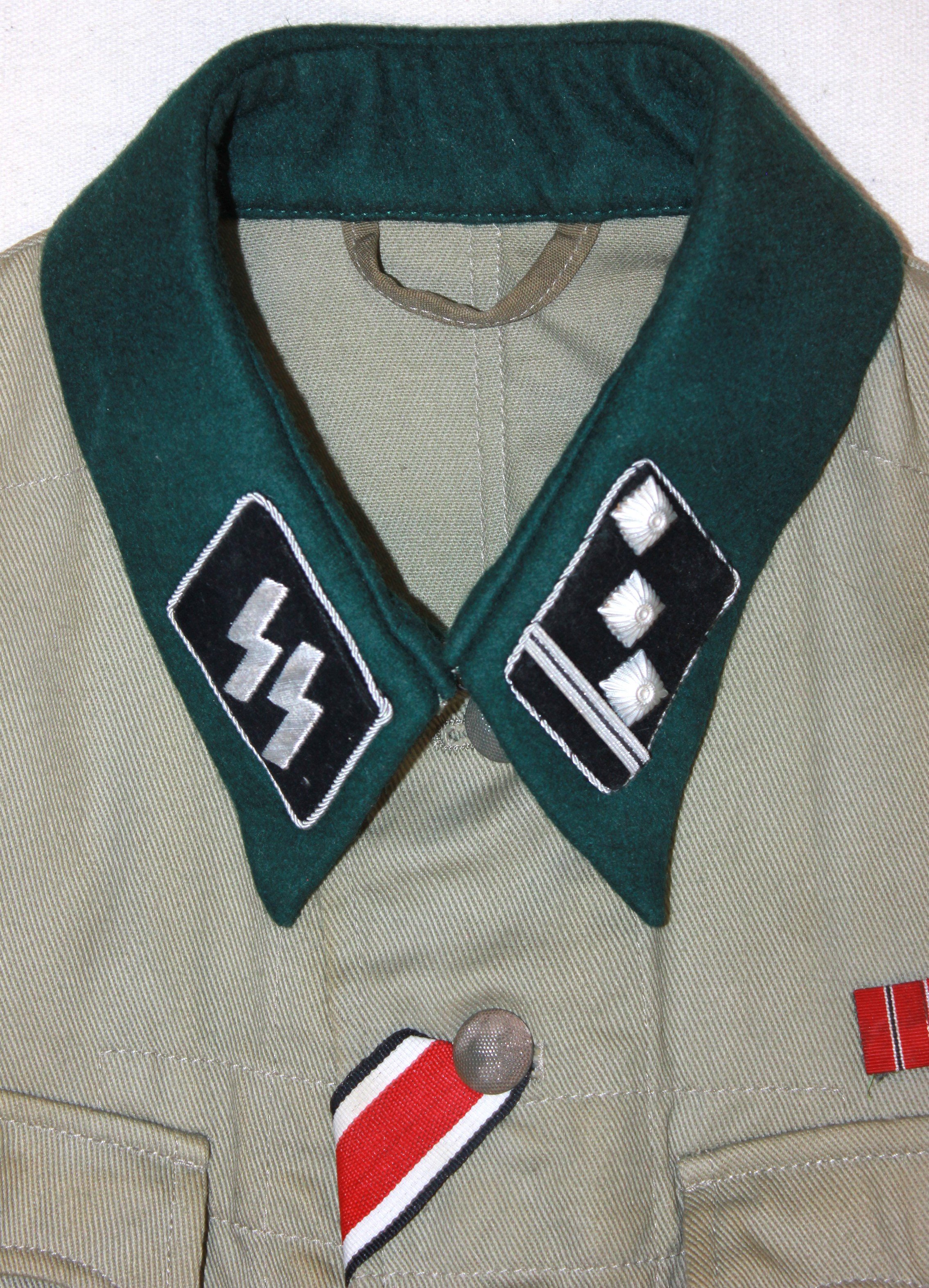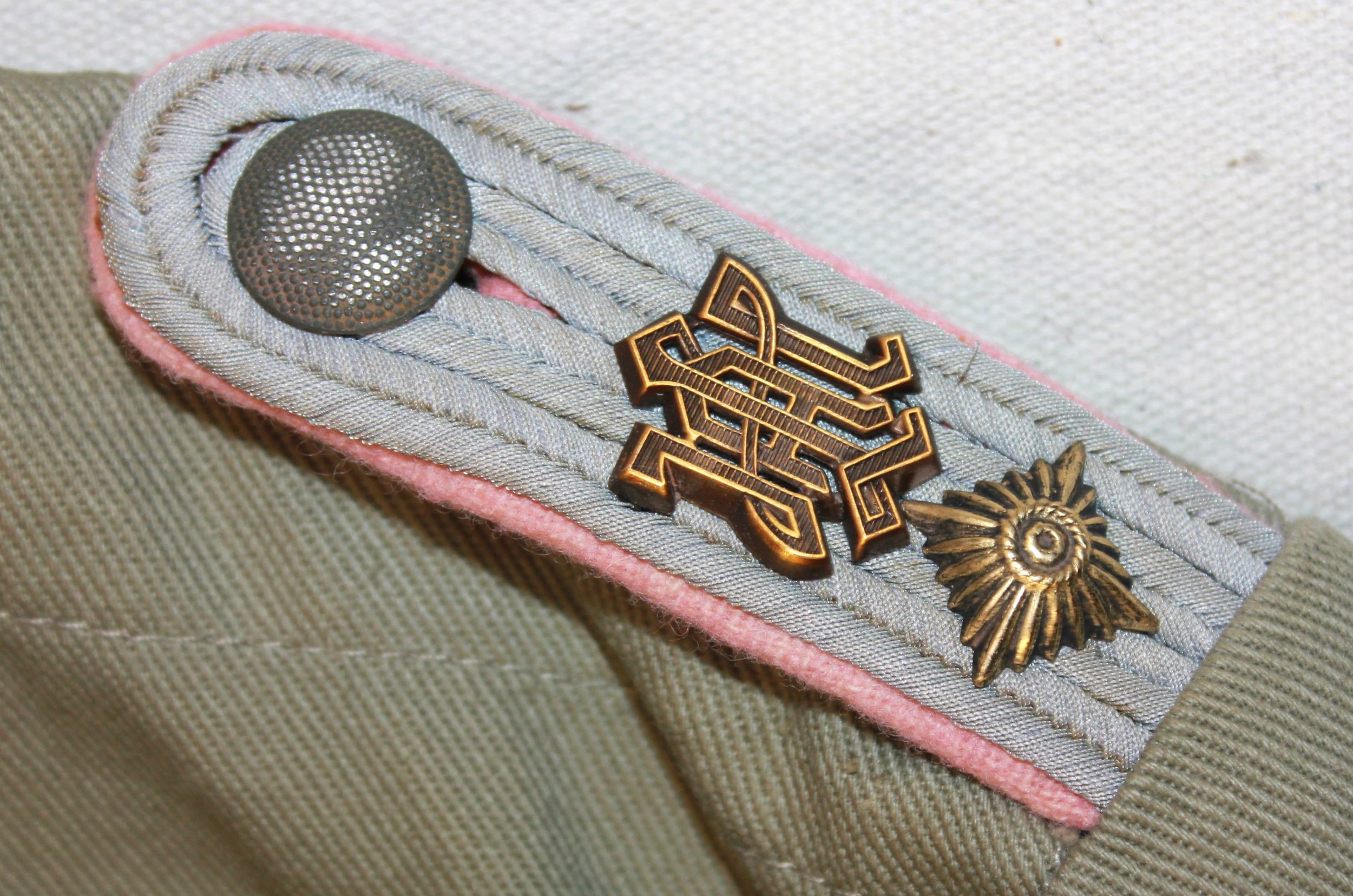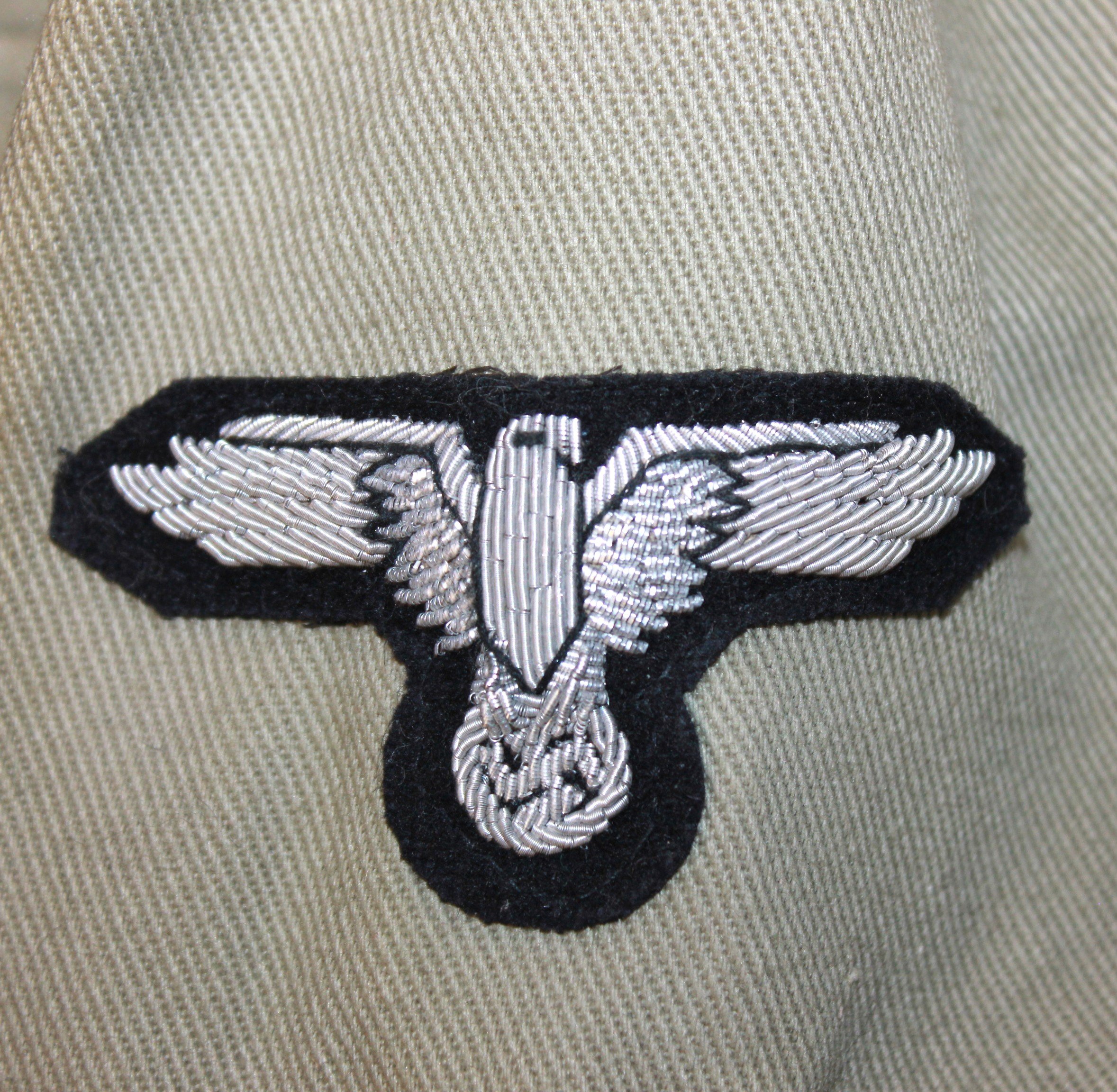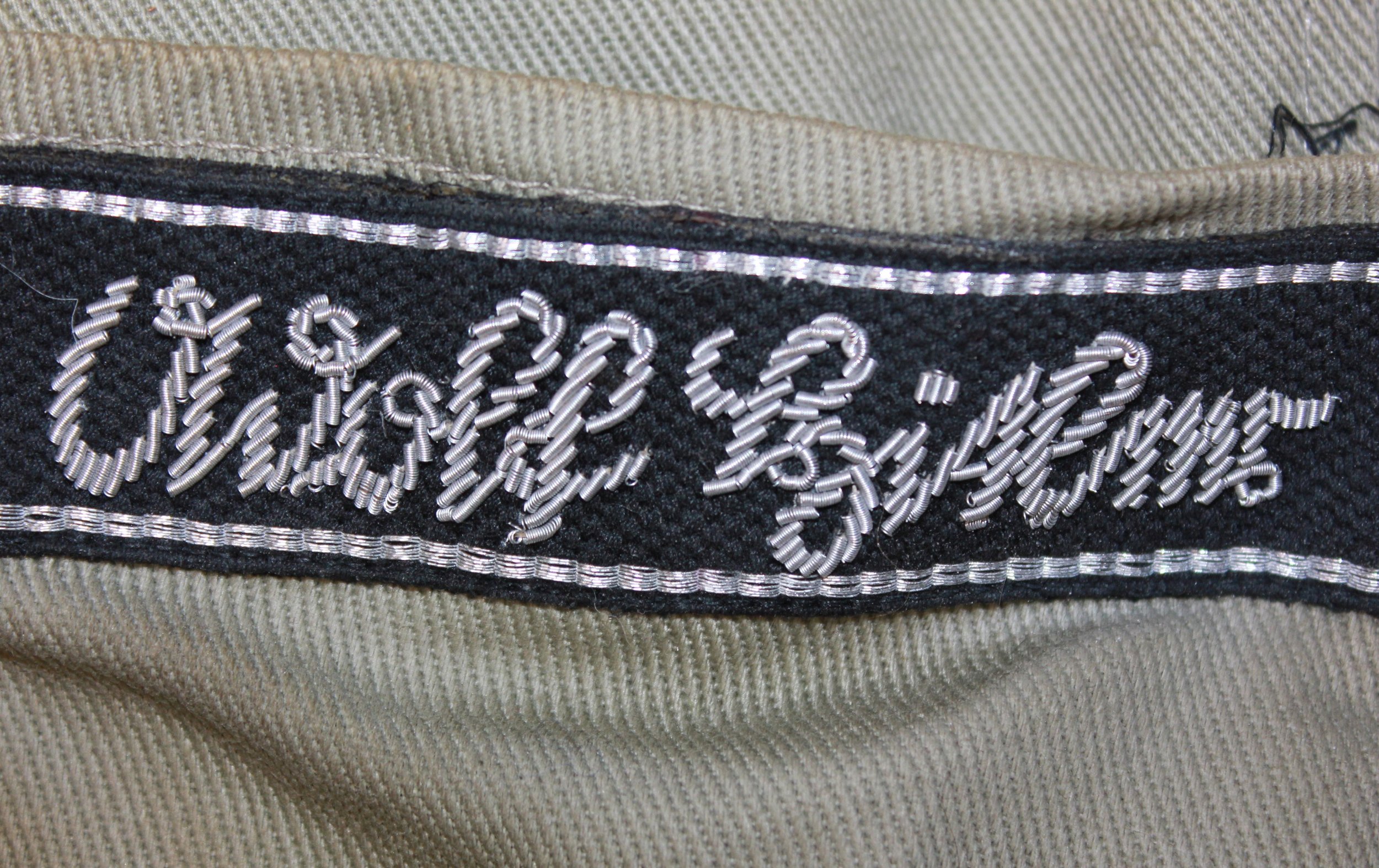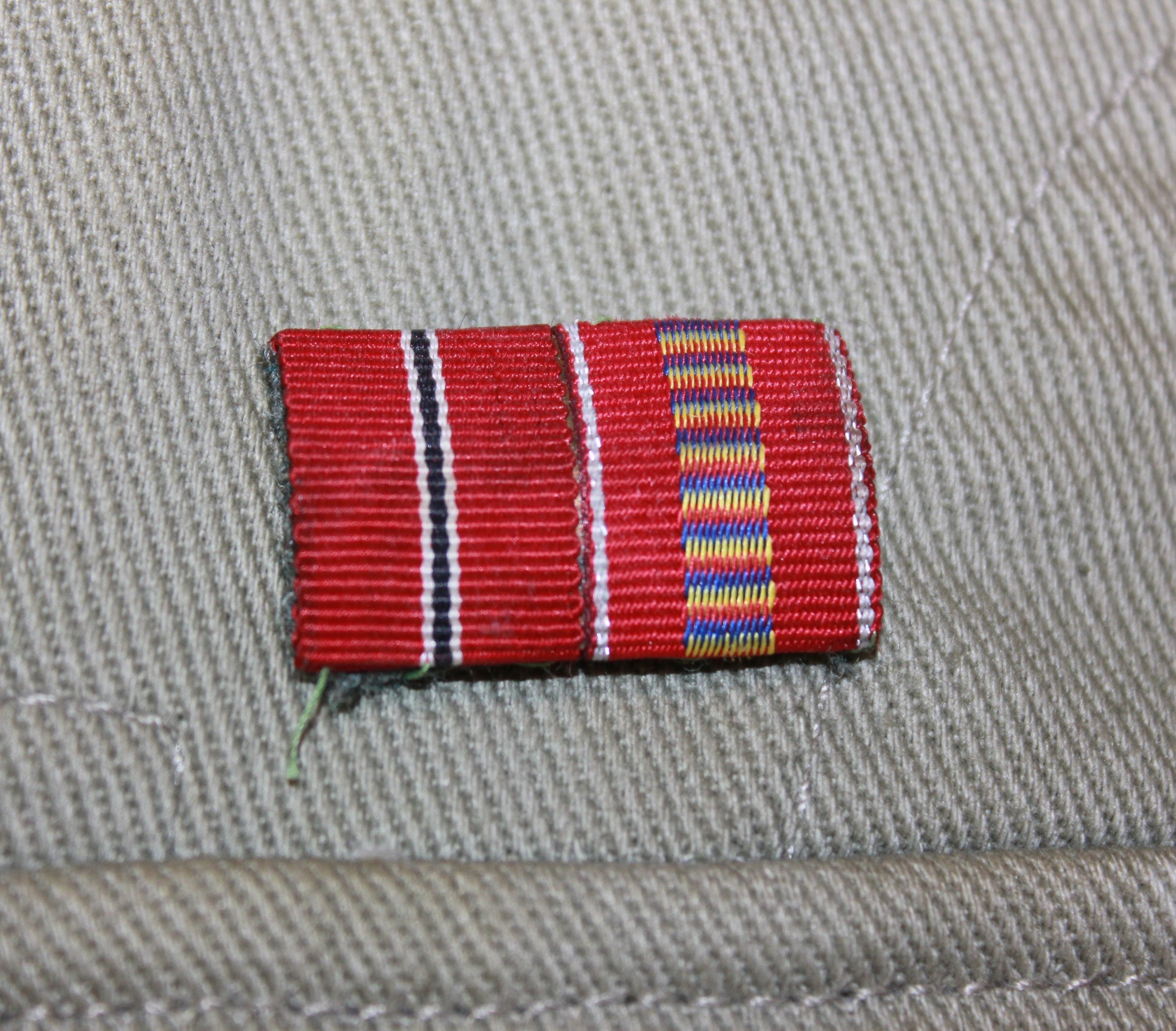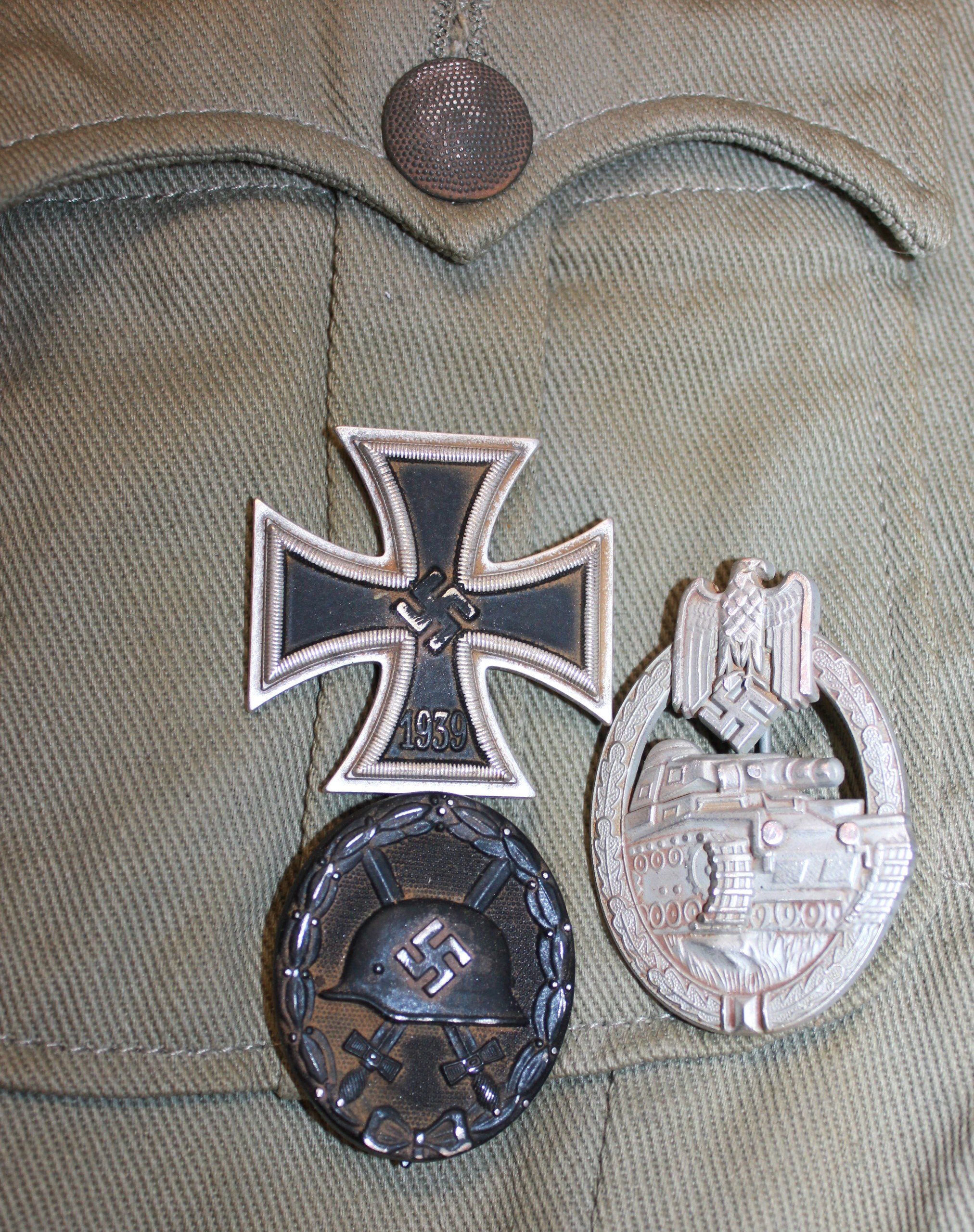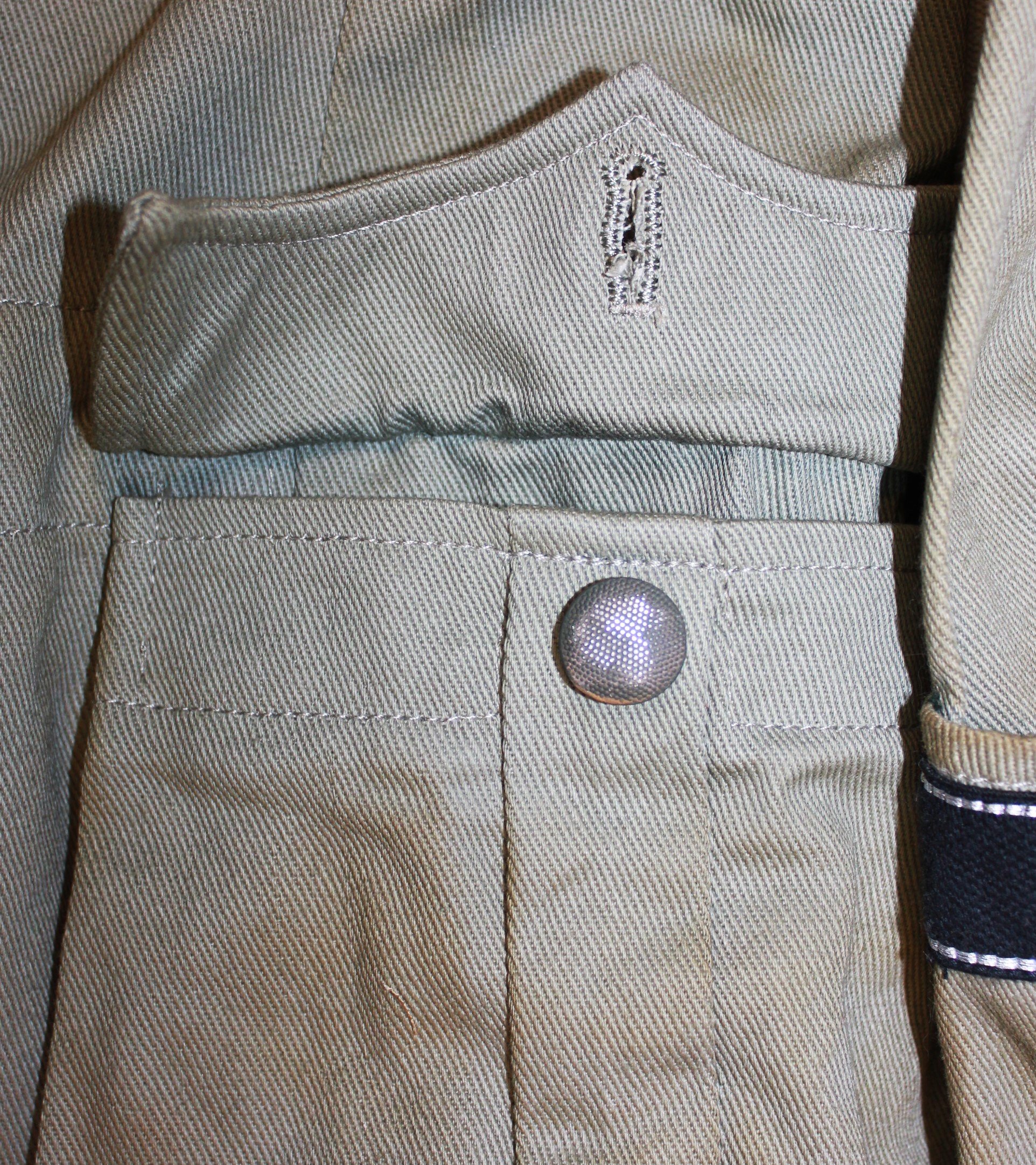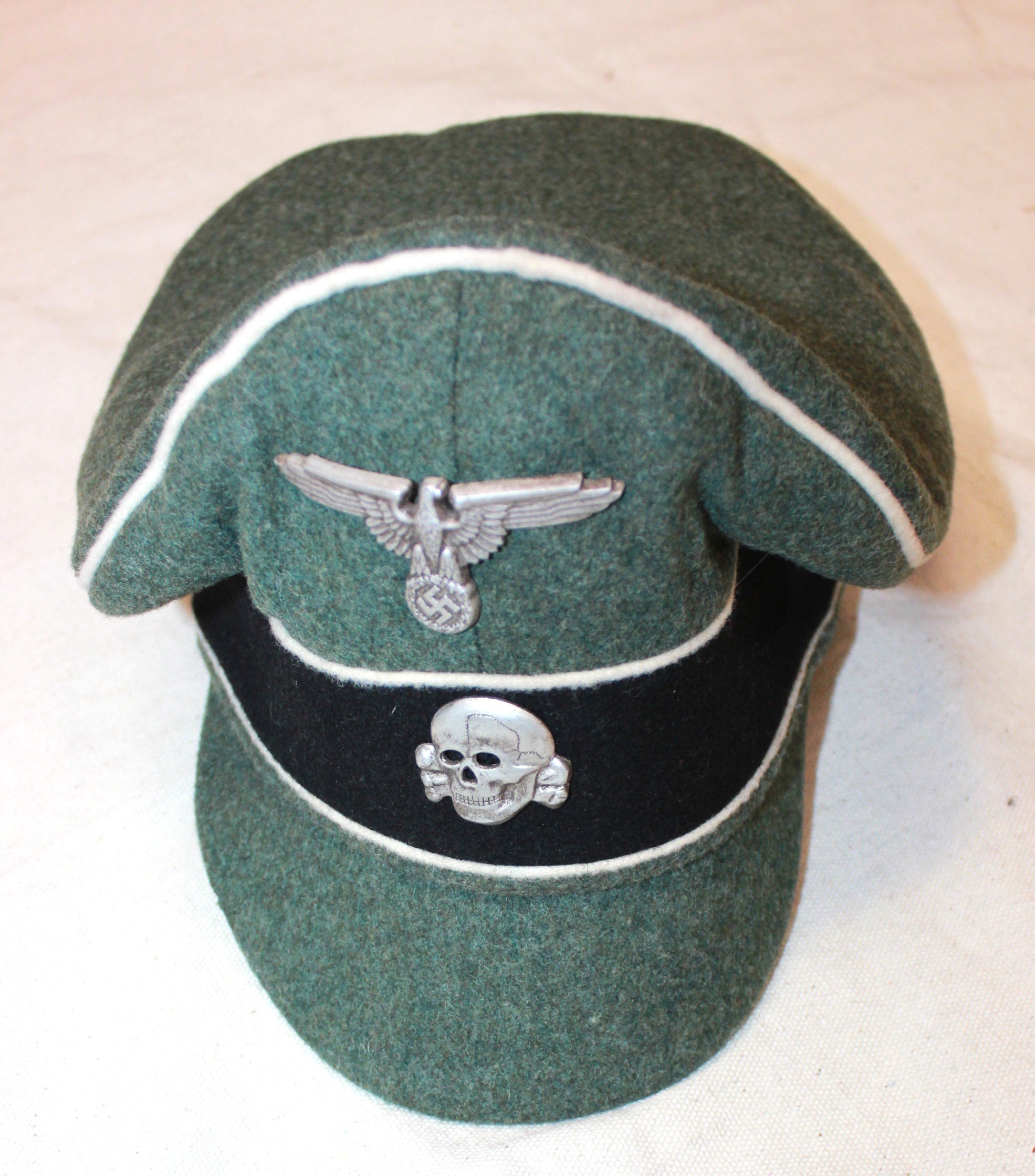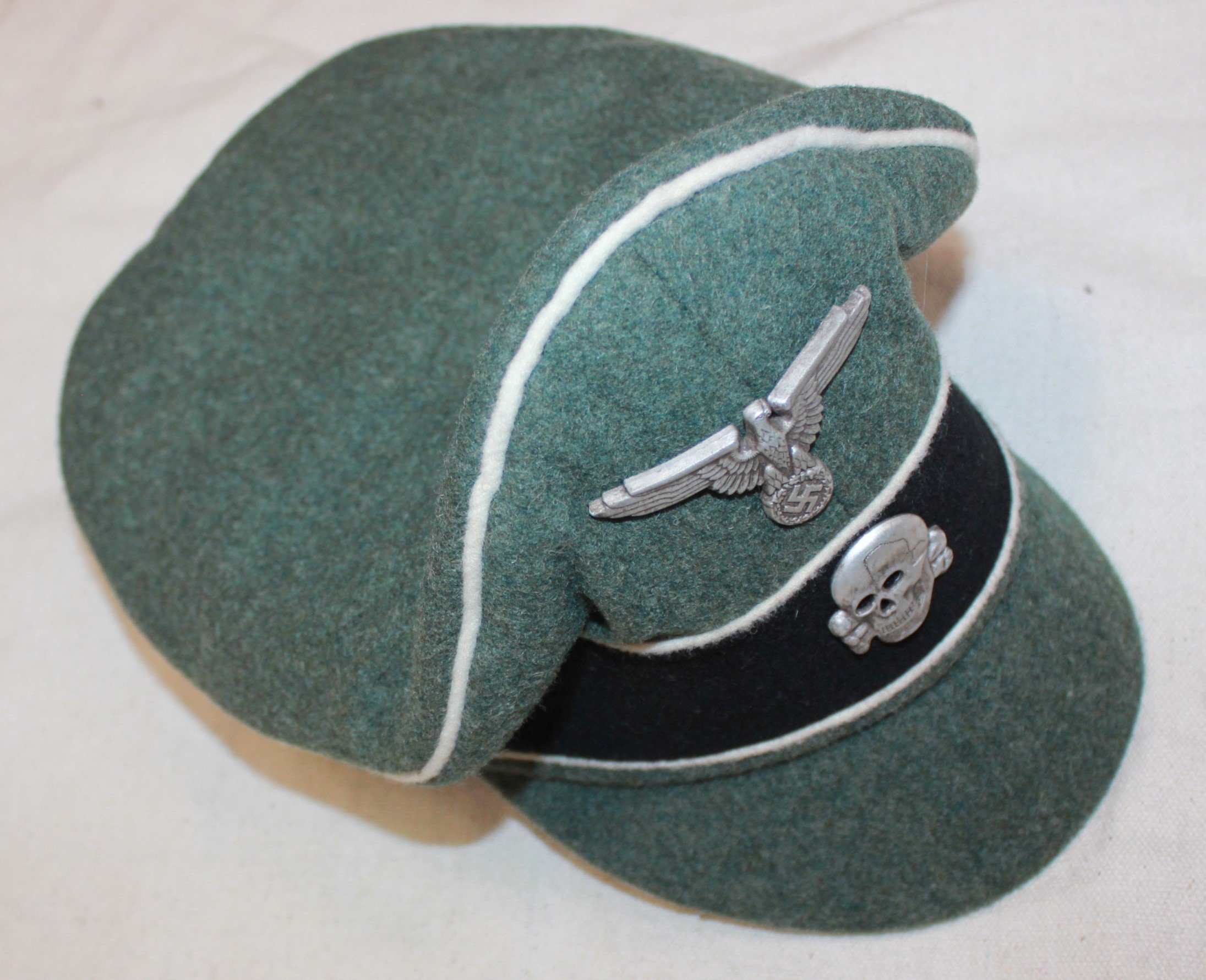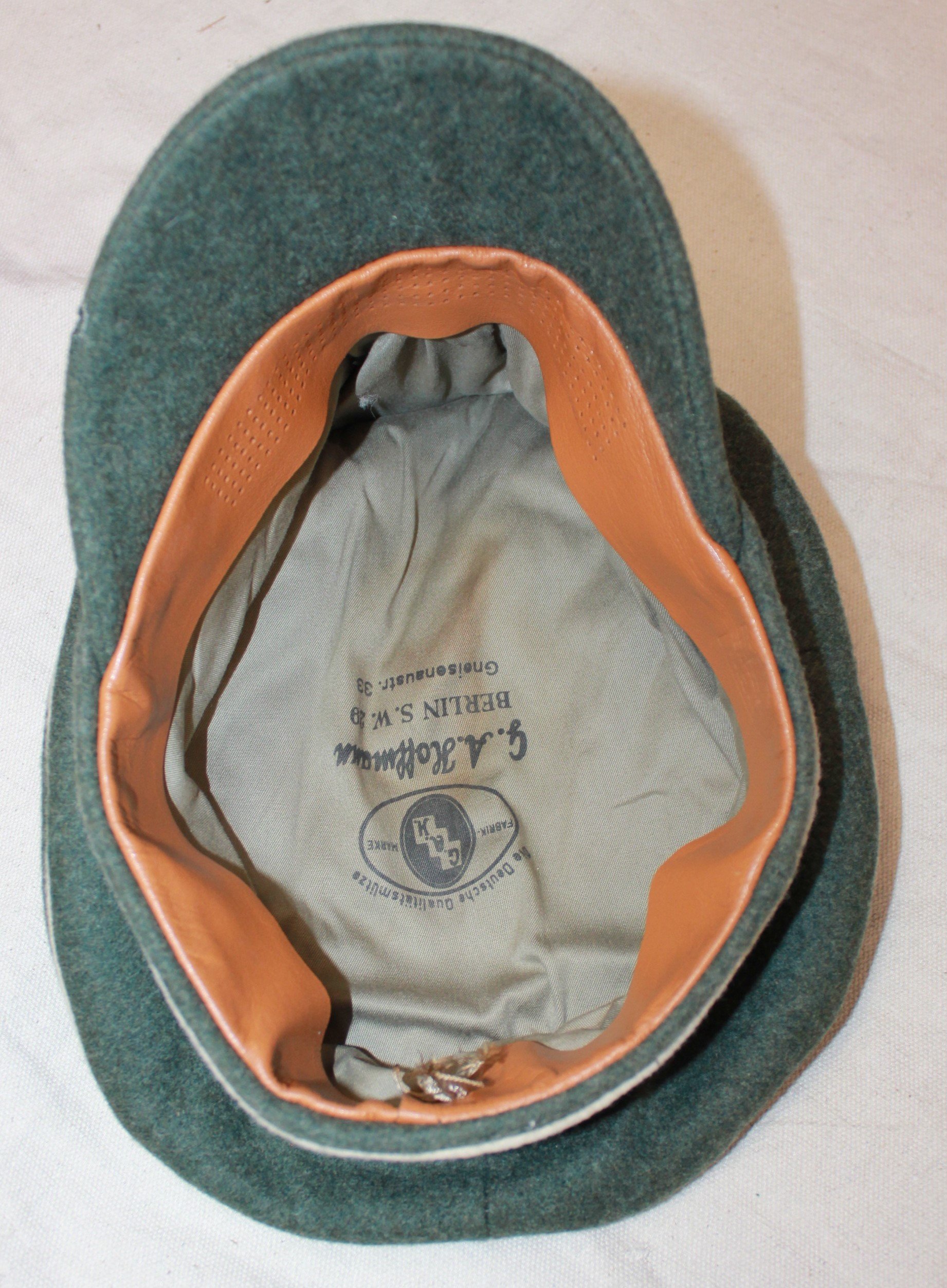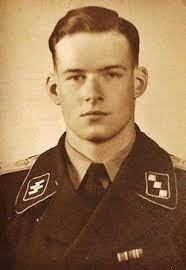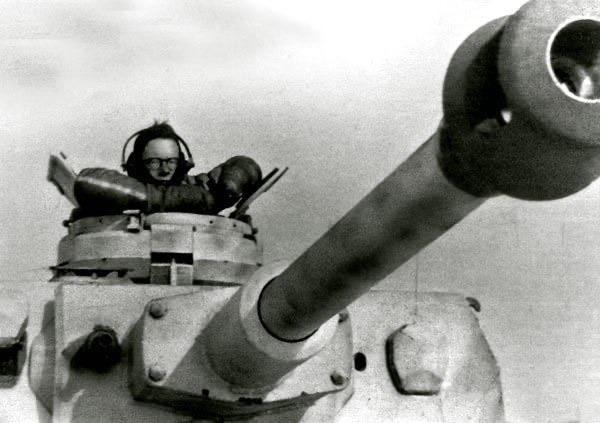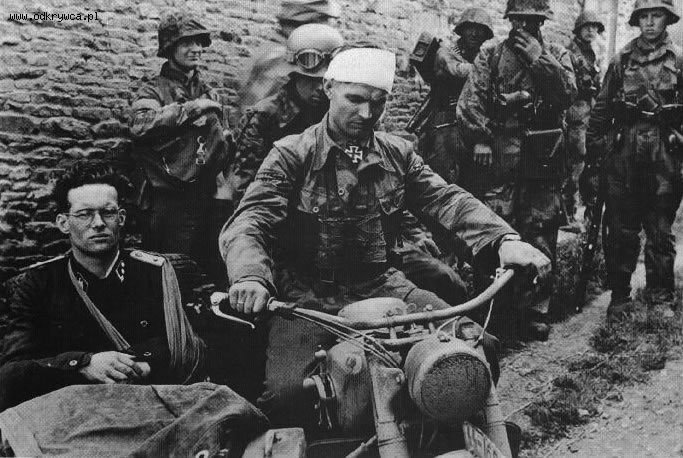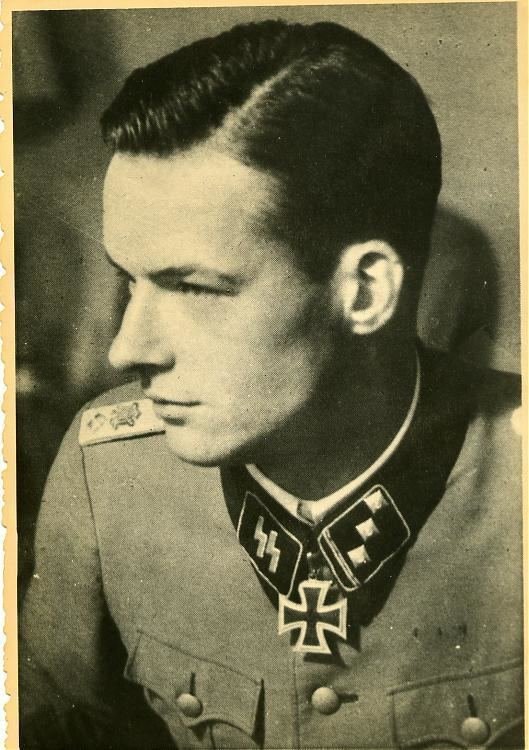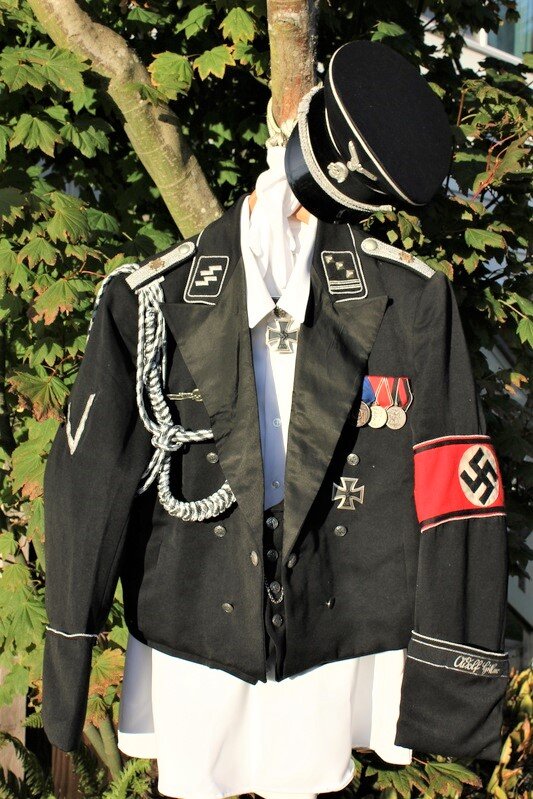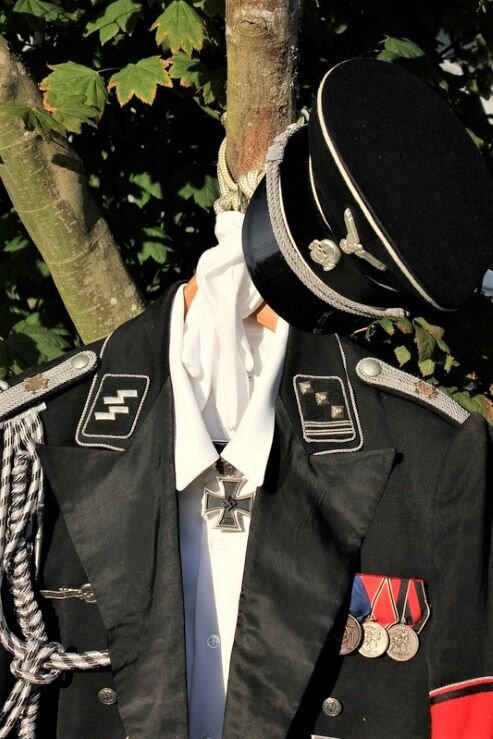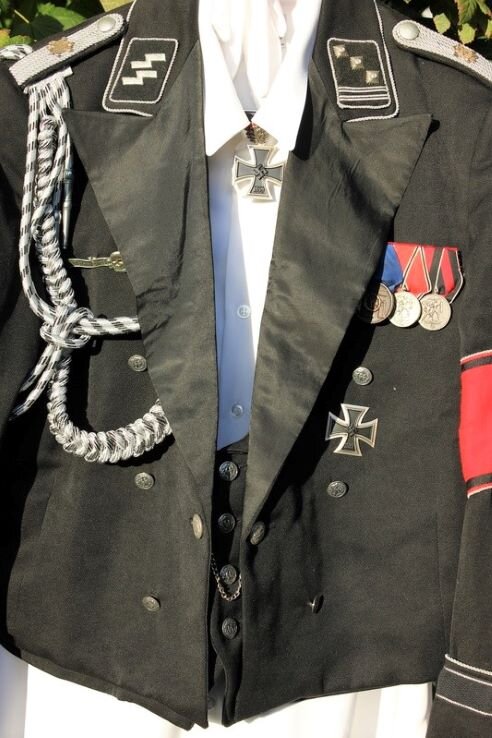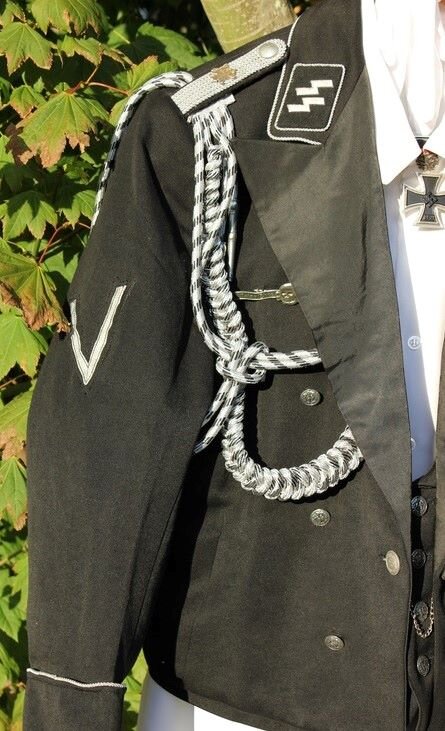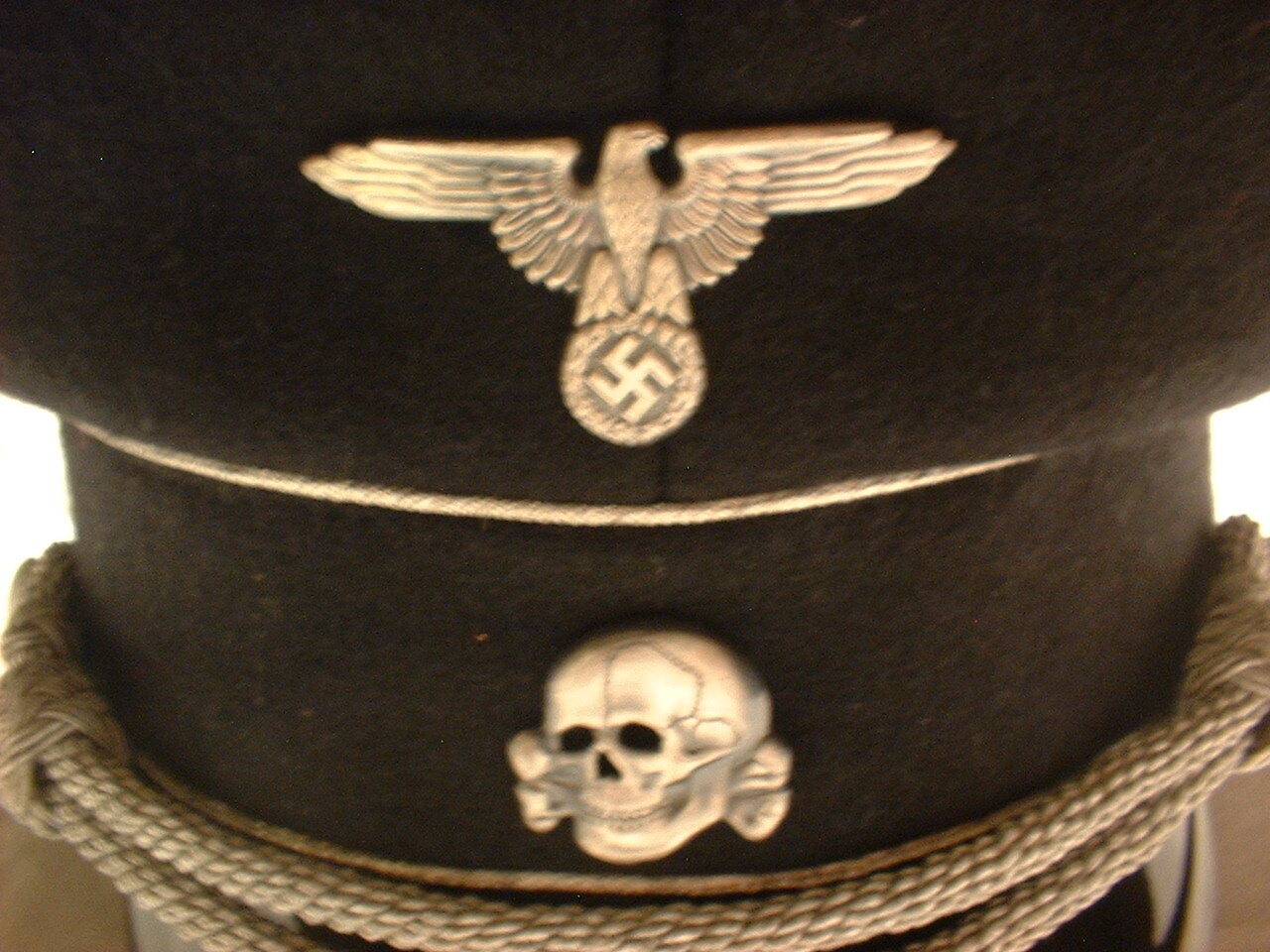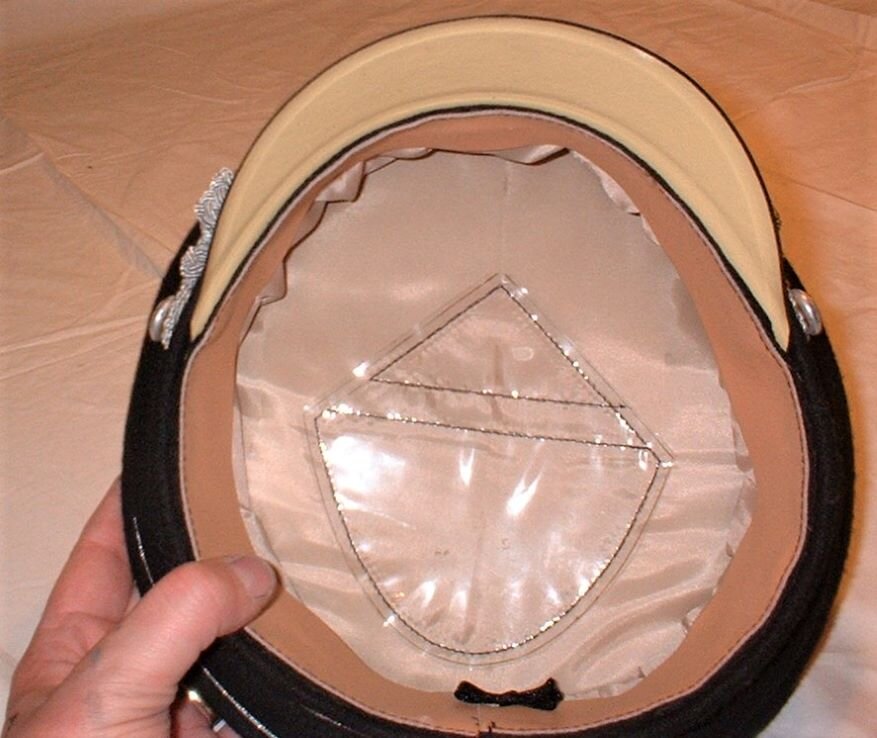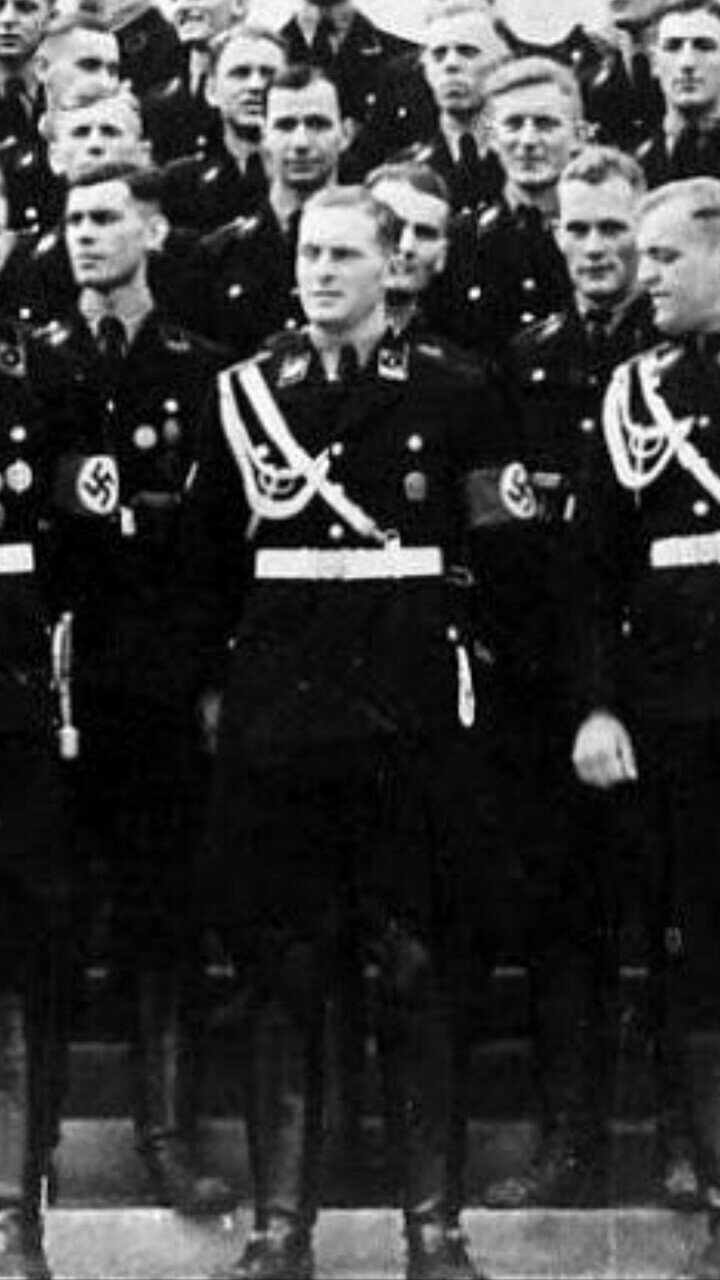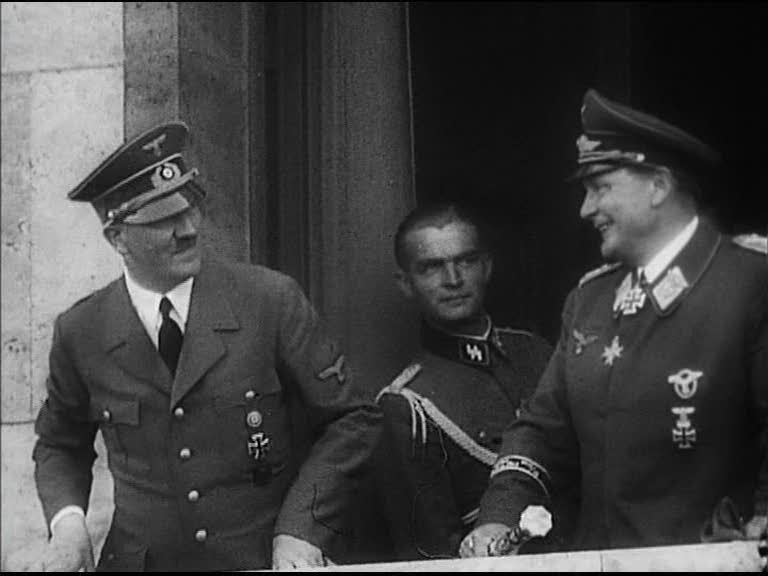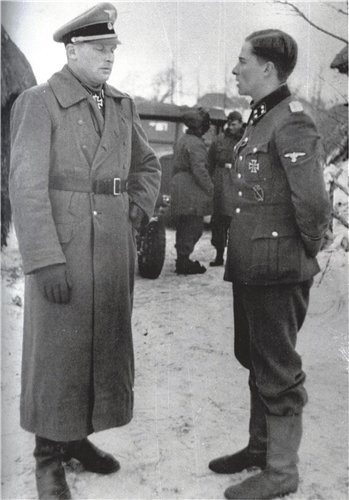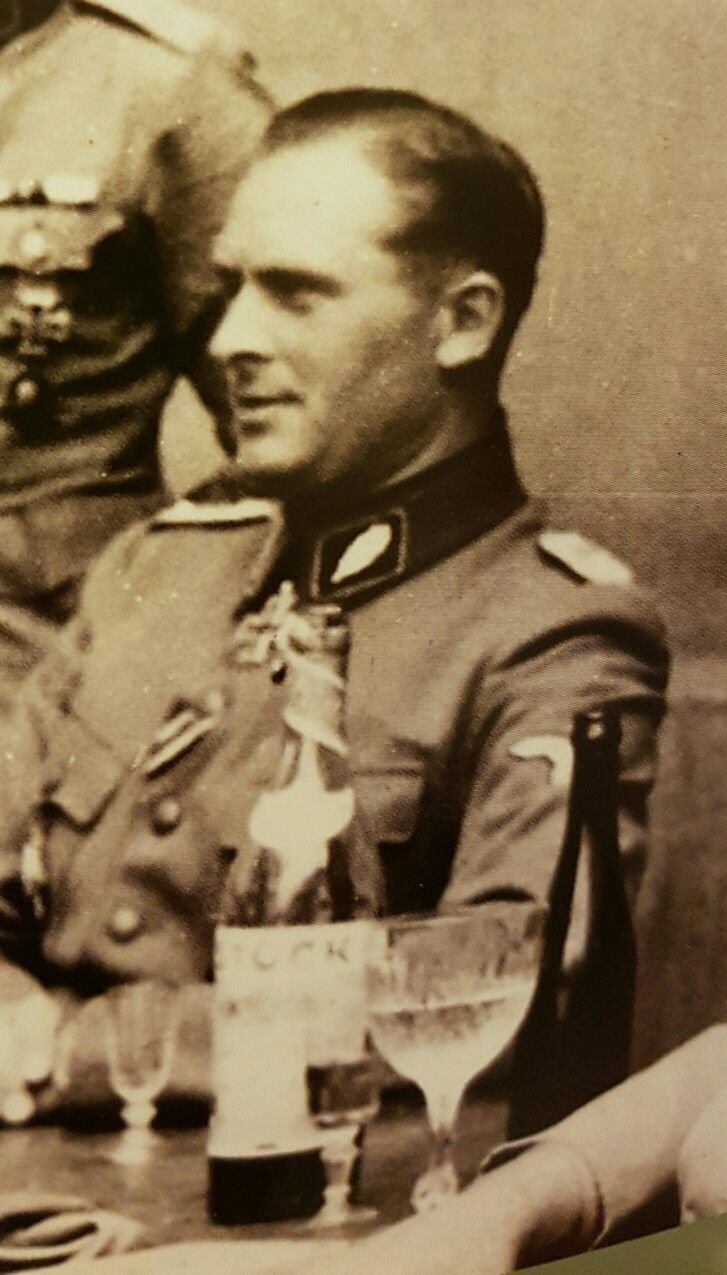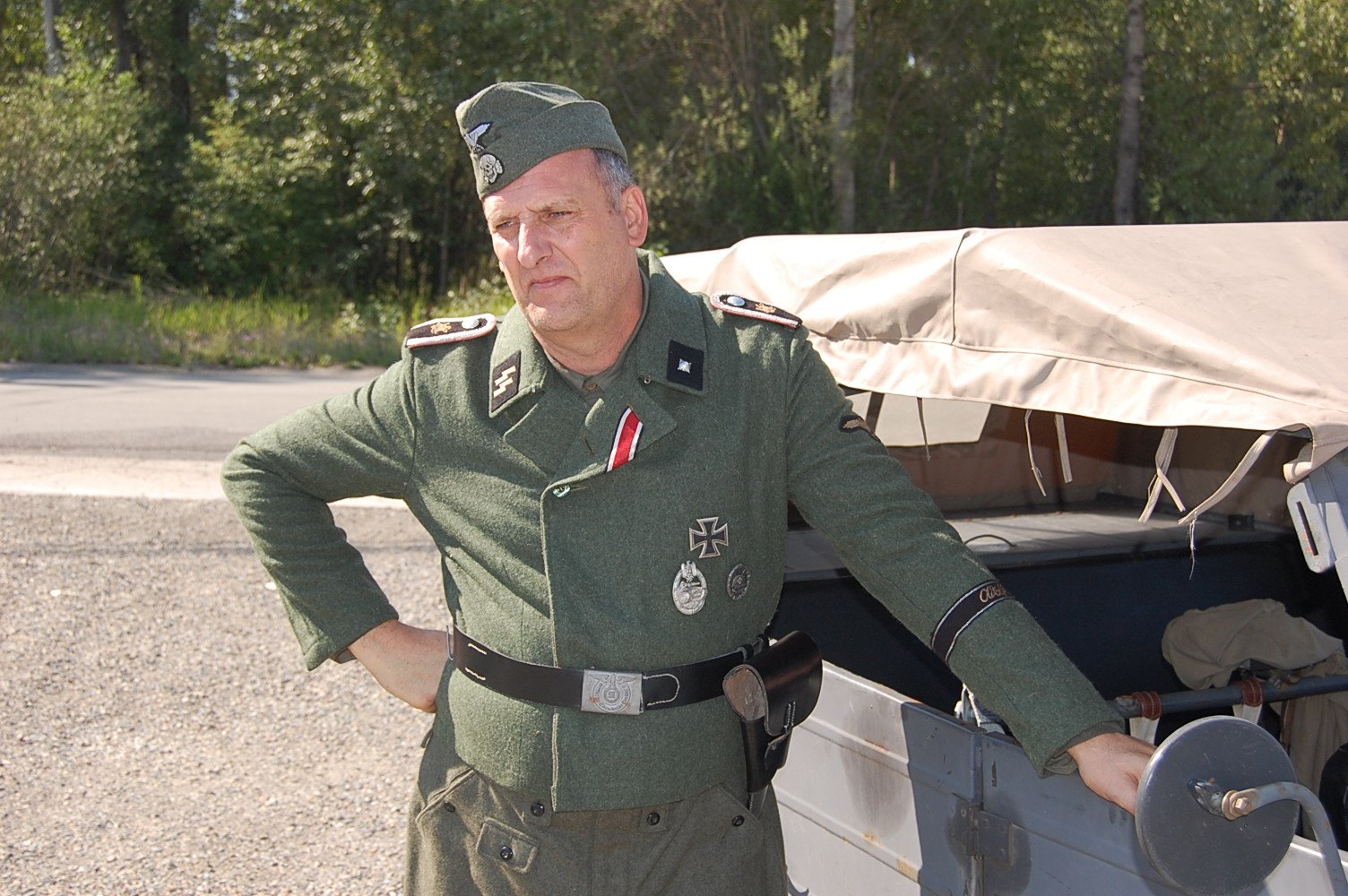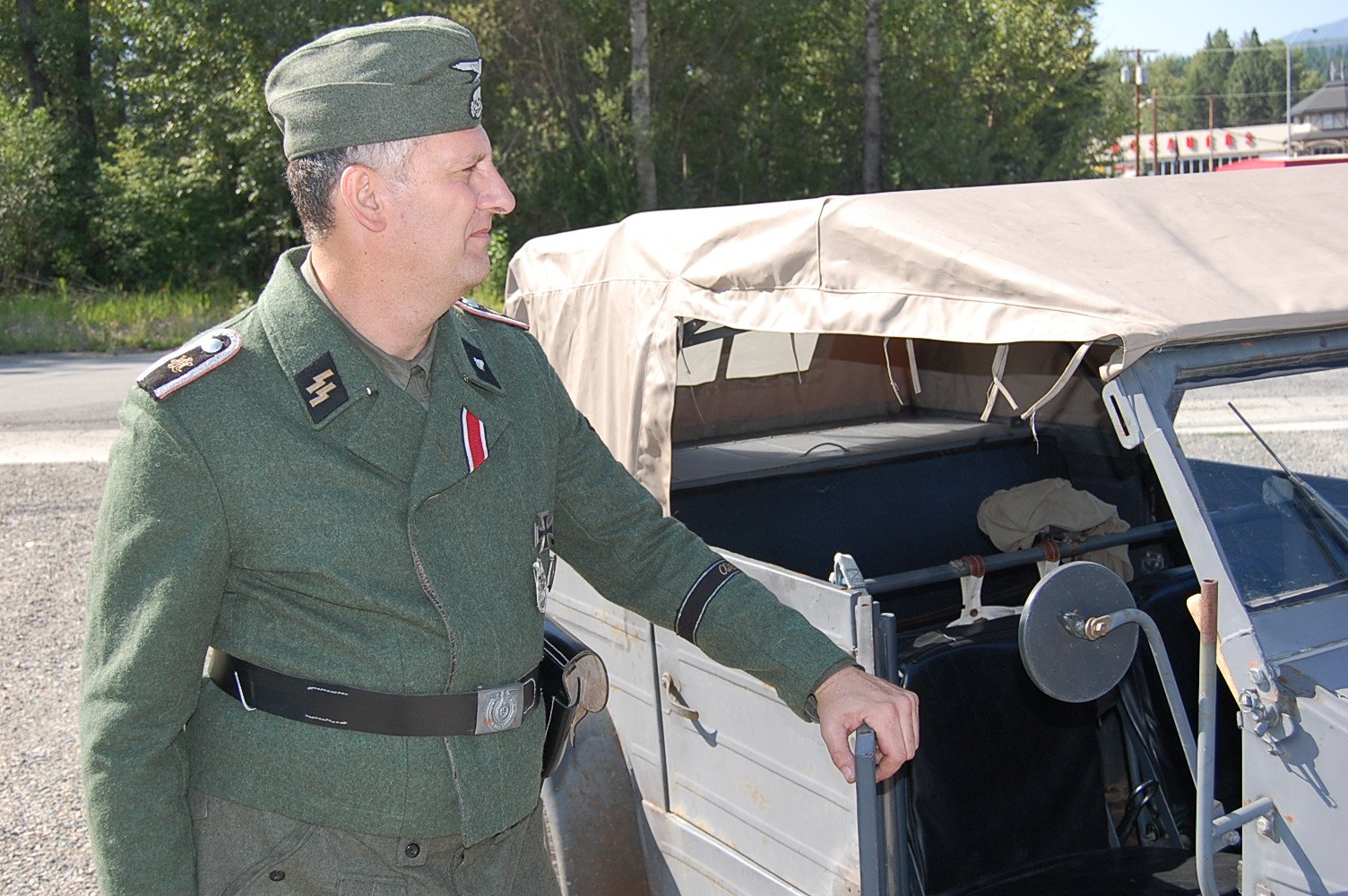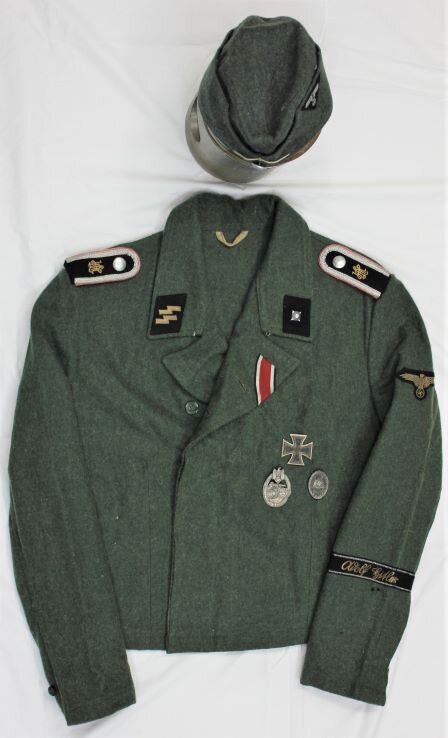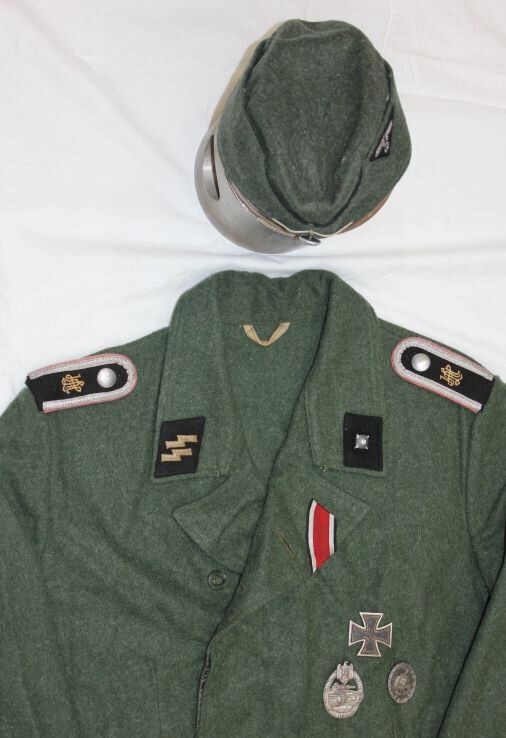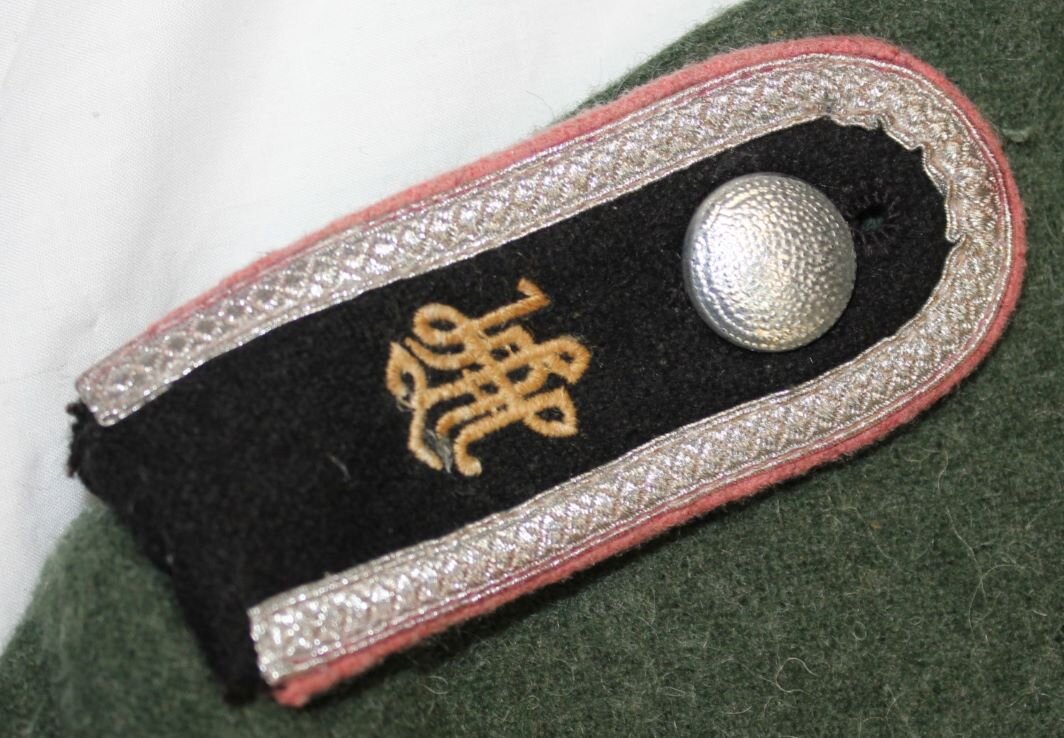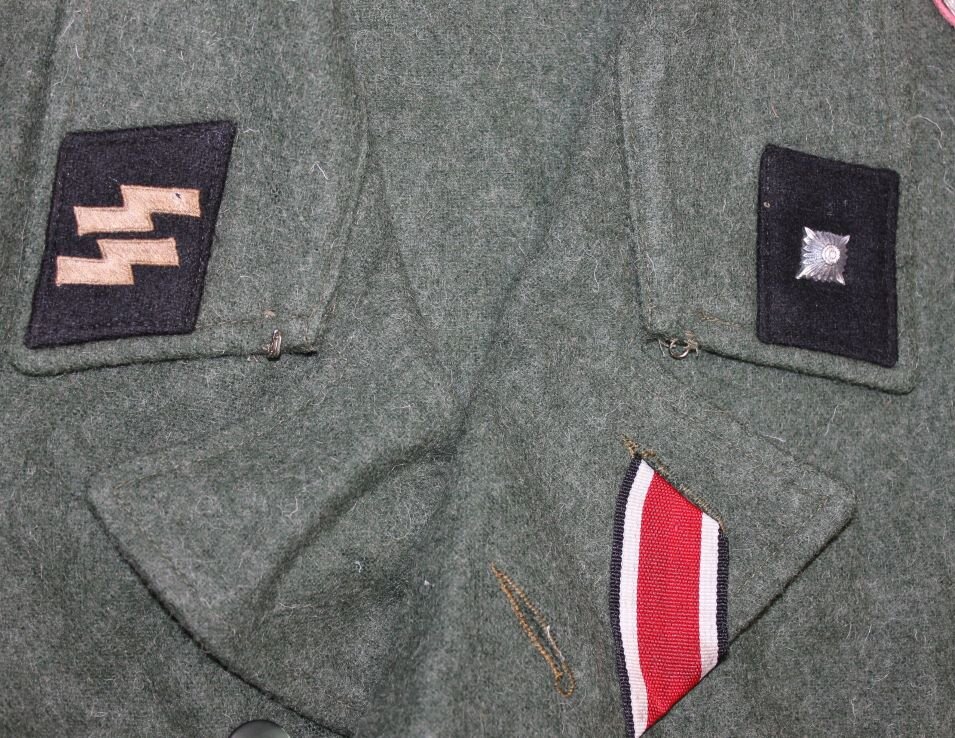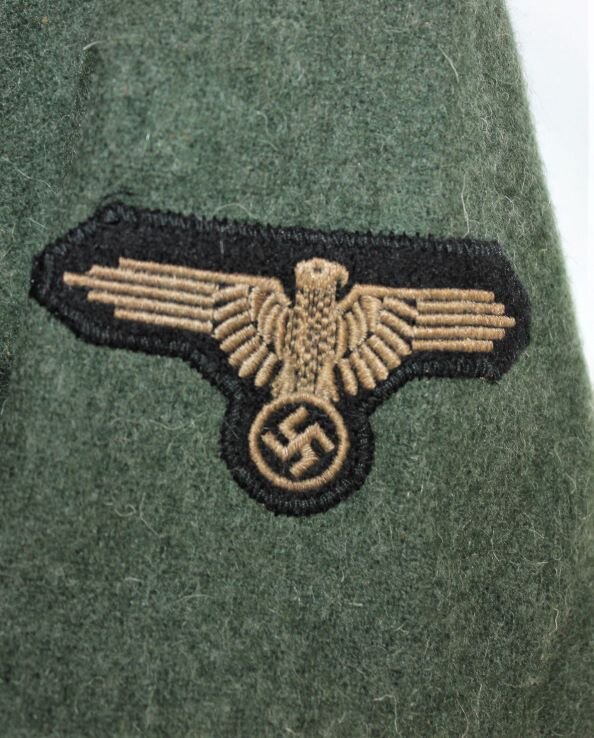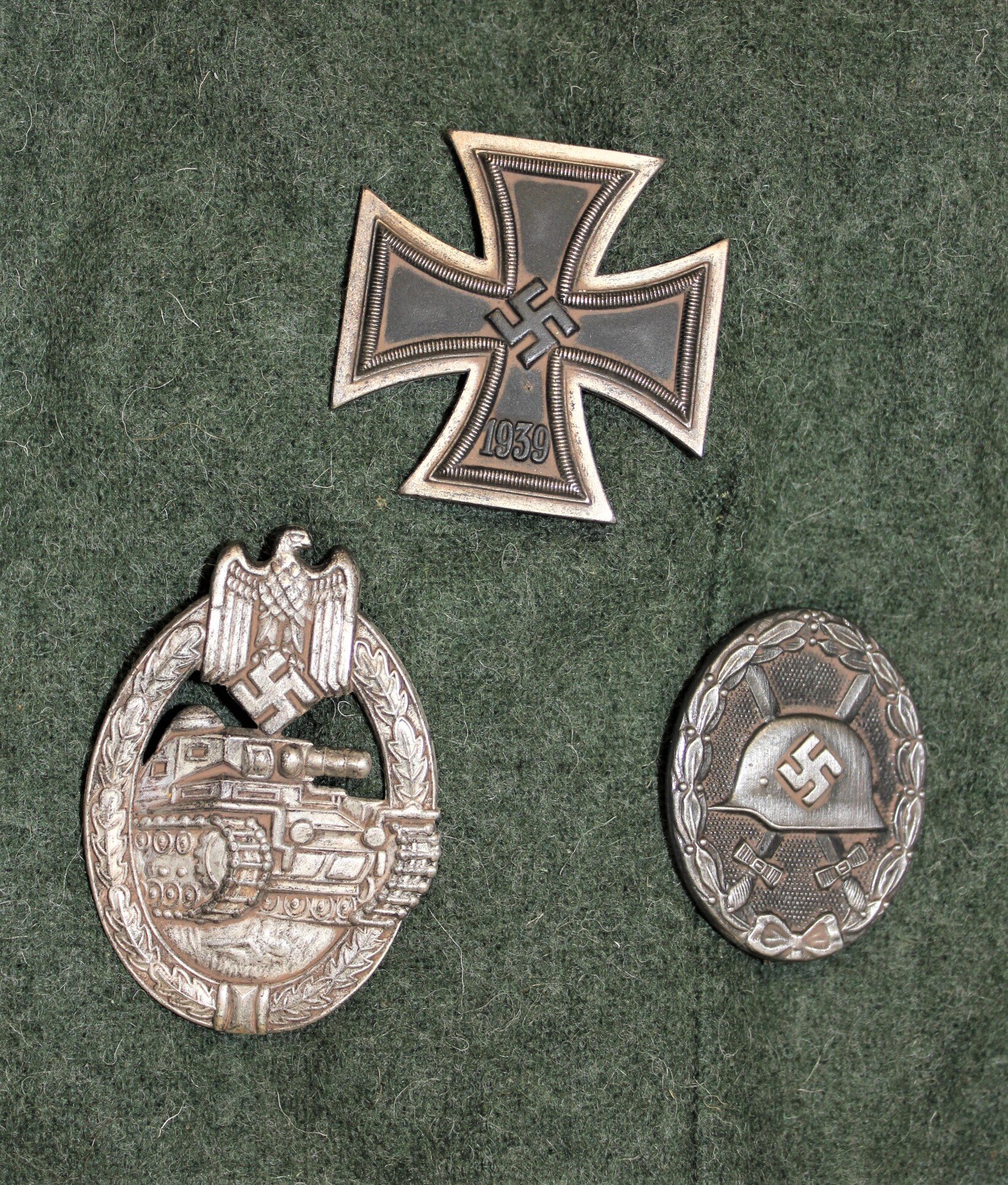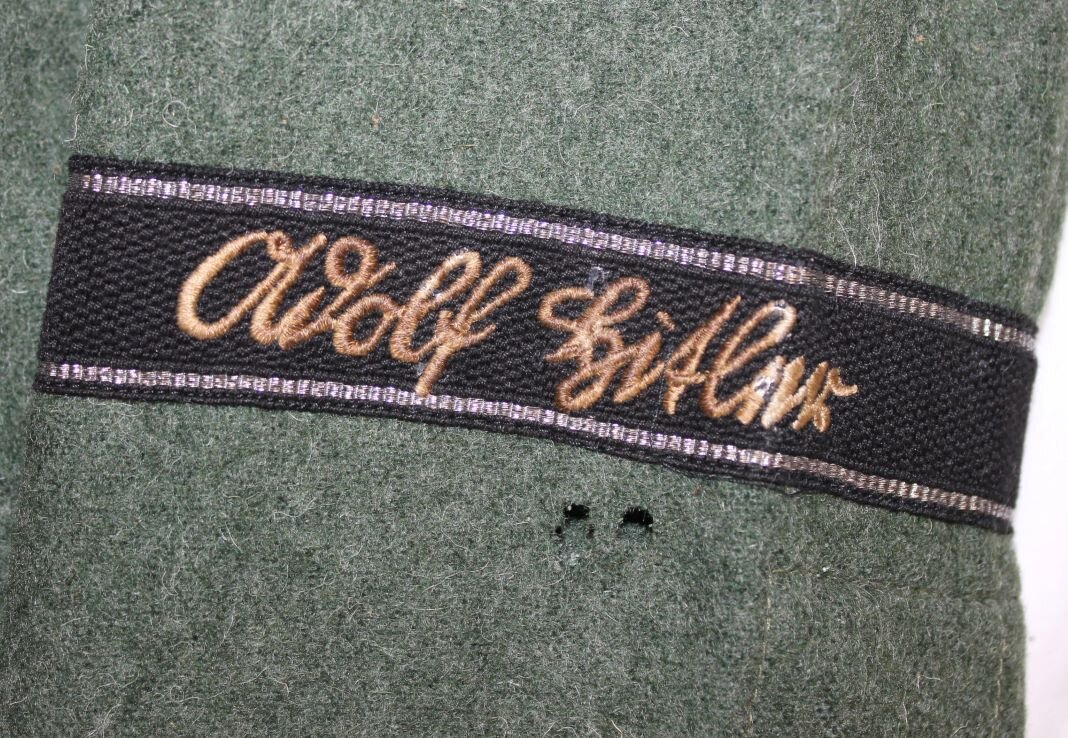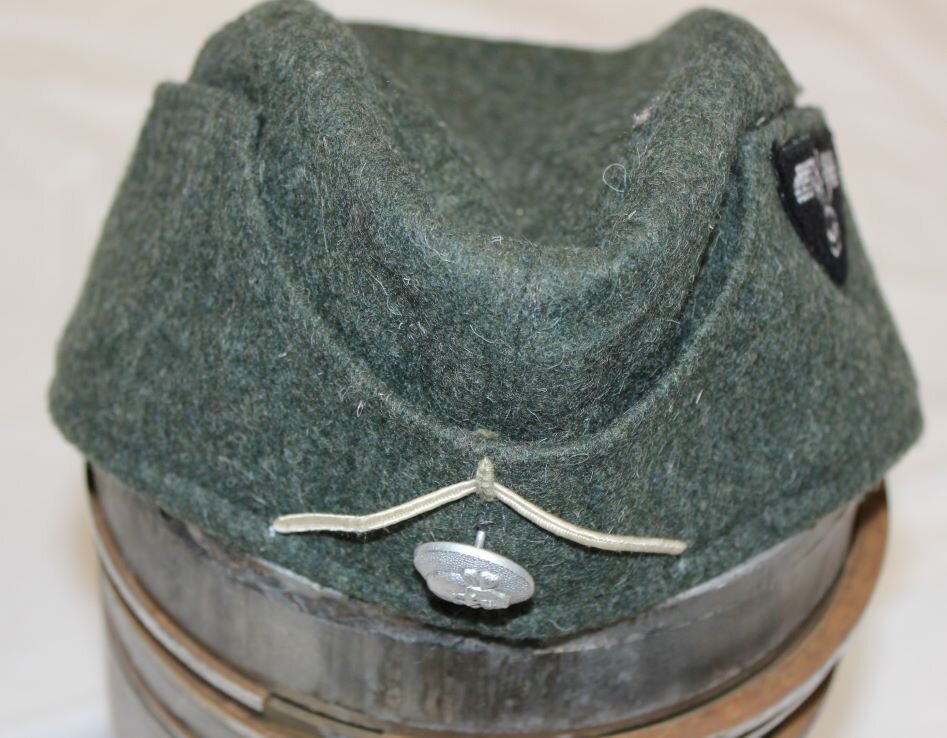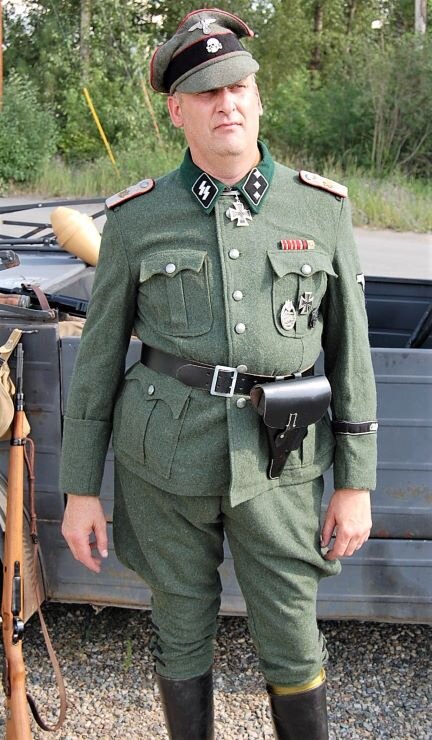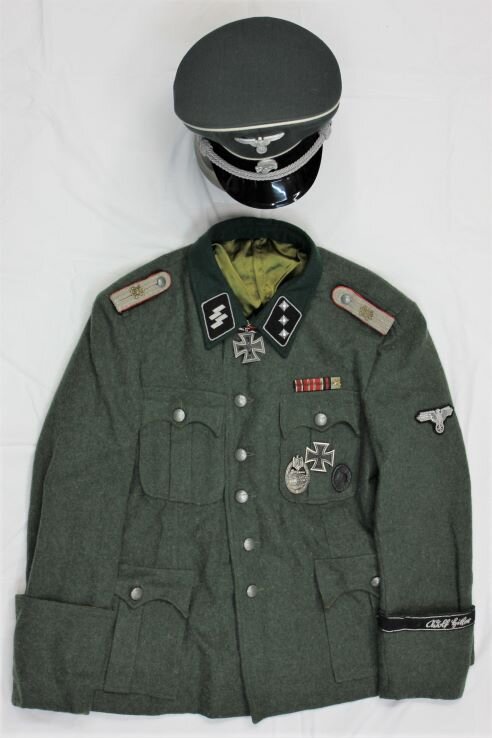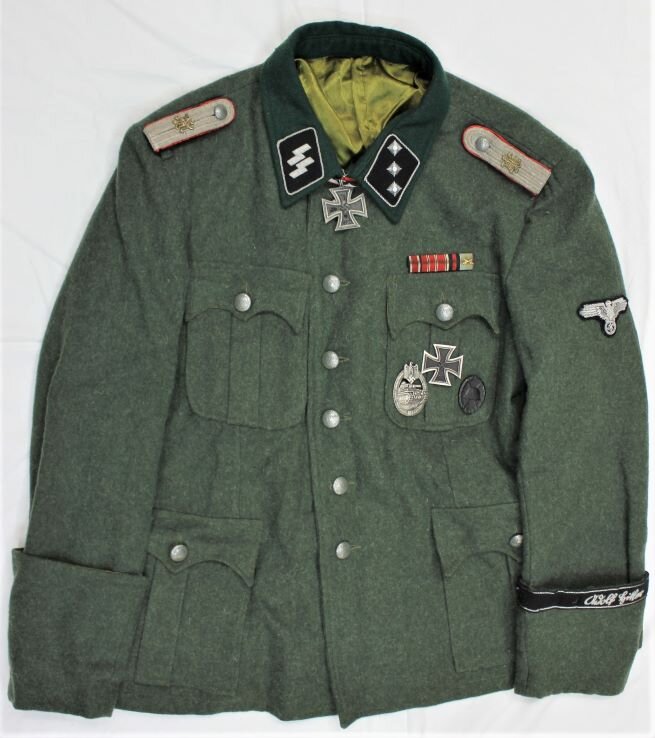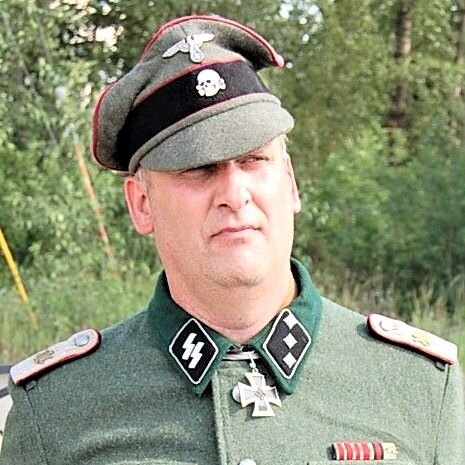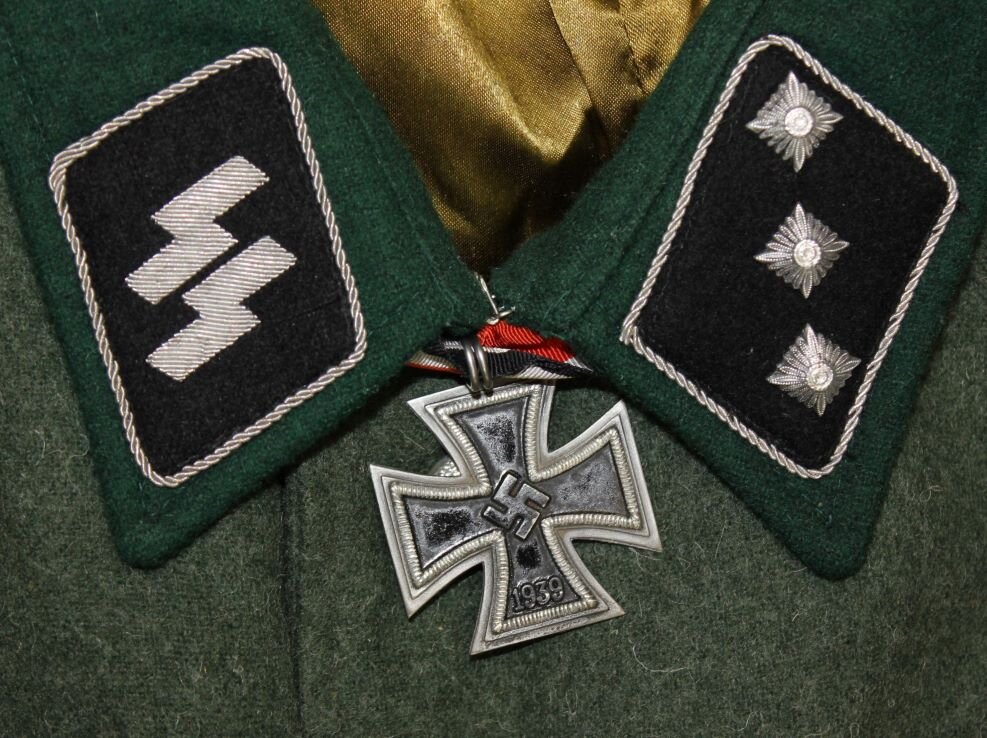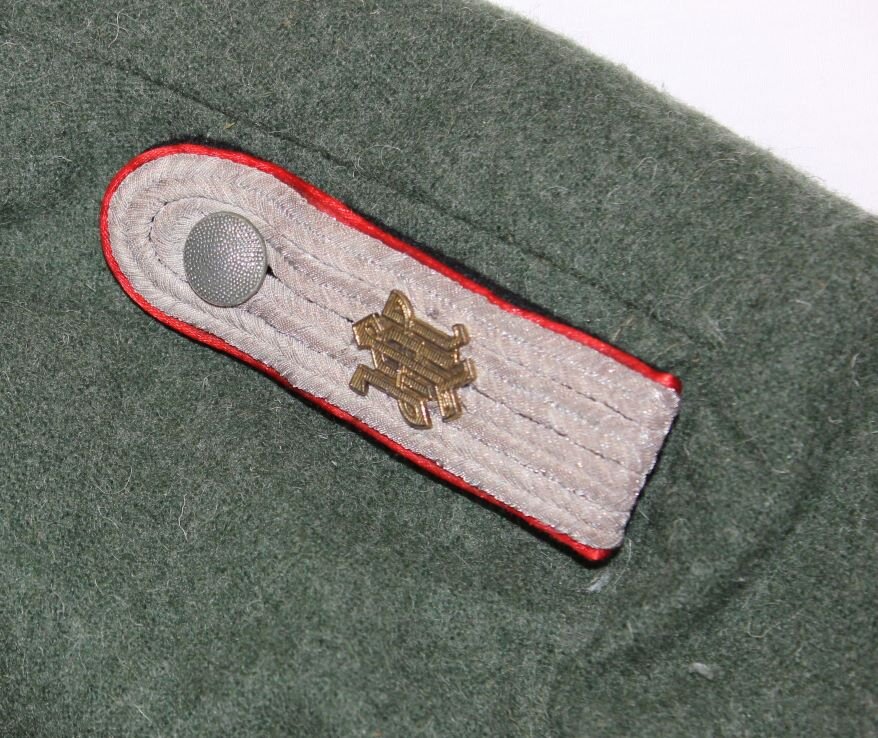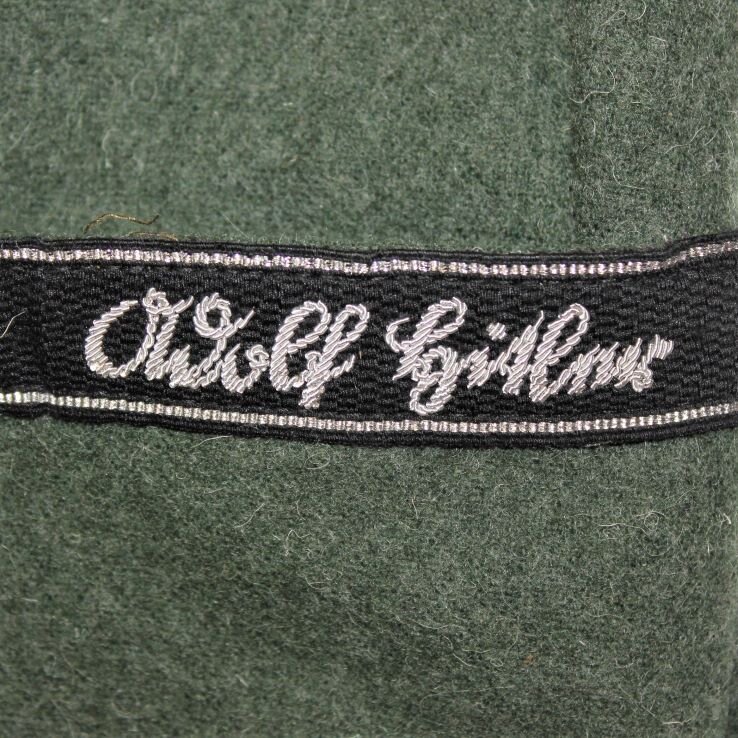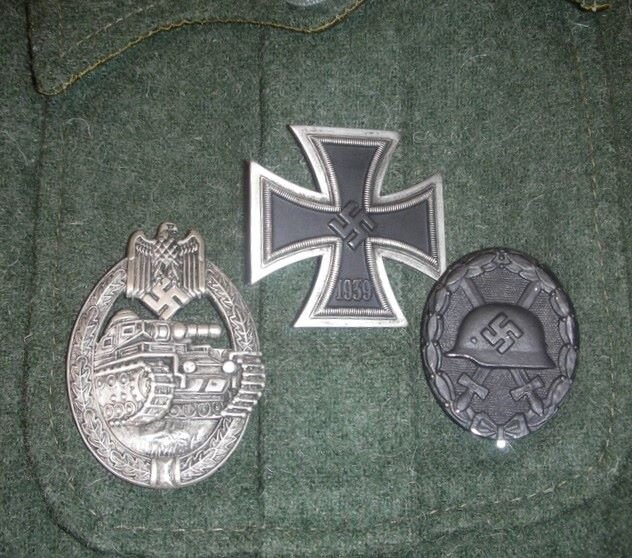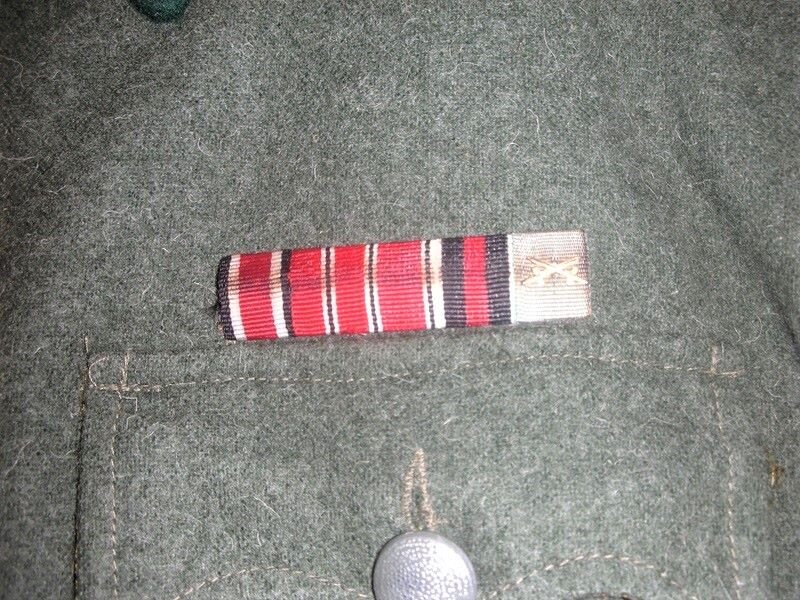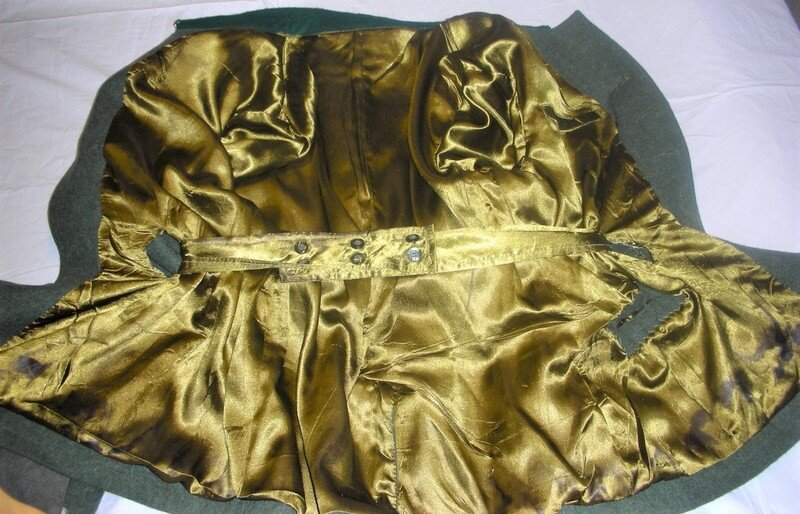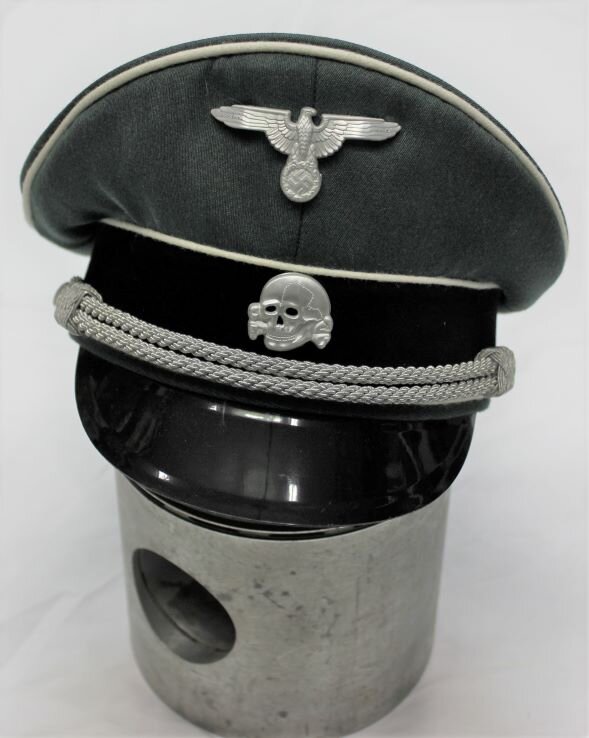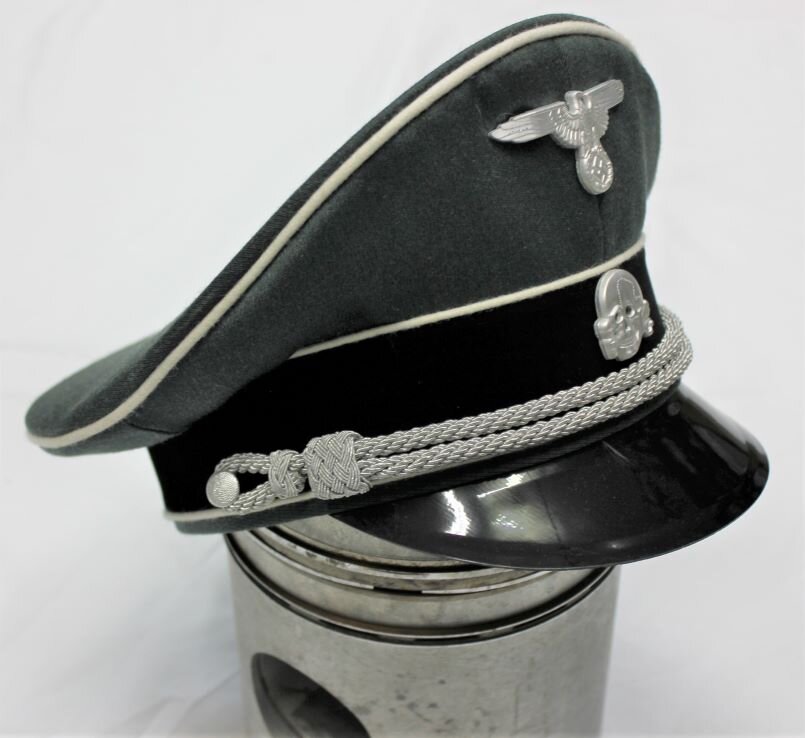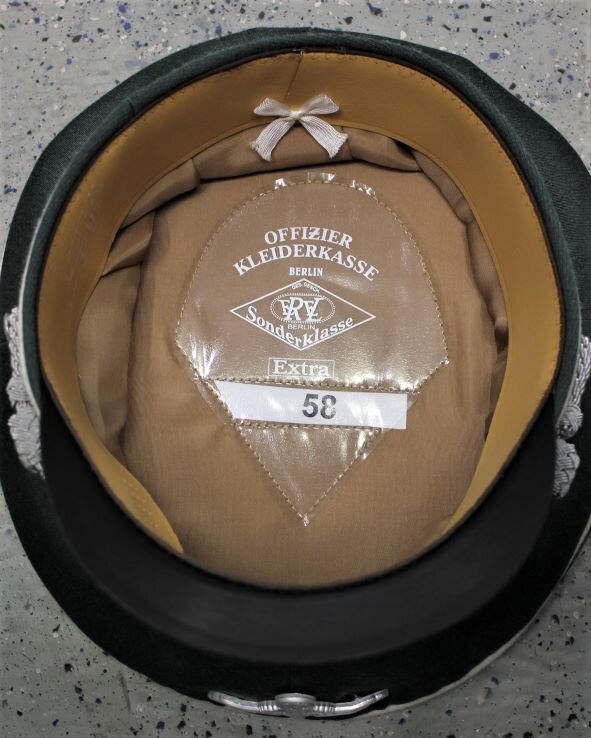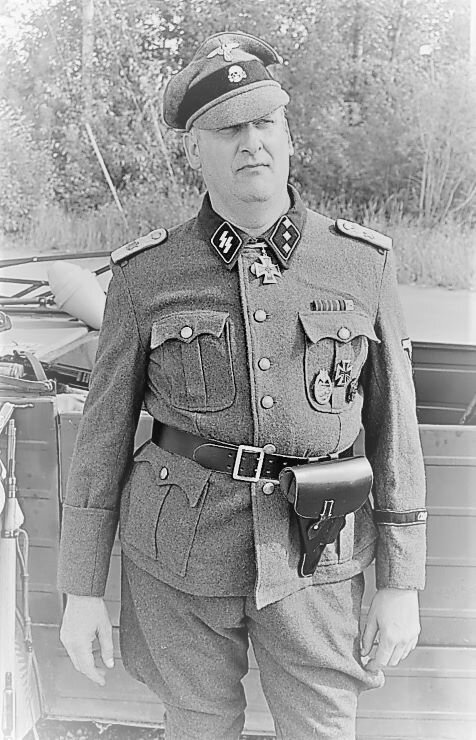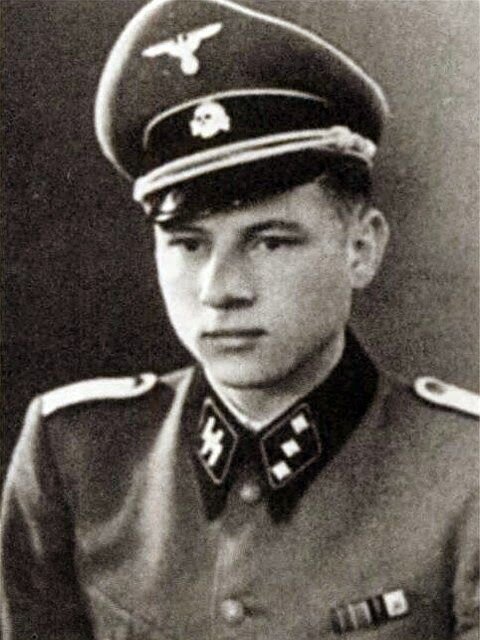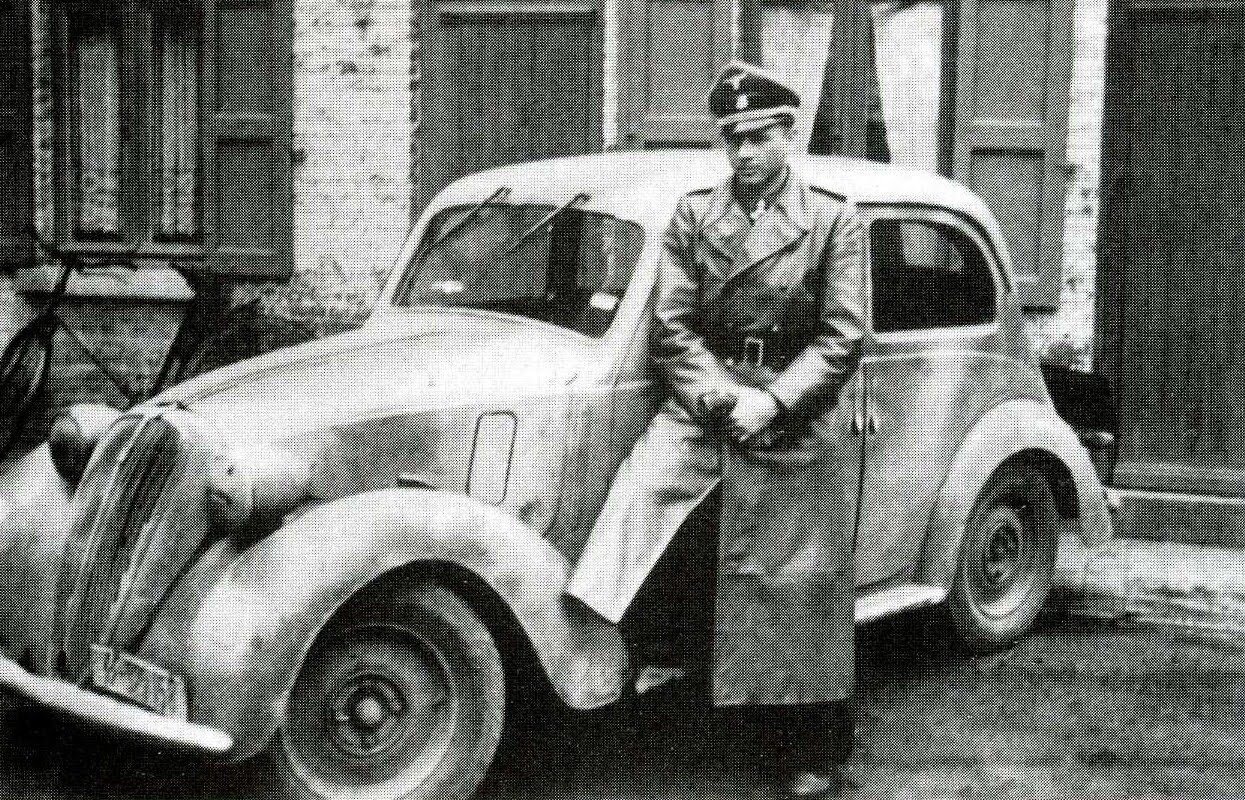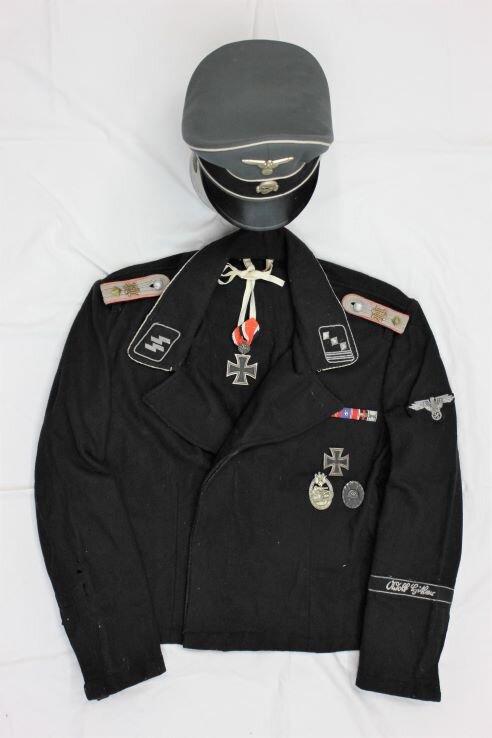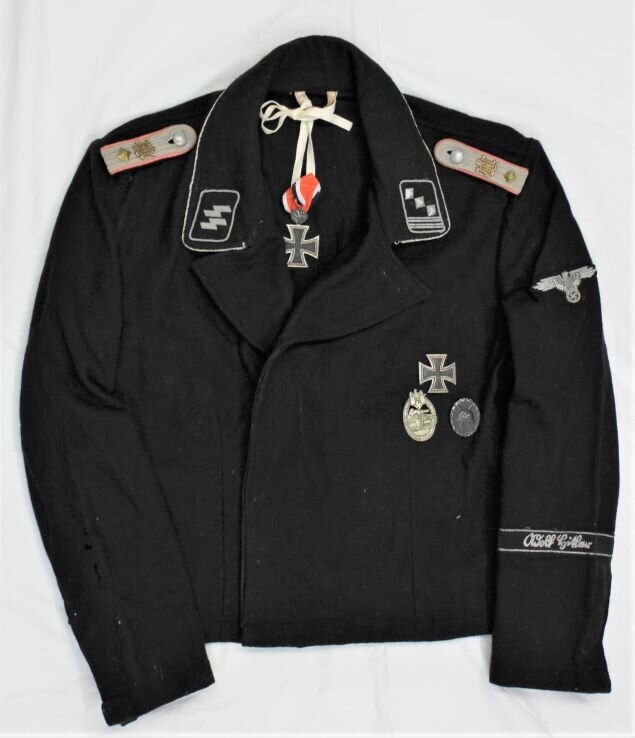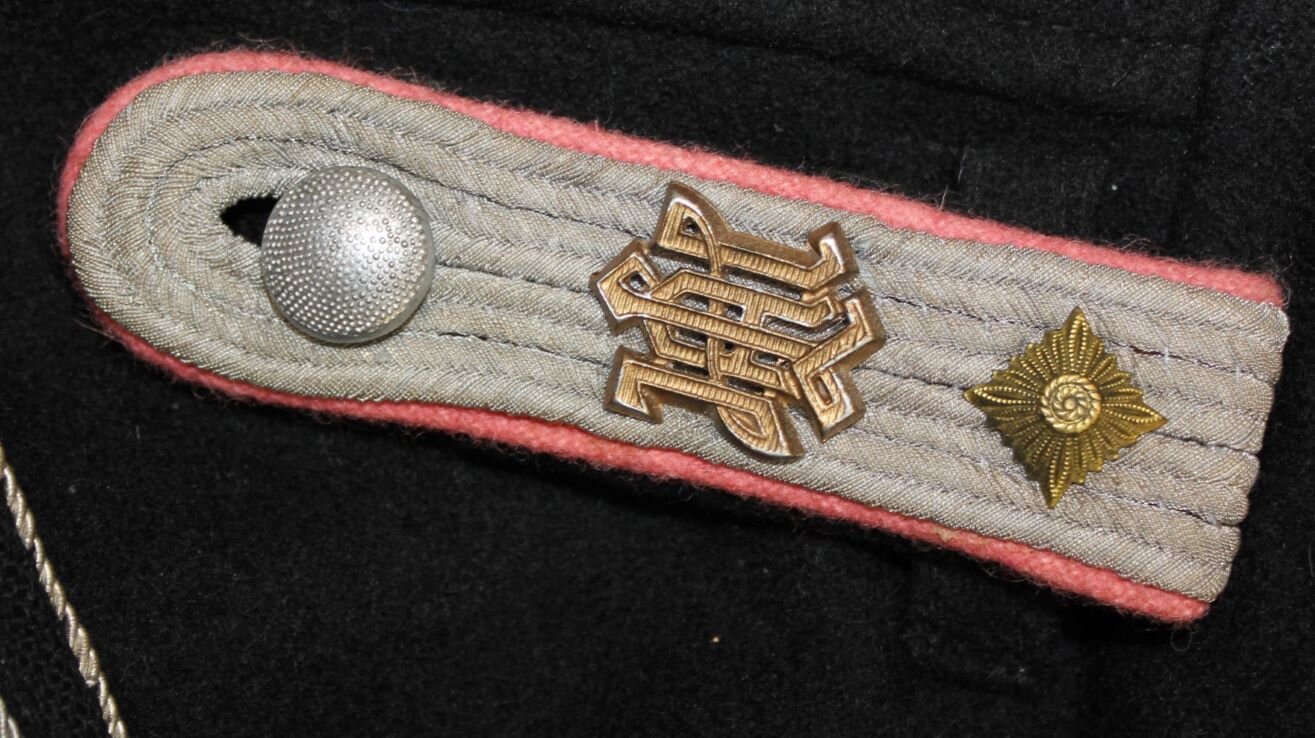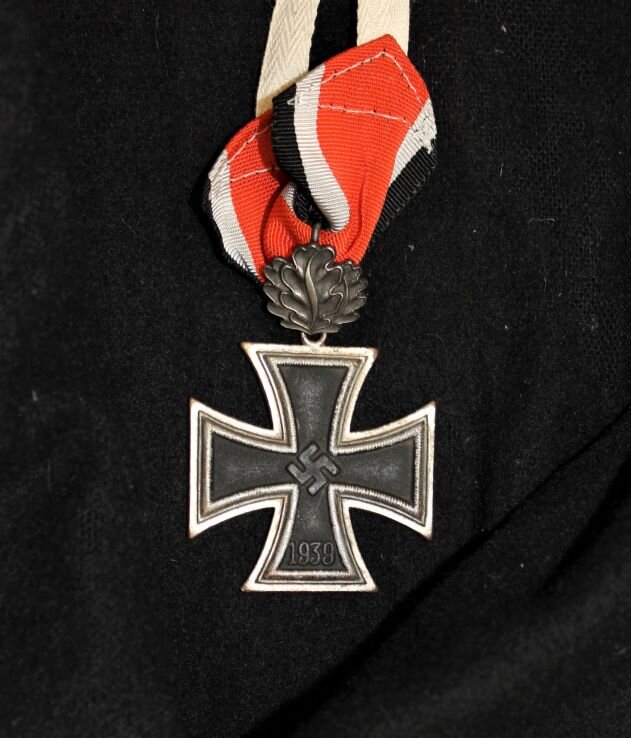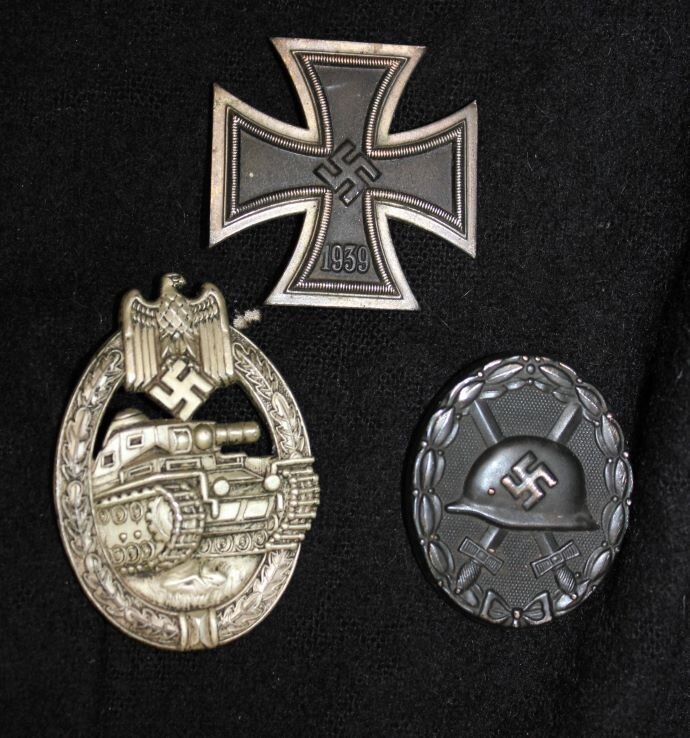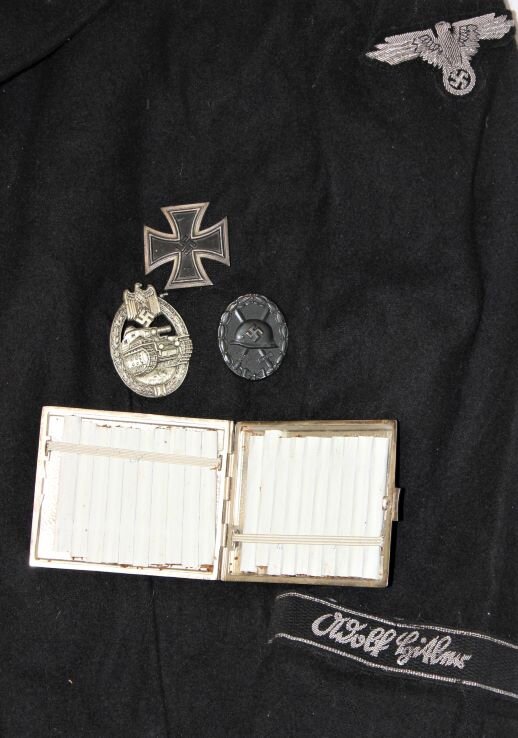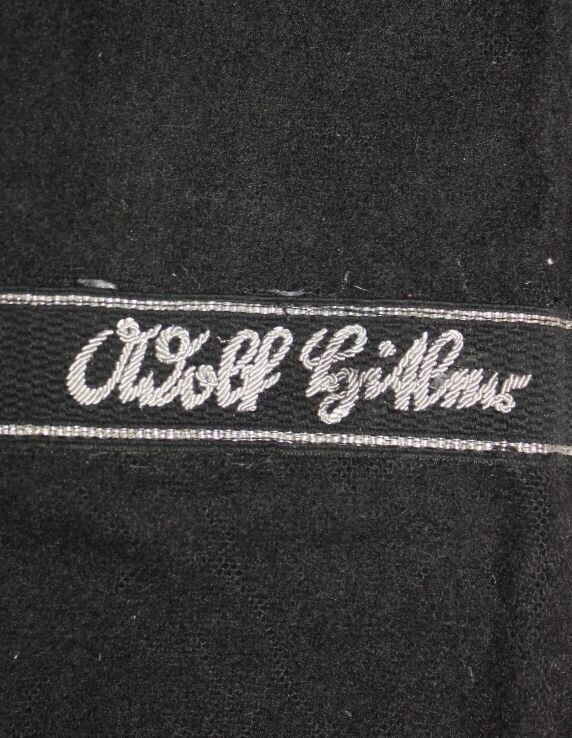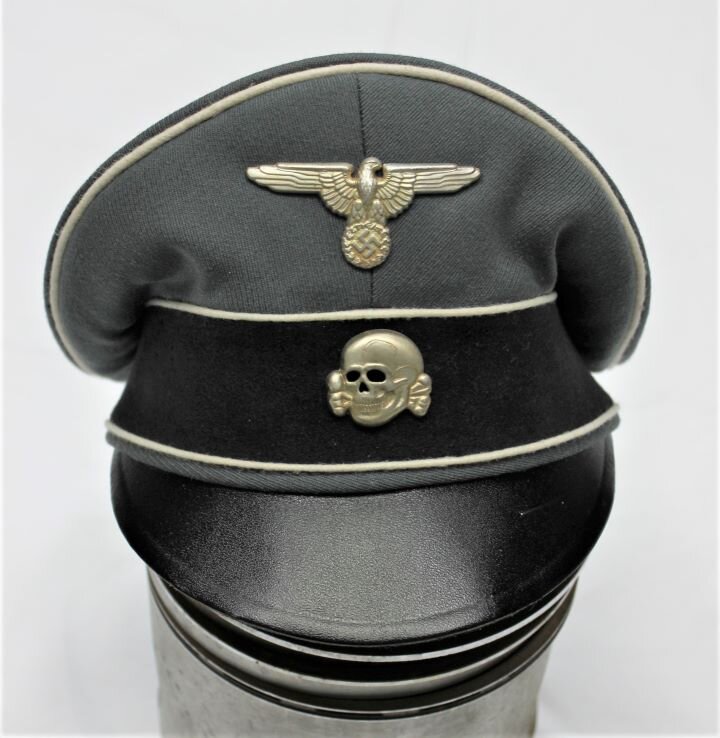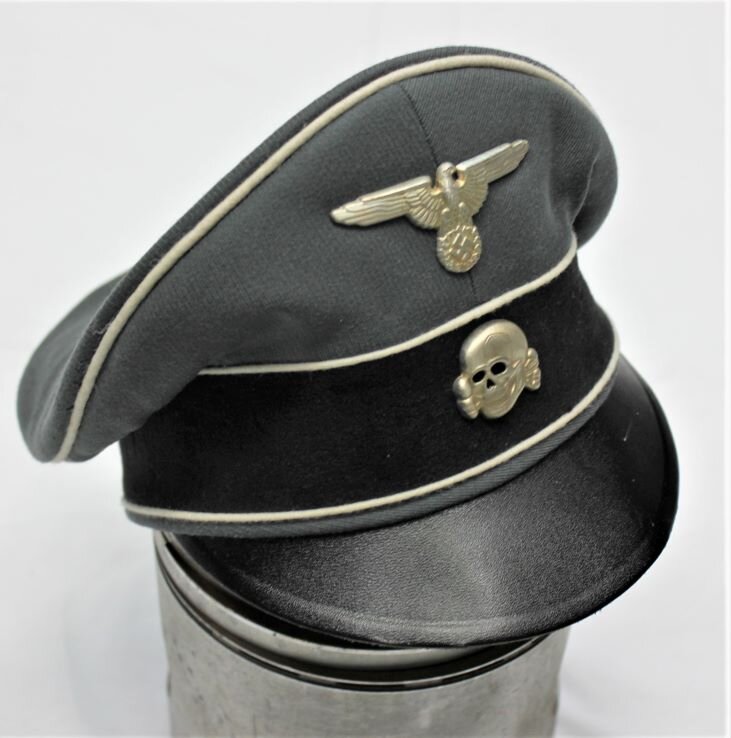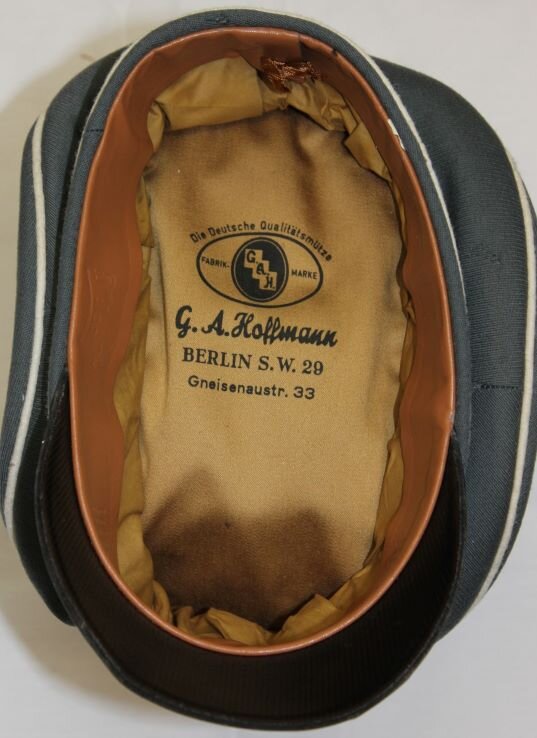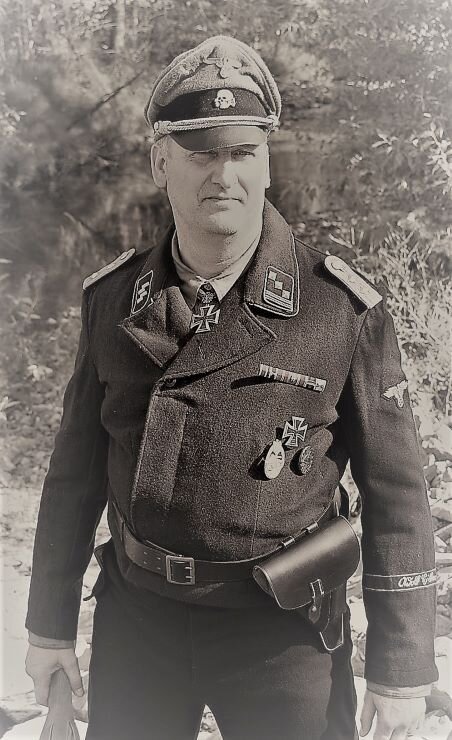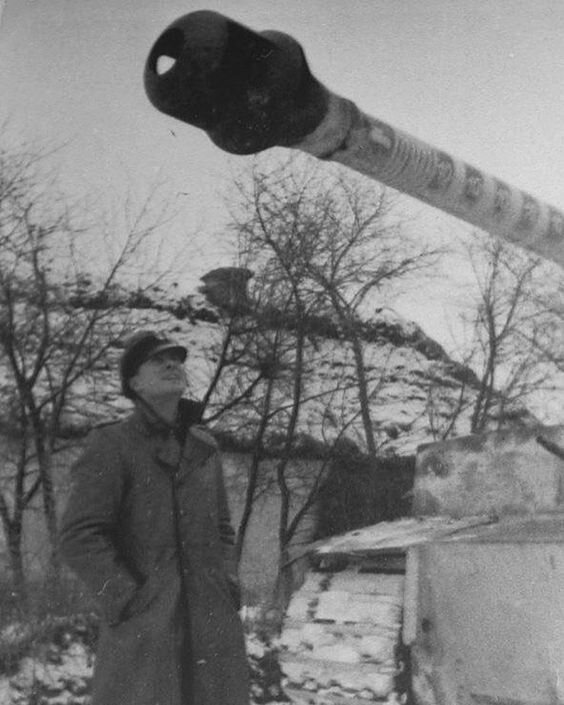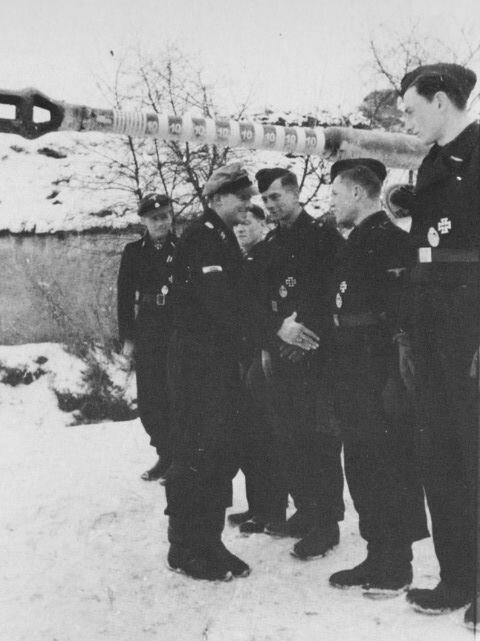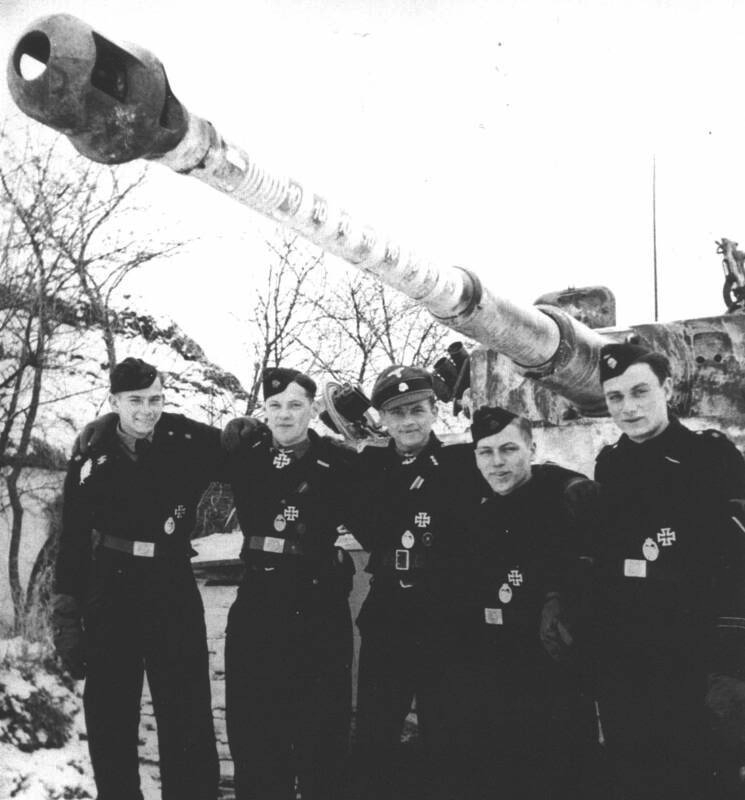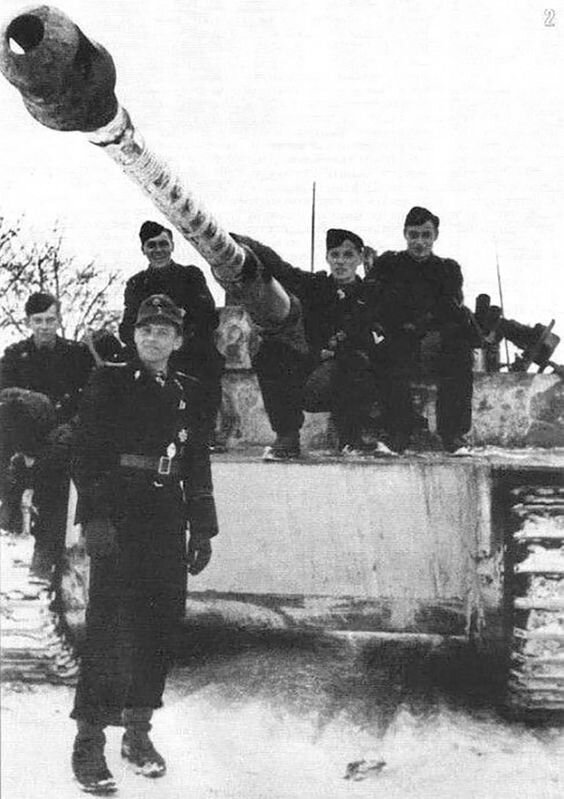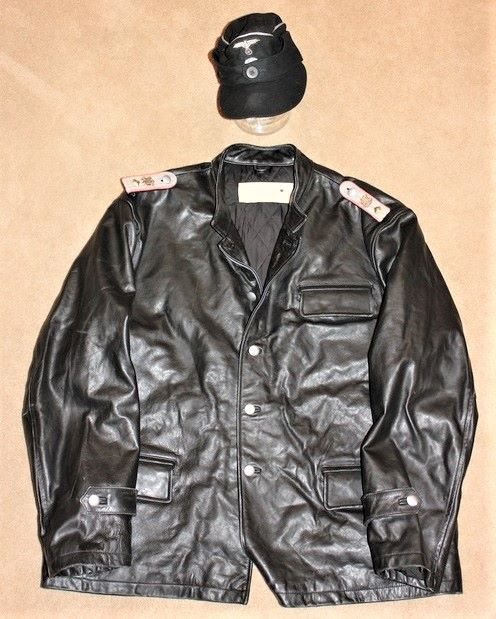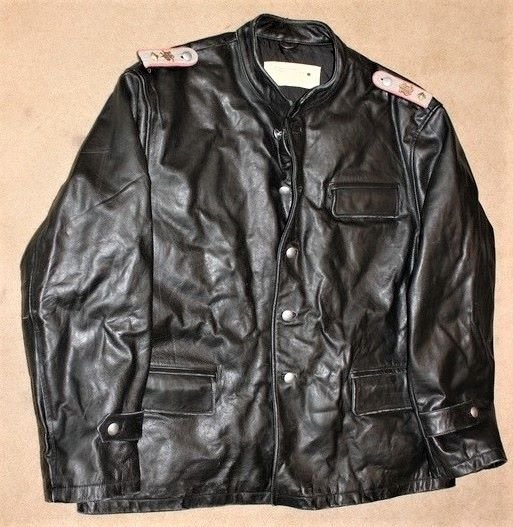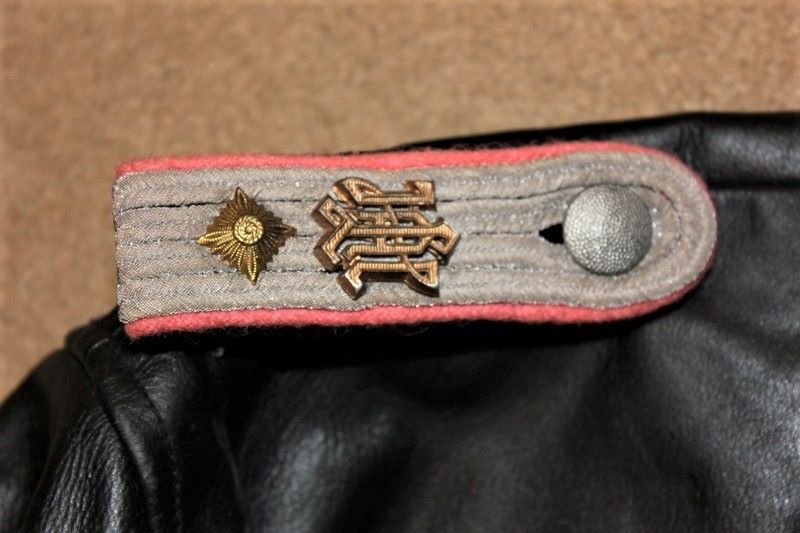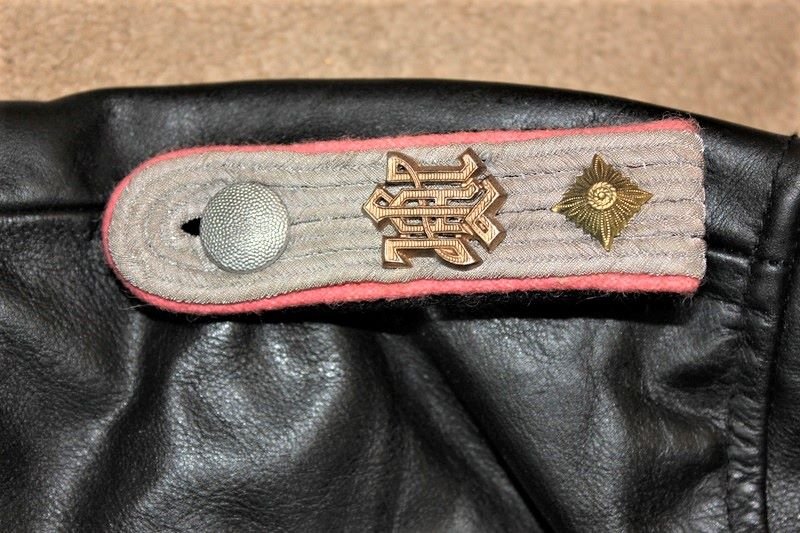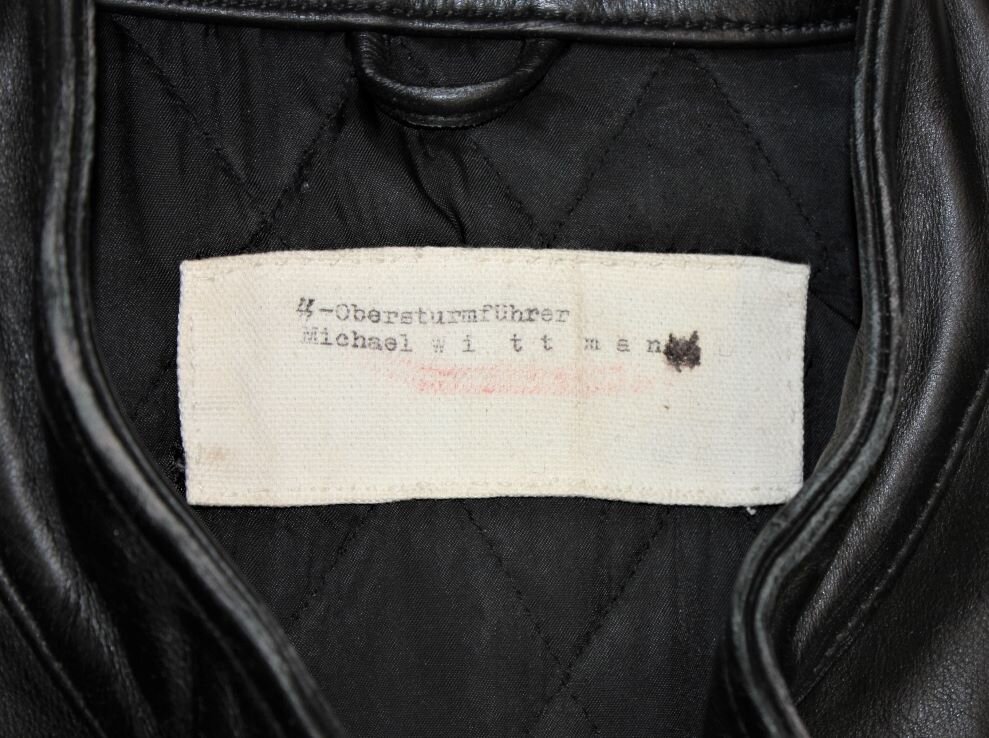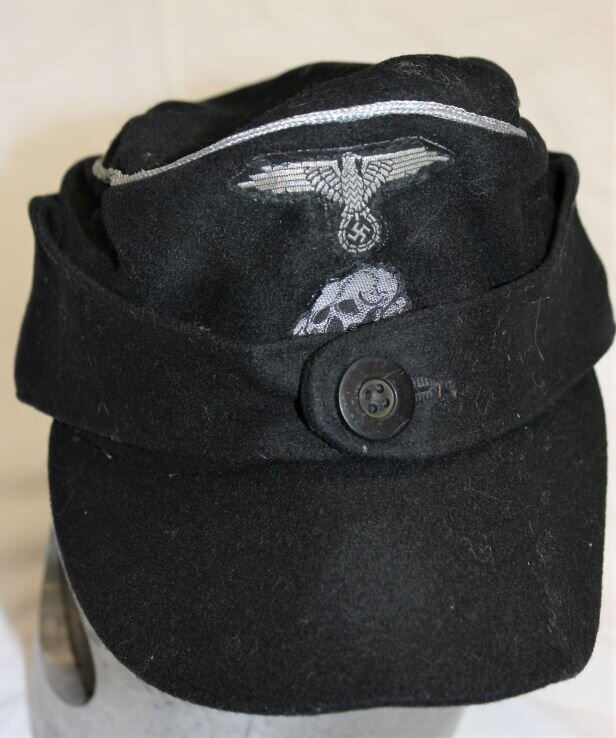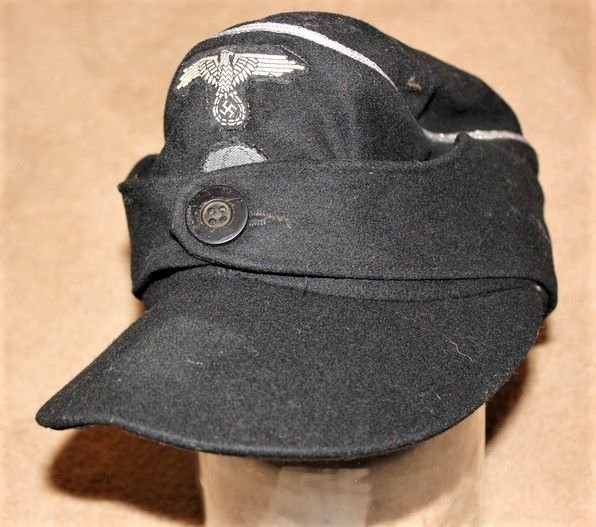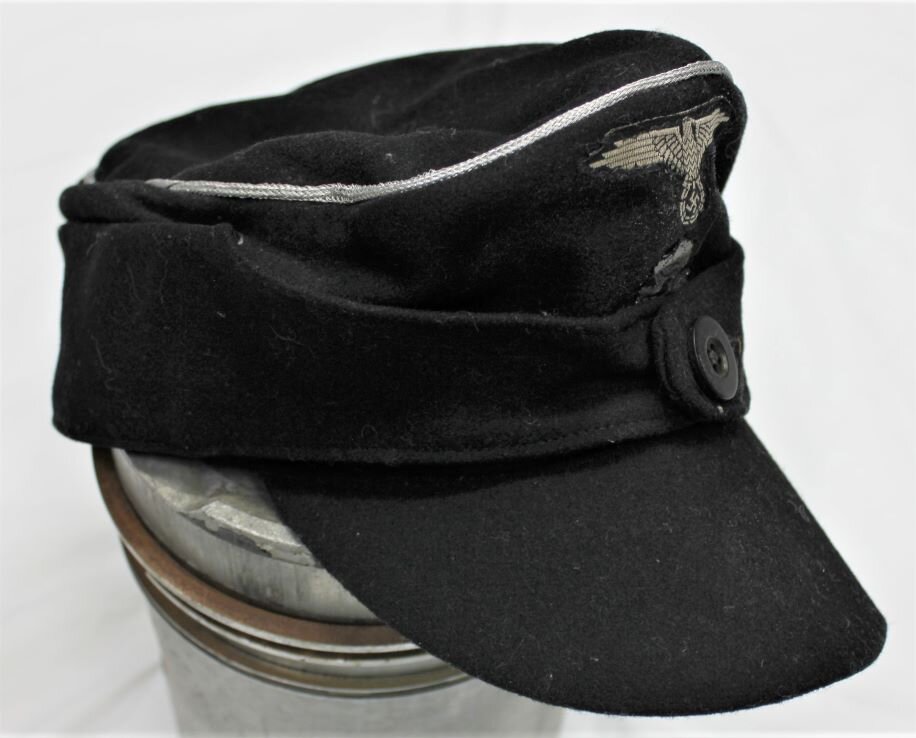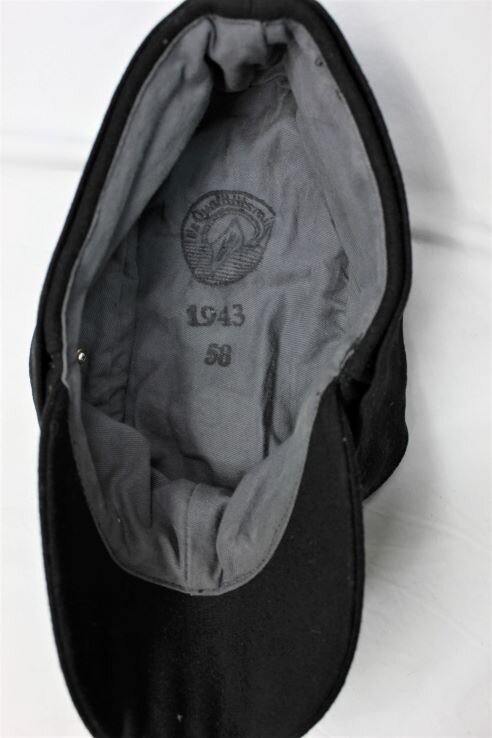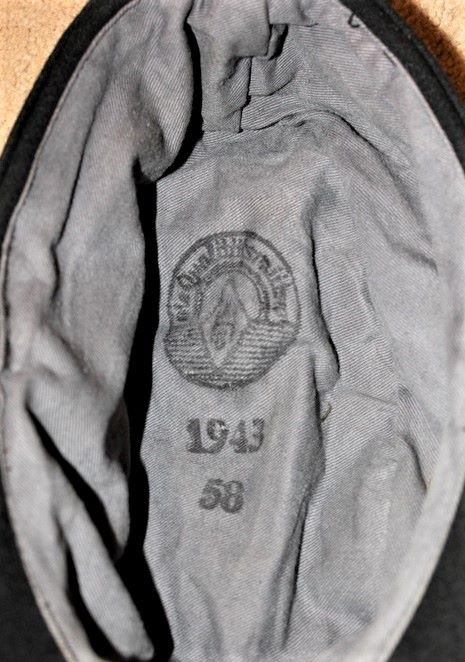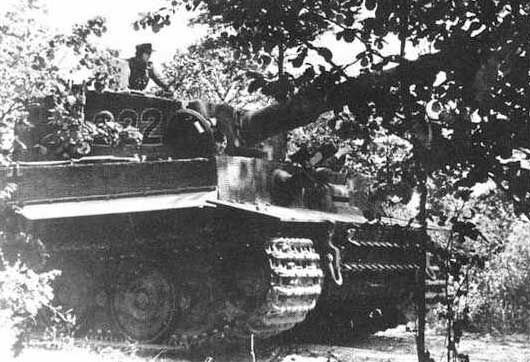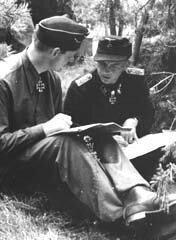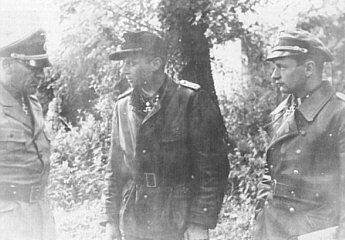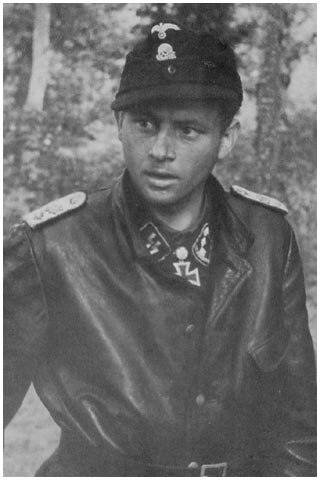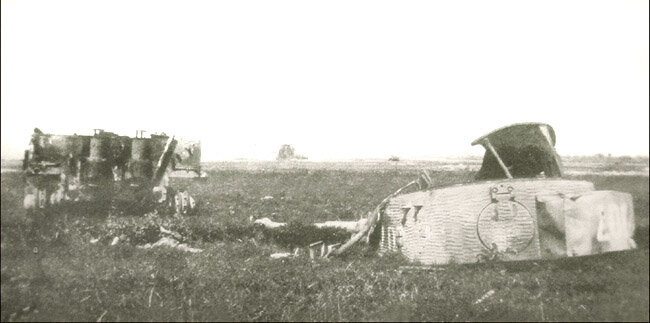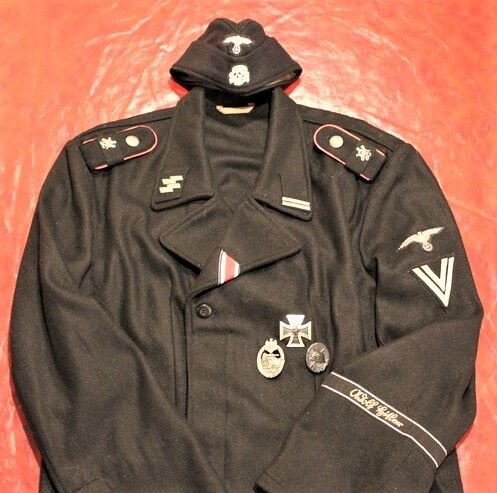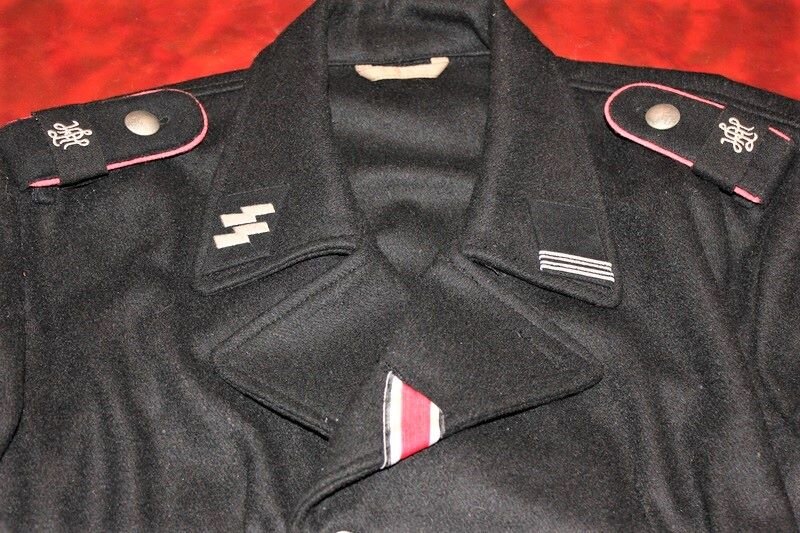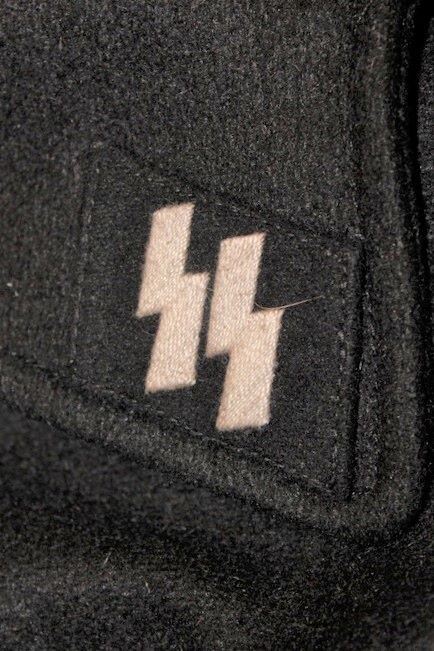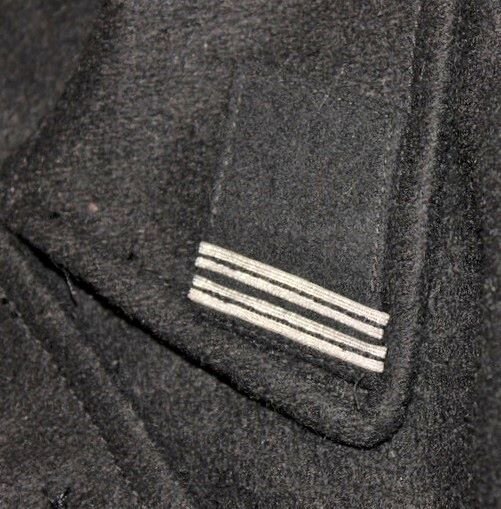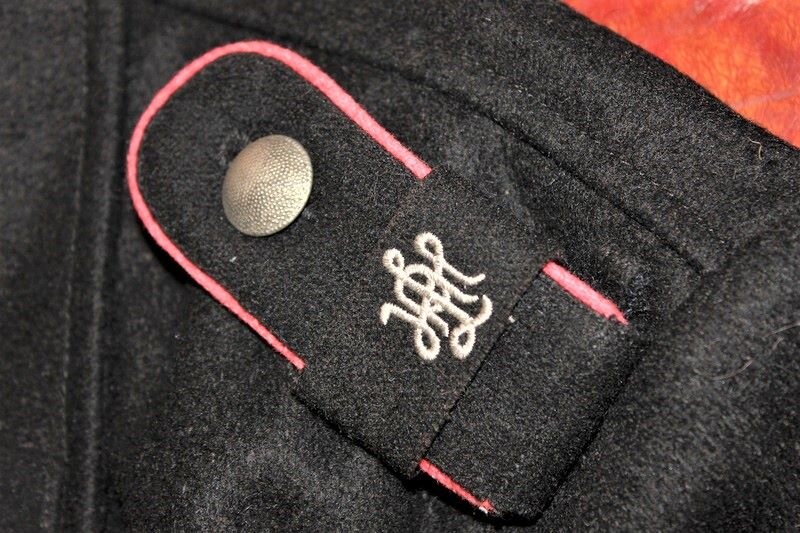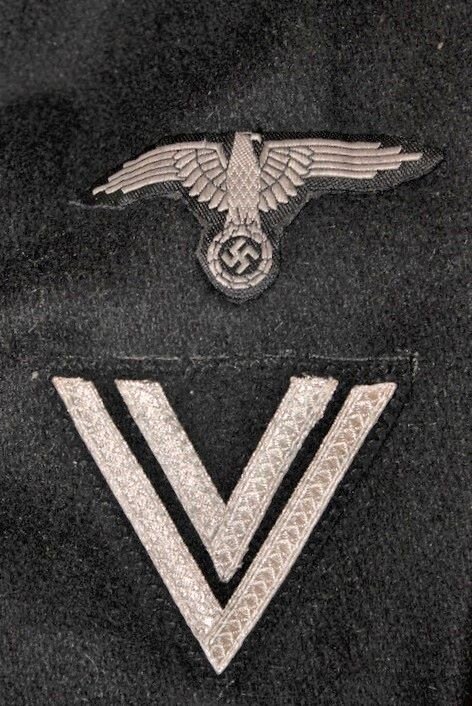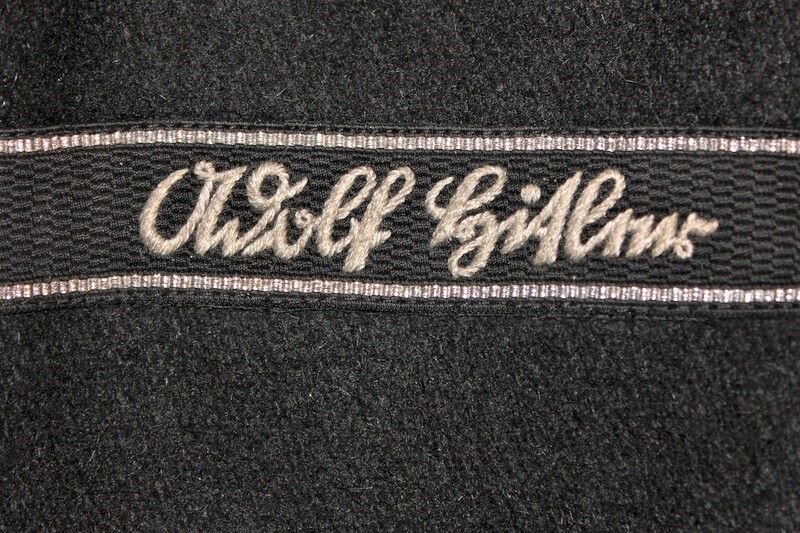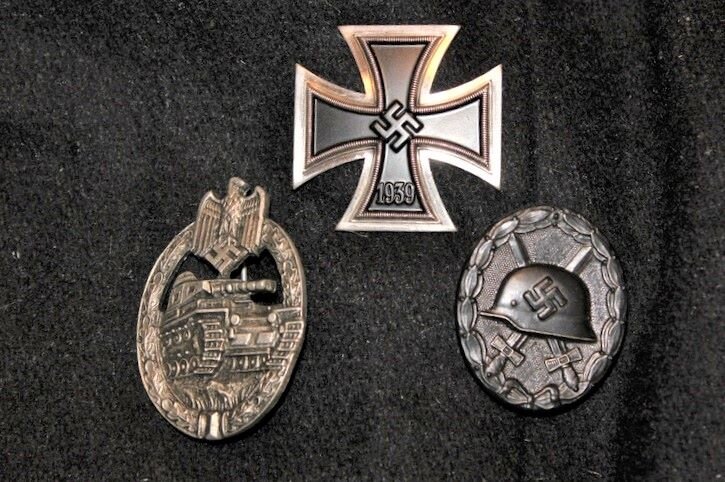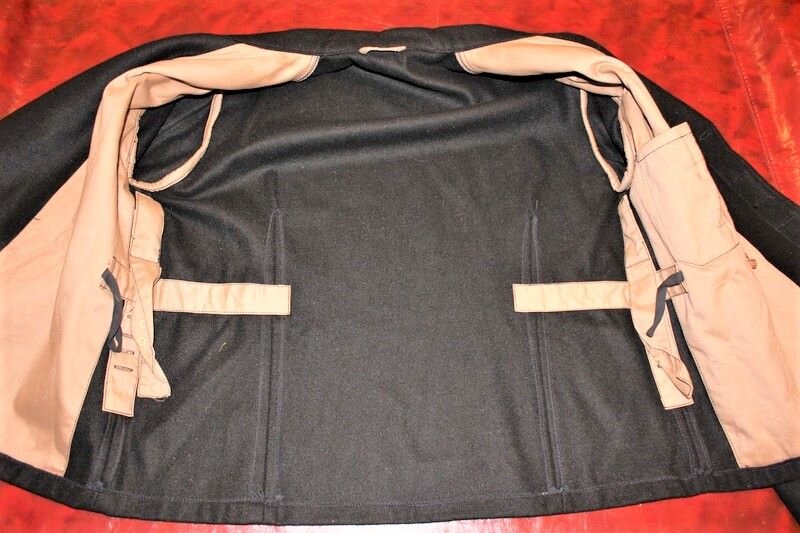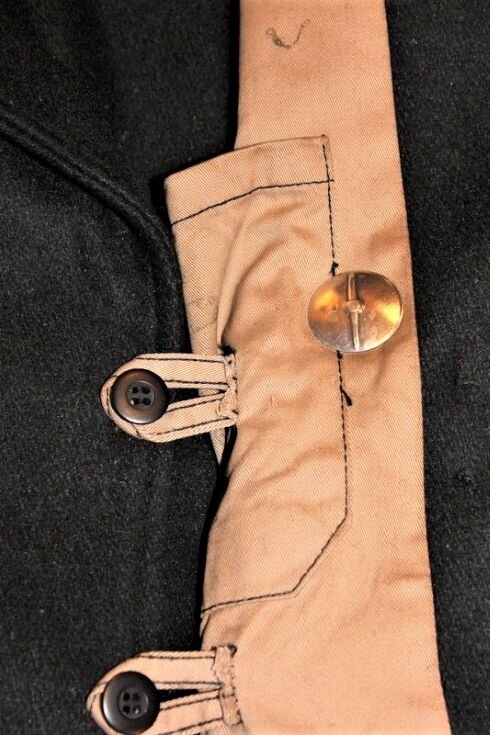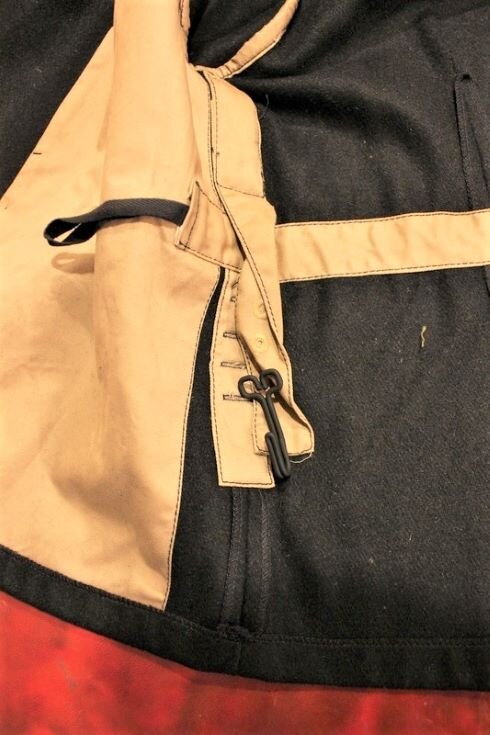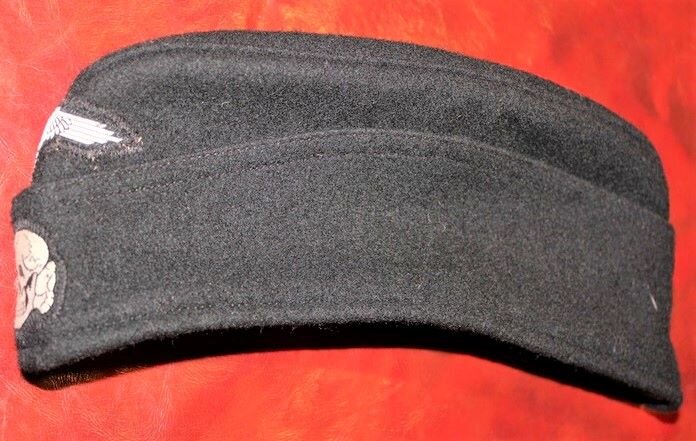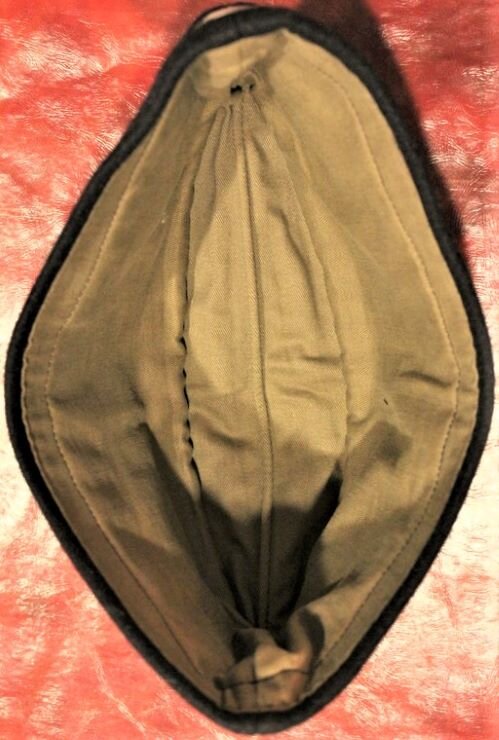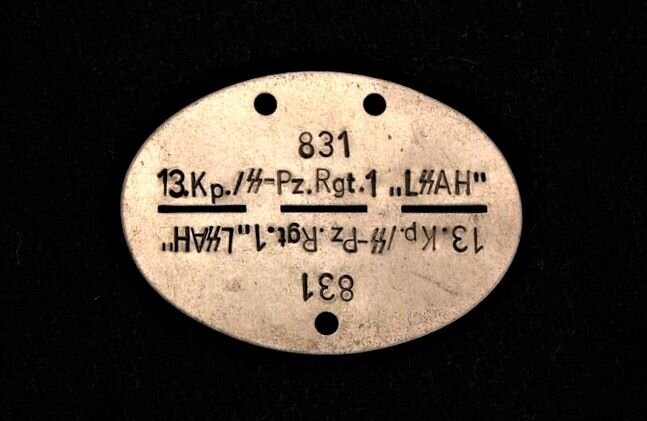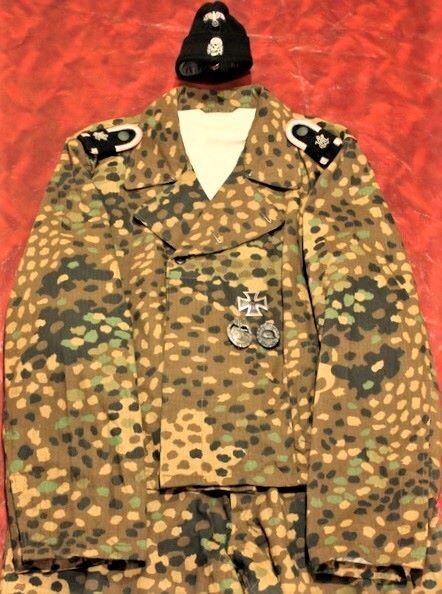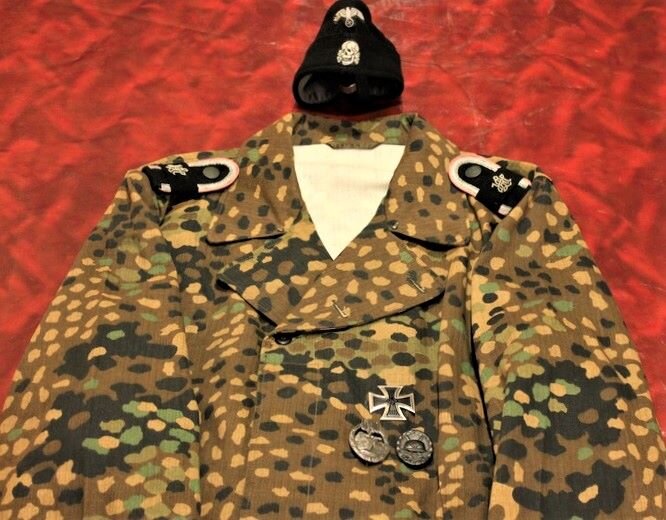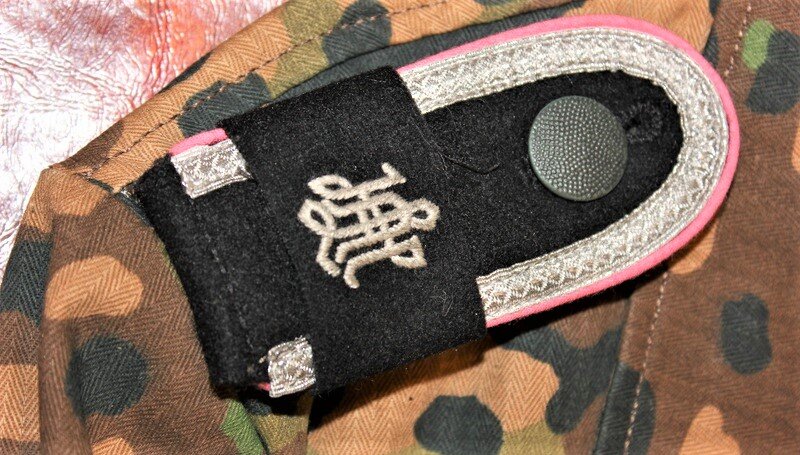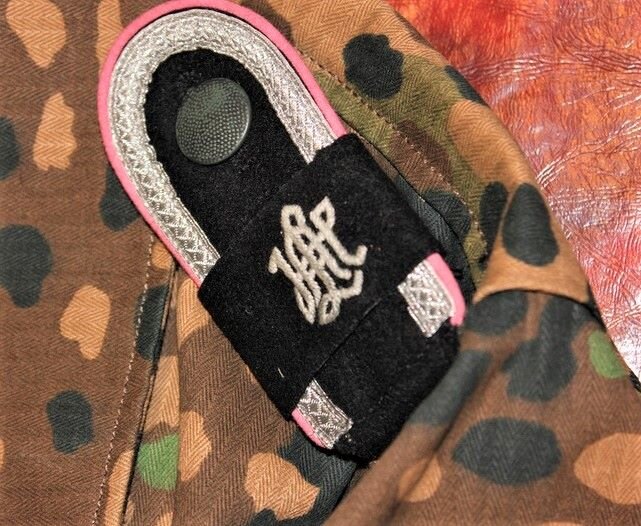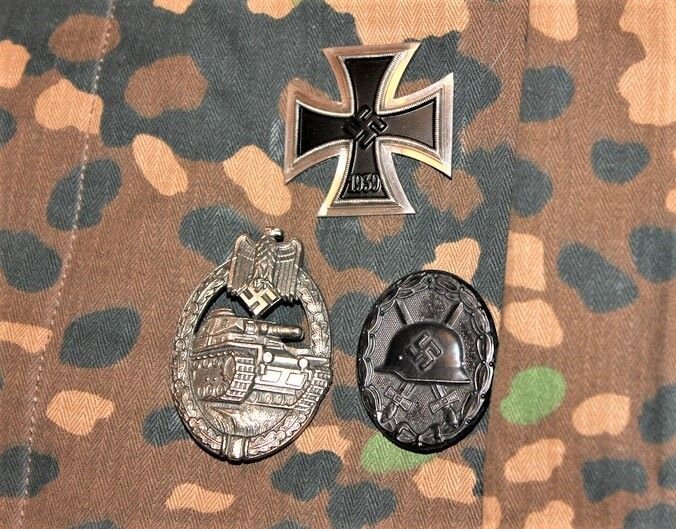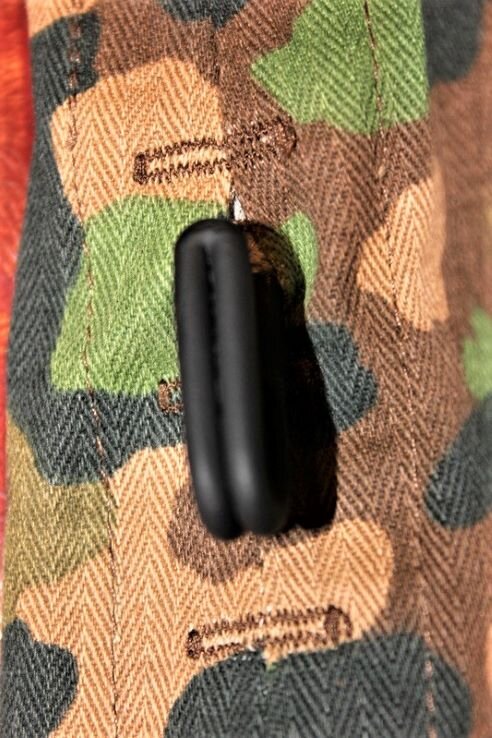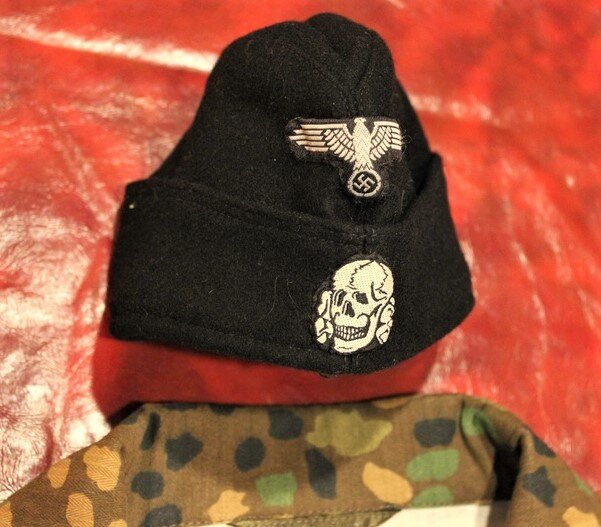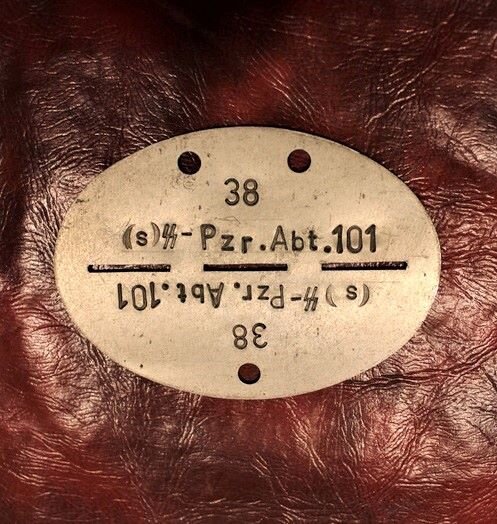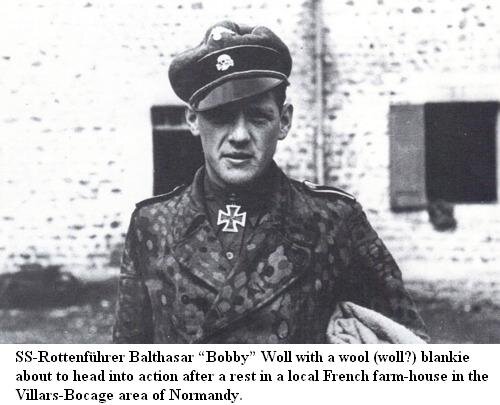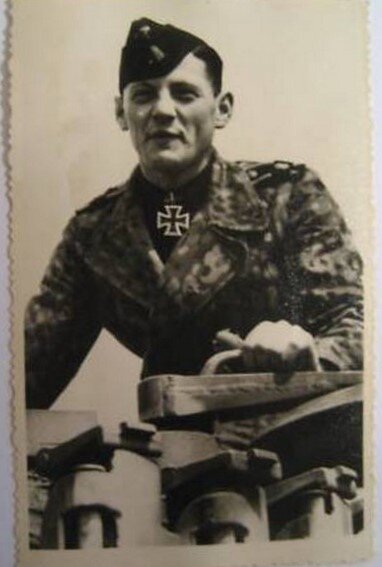Personalities of the “Leibstandarte”:
*** “New Pictures” SS-Brigadeführer, 1st SS-Panzer Division:
SS-Brigadeführer, I.SS-Panzer Division "LSSAH" Formed in 1934 as a bodyguard unit for Hitler, the 1st SS grew into a Panzer Division in Italy in 1943. The Division fought on all fronts except Africa, including the Normandy Invasion. Always in the thick of things, this division produced several combat leaders. The division ended the war on the Eastern Front. This officer's tunic is made from the standard Heer or Army field service uniform.
Officer grade bullion insignia has been added. The shoulder boards feature the gold divisional LAH ciphers, matching the cuff title. This officer served in the armored units of the First World War, like the division's premier commander, Otto "Sepp" Dietrich. His combat Leadership is proven, and he’s been awarded the Iron Cross 1st and 2nd Class for leadership under fire. Remarkably “lucky,” this man was only wounded after a very long time on the field! He has the silver bullion SS-Officer National Eagle displayed on the Left Sleeve.
This uniform is more a general representation, a genaric-Brigagefuhrer! Rather than a particular fellow, though, he does wear the Ritterkreuz with Oak Leaves and Swords at his throat. The Ribbons Bar does not show activity in WW1; however, I have the WW1 version of the Knights Cross 1st class in the buttonhole with the WW2 device above it. So I don’t know if there was a real fellow like this. It’s been all dolled up for a couple of photo shoots in the past, all having odd badges at times. The jacket also has stone gray breeches with lighter gray strips down the side. His Officers’ Cap is of fine workmanship, and he would have had black riding boots and an Officer’s belt and holstered weapon.
*** I re-shot this uniform, with normal decorations. But then the Knights Cross, with Oak Leaves and Swords, kinda limits things, and the way it's attached to the uniform, I figured a General might do it an easier way, but it’s what I’d do kind of thing. I have four prior photoshoots, and the uniform looked all different; now he's in regulation form. This is one of my early tries at making a uniform, and it was just to get one together, before I got into actually researching the matter, and depicting actual personalities, or studying photographs, to show different uniforms. There were actually three different commanders of the 1st SS Division LAH: SS-Brigadeführer Theodor Wisch, 7 April 1943–20 August 1944SS-Brigadeführer Wilhelm Mohnke, 20 August 1944–6 February 1945; SS-Brigadeführer Otto Kumm, February 1945–8 May 1945. With SS-Oberst-Gruppenführer Josef Dietrich leading it from 15 August 1938 to 7 April 1943. And…any one of them may have had a similar uniform.
*Now I just want to add a note here, while many of the uniforms in the collection did start out using what I thought was real insignia, they were not intended to represent any individual’s, and I, as a lieutenant, and captains came together, then Majors and Colonels, etc. I began to realize that the high-end officers, especially Generals, there were records of.. Not all, and many never saw any headlines or recognition for winning battles…and there were actually quite a few that little is known about anymore. But then I decided, Colonels and Generals, I’d try to make them represent some particular people. Most in my collection are unnamed, and some of my collector friends have made all that I would have wanted! They’re out there now, but I have these few still.
So this fellow’s story is one of the SS officers who got away using the Rat Line, managed to not have many pictures taken of him, and he burned all his records, went to Argentina, and from there, he completely disappeared after the war! And I’m sticking to it! Having served in the First World War and WWII, he was no spring chicken, an older fellow, but he did manage to slip away to a different life altogether for his final years.
SS-Obersturmbannführer, Joachim Peiper, l./ SS Panzer Division "Leibstandarte-SS Adolph Hitler":
Peiper's history is too long to cover in this area. He was a long-term SS officer, fighting on all fronts, surviving the war to be murdered in France in the 70s. A Knight's Cross winner with the additional awards of Oak Leaf and Swords (However, he wears only the Oak Leaves on the Knight’s Cross), Peiper was a long-term warrior of the SS.
The uniform speaks for itself, with campaigns from the Sudetenland to Russia. Peiper's awards included the German Cross in Gold, the Close Combat Clasp in Silver, the Iron Cross I and II Class, the Infantry Assault in Bronze for Armored Infantry, and the Tank Destruction Badge. Say what you will of the German-SS of WWII, Peiper has all the infantryman’s respectable awards, and none came easy, though it does help to know people in high places.
The uniform insignia is all officer-quality embroidery. Matching black wool panzer trousers were worn with the SS-style cut jacket. This uniform is matched with a panzer piped Schirmmütze.
SS-Sturmbannfuhrer, Gustav Knittel, SS-Panzer Afklarung Abteilung 1, “LSSAH”:
Gustav Knittel joined the NSDAP on the 1st of May 1933. He received party number 2 242 615. He enlisted in the SS on 15 April 1933 with service number SS NR 111 507. Knittel attended the SS-Junkerschule Bad Tolz as an SS-Officer Candidate on the 1st of October 1937 and successfully took his final exams on the 28th of July 1938. He was awarded the rank of “Untersturmführer” and assigned to SS-Regiment “Deutschland”. He took part in the occupation of the Sudetenland. He served with various SS units before becoming the Adjutant of “SS-Reserve Bataillon” “Ellwangen” in August 1939.
Knittel was awarded the Eisernen Kreuz II Klasse u. Infantrie Surm Abzeichen in June 1940 for his role as Zugführer of the 15. Kompanie “LSSAH” during the Battle of France. After “LSSAH’s” actions in the Balkans and “Operation Barbarossa” (The Invasion of the Soviet Union), Knittel was awarded the Eisernes Kreuz I. Klasse u. Winterschlacht im Osten for combat in 1941/42. In April 1943, he was appointed Bataillon Commander of 1. SS-Panzerauflarung Bataillon “LSSAH”, where he won both the Nahkampfspange in Gold and Deutsche Kreuz in Gold u. Ritterkreuz in 1944. Knittle was wounded during the “Wacht am Rhein” (the Battle of the Bulge) and was still convalescing at the time the war ended.
SS-Sturmbannführer Knittel was photographed wearing a very rare panzerjacke during the Battle at Kursk, not because it was camouflaged, but because this pattern was short-lived and used in the early years of the war, and this “brown-side” was being used rather than the other green-side, which was seen far more often, albeit a very early pattern. Called the “German Tiger-Stripe” pattern print by some, the Englishmen feared the SS in their Leopard suits; it is not clear if the jacket was made in the field or as a factory-produced item; his helmet is of a bit of a different pattern too, and I assumed brown side out. While the common picture of the Waffen-SS Mann storming across the France, Poland or the Russian Steeps in one of the Oak of Blotch pattern “Spring-Side out” (Green Shades) rather than the “Autumn (Brown) side”, Battlefields tend to be muddy, messy places, with all the trees blown up and burned, if not coveren in soot and ash, the sping thaw was a muddy situation, and often in the fall period as the leave fell, and winter snow started the brown camouflages came in real helpfull.
Like most SS men, Knittel uses standard insignia items on the uniform instead of regulations that state the use of the specifically designed Heer/Waffen-SS woven sleeve rank on camouflage uniforms. Interestingly, it appears he used enlisted pattern collar ranks with pips added and officer-grade shoulder boards applied; they’re piped in the golden-yellow Afklarung Waffenfarbe. He also wore Fall/Oak pattern camouflaged trousers with Panzer-Boots completing the uniform.
*Ritterkreuzträger, SS-Hauptsturmführer Rudolf von Ribbentrop, 6./SS-Panzer-Regiment 1, LSSAH:
Rudolf von Ribbentrop was the son of the German diplomat and Foreign Minister Joachim von Ribbentrop. His father was a party member, so like many young German sons, he wanted to make his family proud, to be sworn in to the SS, and become a full-fledged Nazi, and serve his Führer.
First given command of a platoon in 1. Kompanie in the Aufklärung Bataillon “Nord" fighting in Finland. Wounded a second time, upon recovery, he was re-assigned to the newly formed Panzer Regiment 1 “LSSAH” on the Ost Front. On 15. Juni returned to field command and was appointed commander of the 6. Kompanie. Fighting and being wounded yet again, Ribbentrop was awarded the Ritterkreuz for leadership and bravery in July 1943.
In August, “LSSAH” transferred officers and NCOs to become the cadre of the newly formed 12. SS Panzer Division “Hitlerjugend”. Ribbentrop was put in command of two Junior officer training courses. Four months later, he was appointed commander of the 3. Kompanie, I./SS-Pz.Rgt. 12. On 3. In June 1944, heading back to Le Neubourg following a training exercise, his car was attacked by a Spitfire, and von Ribbentrop was wounded for the fourth time.
By 9 June, he was back in command of his Kompanie. During the defensive battles in Normandy, Ribbentrop was awarded the Deutsches Kreuz in Gold and the Panzerkampf Abzeichen. Following the breakout from Falaise, von Ribbentrop was made the Regimental Adjutant to SS-Panzer-Regiment 12. It was in this capacity that he saw action during Operation Wacht Am Rhein.
On 20. In Dezember, he was wounded for the fifth time by a shell fragment in his mouth. He was given command of I./SS-Panzer-Regiment 12. He commanded this Abteilung until the division surrendered to the Americans on 8. May 1945.
These uniforms were made from Russian cotton cloth. An “Ost-Bluse” very well may have been worn by von Ribbentrop, as it was by many others. It is worn here with a Feldmütz für Offizier.
*The uniform is fictional, really, as there is no photographic evidence at this time. I could well have represented several LAH Panzer Officers, though. I need to add the Knight’s Cross and get some pictures of it. So, ya, the uniform is created with loads of Artistic License, as no one knows if he actually ever had such a uniform, but he could have; he was certainly one who could have acquired one.
SS-Hauptsturmführer, ‘Theodore Wisch’:
Theodore ‘Teddi’ Wisch was born at Wesselburener Koog in Holstein on 13 December 1907. He joined the SS in 1930, and after serving for some time as an NCO in SS-Standarte 53, we were commissioned an SS-Sturmführer in July 1933. By this time, he was attached to SS-Sonderkommando Berlin. In October of that year, he was further promoted to SS-Hauptsturmführer, and by the outbreak of World War Two, he was in command of 1. Sturm (Company) of the ‘Leibstandarte SS Adolf Hitler’. During the Polish campaign, Wisch won both classes of the Iron Cross. Later, he wore the Knight’s Cross of the Iron Cross, with Oak Leaves.
SS officers had the option of purchasing formal-dress uniforms such as this Mess-Dress, a civilian-like cut tail-coat (without the tails) worn with a white shirt and black bow tie (See his Post-War picture), and a waistcoat (Comberbund). While there is no photographic evidence of “Teddi” actually wearing one, it represents him, so once again I may have made something of not, but he would have been one of the few to actually wear one of these” Tuxido” outfits! He had some money, was popular, and was a highly decorated officer who had been present before the Führer several times and at special events. This uniform also featured silk-faced lapels, SS shoulder boards, collar patches, a Totenkopf Breastpin (only ever used on this type of uniform), and white piping (broad silver-grey trouser stripes of general officers). Officers were also permitted to wear the white SS service cap with this uniform. The uniform is shown as it would have appeared at the end of the Polish Campaign, with his newly awarded Iron Cross I and II as well.
SS-Unterscharführer, Franz Staudegger, SS-Panzer-Regiment 1 ,,LSSAH”
Franz Staudegger was born on 12. In February 1923, in Austria, one of four sons of a Gasthaus owner was born. He finished school in Klagenfurt in 1940 and immediately joined the SS. He was as signed to Infantarie Erzatz Batallion 1 ,,Leibstandarte Adolf Hitler”. Following a combat wound, he was selected in 1942 to train to become part of the expanding Waffen-SS Panzer regiments 1942. Rejoining the newly designated 1. SS-Panzer Division, he first fought in a Panzer III and later, following promotion to SS Unterscharführer, he was appointed commander of a Tiger. Staudegger epitomized the SS leader. Brash was often near reckless, leading from the front, demonstrating bravery.
Much like his Kompa nie Kommandant Michael Wittman. Unternehmen Zitadelle, or Operation Citadel, the Battle of Kursk, found Staudegger slowly moving his Tiger down a forest road. Suddenly, a small light lit up the area, exposing another tank halted on the road; its commander was just standing there in his turret, smoking. Staudegger got out of his Tiger to yell at the idiot blocking the road and for his lack of light discipline. The sounds of the tank motors overcame his voice, so he jumped from the turret and ran to the other tank. He reached the other tank, discovering it was a Russian T-34. Staudegger’s infantry training, however, took over. he took one of the grenades he was carrying and threw it at the T-34 hatch. It fell inside, and the detonation illuminated yet another T-34 standing behind the first one.
Staudegger realized the other crew would hear the explosion, shouted a warning to his own Tiger crew, and quickly proceeded to climb on the other T-34. When the other Soviet crew opened the hatches to see what was going on, Staudegger threw another grenade inside, destroying the second Soviet tank. Staudegger returned to his Tiger and resumed movement. The very next day, he was awarded the Eisernes Kreuz I. Klasse. Operation Citadel was the largest tank battle in history. Even as the German forces fought,t they suffered casualties, tanks were damaged and were recovered. Front-line workshops worked 24-hour shifts to get the Panzers back into the battle. Staudegger’s Tiger was waiting to be repaired, and 8 Juli was unable to participate in the upcoming attack. Around 1000, a message notified the repair company that a Soviet assault force of 50-60 tanks was approaching from the northwest. Staudegger and his crew, Herbert Stahlmacher – driver, Gerhard Waltersdorf – radio operator, Heinz Buchner – gunner, and Walter Henke – loader, would perform some field repairs and meet the threat head-on.
Moving slowly on a compromised track and suspension, they slowly advanced towards the Soviet onslaught. They arrived just in time to rescue elements of the Infanterie Regiment “Deutschland” from being overrun. Two Soviet tanks were already burning, destroyed previously by the infantry. The arrival of the steel behemoth changed the tide of battle. The Tiger crew, guided by the Infanterie, quickly took out three Soviet T-34s. Following three hours of combat, the Tiger crew knocked out 17 Soviet tanks. By the time the Russians started to withdraw, the tank had been hit numerous times, but its thick armor proved to be impenetrable to the Soviet 76mm guns. At that point, Staudegger’s crew was exhausted, especially Henke, the loader. Staudegger wasn’t done yet: he ordered the crew to advance on Soviet positions.
The Soviets were re-grouping right behind the lines, in a forest. Not expecting to be tackled by a single tank, they were in for a shock when they saw the Tiger slowly emerging from the wood. The massive 88mm destroyed 5 more Soviet tanks before armor-piercing ammo was exhausted, and Staudegger ordered a retreat. Slowly reversing back into the woods, Staudegger’s tank was again hit numerous times, while the gunner continued to shell the retreating Soviets with HE and smoke shots. By the time Staudegger returned to German lines, his suspension was heavily damaged, his track was nearly gone, and the tank itself was hit no less than 67 times by the Soviet 76mm guns. The crew – including Staudegger himself – was exhausted and on the verge of collapse, but the Soviet attack was broken.
For this action, Staudegger was awarded the first “Tiger commander” ever, the Ritterkreuz des Eisernen Kreuz. Staudegger survived the war and died in 1995 in Frankfurt. Staudegger wears the SS-Panzer Kombi, a reversible camouflage coverall in Plane Tree Oak Leaf Overprint material. The coverall was first issued in 1943 to tank crews as a practical alternative to black uniforms. While the camouflage provided an advantage when the men were outside their vehicles, the Kombi was issued in non-camouflage versions as well. They could be worn over or without the black wool uniform. The period photo shows no collar or sleeve insignia and only RK u. EKI is being worn.
Unterscharfuhrer, Michael Wittmann, Sturmgeschutz Abt. 1. SS Division "LAH Adolph Hitler":
Michael Wittmann is a legend of the armored warrior. The son of a farmer, he became an SS officer through merit and metal. Before the SS divisions became Panzer Divisions, the only armor assigned was reconnaissance armored cars and assault guns. Wittmann began with the Reconnaissance Vehicles, but the legend starts with him as a commander of an assault gun. He served in an early StuG III with the short-barreled 75mm weapon. The SS style cut in Feldgrau here is piped in red for artillery branches, as these guns were just that, then, supposed to be mobile artillery for use as close support for the infantry and against bunkers.
However, the value of tank killers was soon noted and exploited. Wittmann had participated in prewar campaigns and fought in Poland, France, and the Balkans, but then came Russia, and it was a completely different proposition, an overwhelming one. He would use his Sturmgeshutz as not a support gun, but in using thought-out tank traps, and with hit-and-run tactics against the Russian Armored Forces, he effectively pounced on the enemy, lined up for just a moment- and dashed away, worked for him and his crew to deal with the enemy armor best they could. For this, he was recognized, promoted, and sent to officers’ school, then brought to train on the Tiger Tank. This shows his uniform before the first Russian winter of 1941-42. He has been awarded the I and II Class Iron Cross, the Tank Battle Badge, and the Black Wound Badge. He will be awarded the Russian Campaign Medal, as well as others.
Panzer-cut Feldgrau wool trousers would be issued with this uniform, but here we have reed green HBT summer weight, not an entirely uncommon situation with StuG crewmen, and battle, dealing with being too hot or freezing conditions. The NCO crusher with a cloth visor is piped in red for Artillery. I’m showing the mothing holes it received. It was in a box under the house, but they still got to it. Several uniforms were eaten, and some list ribbons and the like were worn that way. I could change ribbons, but not fix the holes on them, so we’ll call them burn holes from battle. bummer though.
Untersturmfuhrer, Michael Wittmann at (OCS):
Untersturmführer Michael Wittmann proved his leadership in combat and was sent to officer training in 1942. After graduation, he was assigned to train the new tank units being formed for the new SS Panzer Divisions. Coming out of school and before assignment to a tank unit, he would have worn a standard service uniform piped in artillery red. Later, this uniform would change to the rose piping of the Panzer Arm. Michael Wittmann's service uniform shows his military history to 1943.
Wittmann had participated in prewar campaigns of the Sudetenland and Austria, then Poland, France, the Balkans, and then into Russia. This shows his uniform before the first Russian winter of 1941-42. He has been awarded the I and II Class Iron Cross, the Tank Battle Badge, and the Black Wound Badge. In 1942, he was awarded the Russian Campaign Medal and the Bulgarian Order of Bravery, Class II. The service uniform is worn with Feldgrau breeches and boots. With this uniform is a standard Waffen SS officer cap with a soft visor and chin cord. (It originally had a Red Piped Crusher with the cloth visor), It had shrunk up, and it didn’t do the uniform much justice; it was tweaked, and the darn thing just bummed me out…. I still have it and have used it with a couple of uniform photoshoots, as it was all available at the time, but it leaves something to be desired. The uniform was used when he was becoming an officer through the school and as a new officer, so I think the white piped Officers Schirmmutz fits better. Using white piping is how they started. Matching the shoulderboard piping was only authorised for a short time, and the SS went back to the white, and is seen in use throughout the war.
This uniform and several others somehow, while in one of the storage sheds it had been stored in, was attacked by mites or something, thy only wnt after the knights cross, and they went after the ribbons, no wool areas, but thread around button holes and such, total bummer, but I re-made the ribbons (that he rarely wore in photographs) and insignia, and the little stuff best I could, but these things happen.
Hauptsturmfiihrer, Michael Wittmann 1st SS Panzer Division "Adolf Hitler":
Third, in the series of Wittmann's uniforms in your collection, this uniform is post-1943 as he rolled up his reputation as the greatest tank ace of all time. The black Panzer uniform shows Wittmann's military history. Wittmann had participated in prewar campaigns of the Sudetenland and Austria, then Poland, France, the Balkans, and then into Russia.
This shows his uniform before the first Russian winter of 1941-42. He has been awarded the I and II Class Iron Cross, the Tank Battle Badge, and the Black Wound Badge. In 1942, he was awarded the Russian Campaign Medal and the Bulgarian Soldiers Cross of the Order of Bravery II Class. The panzer uniform is cut in black, in the tradition of the Hussars. The panzer uniform is worn with a shirt, open at the collar, showing Wittmann's Knight's Cross and Oakleaf. He wears a standard Waffen SS officer crusher cap
Hauptsturmfiihrer, Wittmann’s Leather jacket:
This would represent Michael’s last uniform thought to have been worn the day of his death. He rode off on his final mission, figuring the 3rd Reich’s days were numbered. He solgered on trying to protect Germany from the on-salot he knew damn well was coming, he had enguaged the English Forces, possibly Canadians, and The Americans had landed, with great nubers coming in every day, the British brought in their portable-dock, and Free Frech forces were coming to free their country.
The odds were staggering; he had just come from fighting the Russian masses of T-34s since he was in a Stug. III, and all the Lend-Lease Armor supplied by the English and Americans, and trucks, jeeps, aircraft, all full of fuel, and ammunition! And coming in faster than the Germans could produce and resupply themselves. It must have been a bit overwhelming, to say the least. Surely it was pretty clear that they were not going to win, and the enemy was closing in from all sides, and also they knew that Hitler would not give up an inch to them either. The Italian forces had crumbled, and the war had become a vast slaughter for all involved. I think he knew the end was near, and the odds of his surviving the war were slim to none.
Ritterkreuzträger , SS-Rottenführer, Balthasar ”Bobby” Woll:
Balthasar "Bobby" Woll, an SS-Unterscharführer, was the only tank gunner during the war to be awarded the Knight’s Cross.
Born in Wemmetsweiler on 1 March 1922, after schooling and finishing his apprenticeship as an electrician, he reported on 15 August 1941 as a volunteer for the Waffen SS. He was posted as a machine gunner to the 3rd. Kompanie 1. / SS Totenkopf Infantry Regiment.
Woll was wounded during the fighting at the Demjansk Pocket and sent to a hospital in Germany. While recovering from his wounds, he was awarded the Iron Cross 2nd Class and the Wound Badge in Black in July 1942.
After his recovery, Woll retrained as a tank gunner and, at the end of 1942, was posted to the 13. / Kompanie, SS-Panzer Regiment 1, 1. / SS-Panzer Division, “Adolf Hitler”, where he met his new commander, Michael Wittmann.
By the time of Operation Citadel, we were one of the best tank crews in the division, and in September 1943, he was awarded the Iron Cross 1st Class, having destroyed 80 tanks and 107 anti-tank guns, and promoted to SS-Rottenführer.
Woll was awarded the Knight’s Cross of the Iron Cross in January 1944, the 1st and only tank gunner to receive the award, and was promoted to SS-Unterscharführer.
During the combat in Normandy, Woll was given his tank to command, thus becoming the only member of the crew to survive the destruction of Wittmann’s Tiger. In Octobe,r he was promoted to SS-Scharführer. Wounded again, but he survived the war.
Two of Woll’s uniforms are represented in this collection. First is the standard SS cut black wool armored uniform as worn on the Russian Front. Woll wears lower-rank shoulder boards with an LAH slip-on cipher. The double rank stripe, as well as the double chevron, denote his rank at that time as SS-Rottenführer. He wears his complete decorations of Knight’s Cross, Iron Crosses I & II, plus the Panzer Assault Badge and Wound Badge. On the left sleeve is the SS service eagle and “Adolf Hitler” cuff title. With this, he wears the enlisted Feldmütz, cartridge belt, and buckles with black wool armored crew trousers.
SS-Unterscharführer, Bobby Woll’s 44-dot Wrap:
The second part of this collection is Woll’s late-war camouflage uniform. Cut to wear either as a summer uniform or over the black uniform in cold weather, this was very popular with panzer troops who now often found themselves fighting on the ground without their Panzers. Woll and other LAH Panzermanner have added shoulder boards and medals to their uniforms.
In Woll’s case, he wears SS-Unterscharführer boards with slip-on LAH ciphers. He wears his Knight’s Cross, Iron Cross II, Panzer Assault, and Black Wound Badges.
In the period photos, we see Woll in the driver position of a Panzer IV, and the Tiger with both overseas cap and crusher.
